
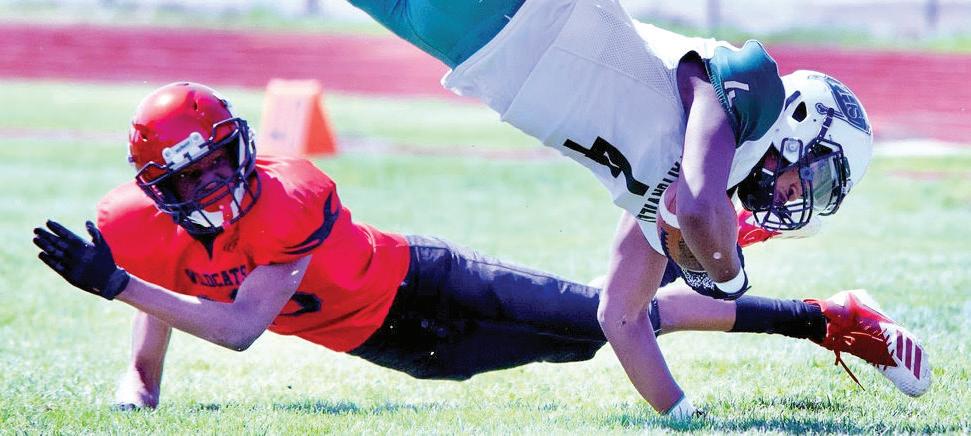





St. Louis Treasurer Tishaura Jones outraised Alderwoman Cara Spencer in the last month of campaign fundraising — reinforcing Spencer’s message of being the underdog in this unprecedented mayoral election and positioning Jones as the frontrunner.
In addition to those reports filed Monday, Spencer filed a separate report with 13 donations she failed to publicly disclose prior to the March 2 primary. Because they exceeded $250, her campaign was supposed to file supplemental reports with the Missouri Ethics Commission within 24 hours of receiving them.
n Between Jones’ campaign committee and PAC, the treasurer raised around $407,000 in just over a month.
Those 13 contributions include $2,600 from both Christine Taylor, CEO of Enterprise Holdings Inc., developer Pete Rothschild, and Natalie Hilfiker Roberts.
In the Nine PBC debate Tuesday night, Jones brought up this reporting violation and questioned Spencer’s transparency.
“It’s funny the alderwoman would bring up no big contracts and no transparency when she failed to report $13,000 in contributions to her own campaign,” Jones said during the debate. “So, if she can’t report that, then how do we trust her to spend $500 million?” Spencer responded to that, saying she reported everything she received.
“There was not a single contribution to my campaign that wasn’t reported,” Spencer said. “While there was a small hiccup in
See CAMPAIGN, A6
By Christine Byers, Sam Clancy
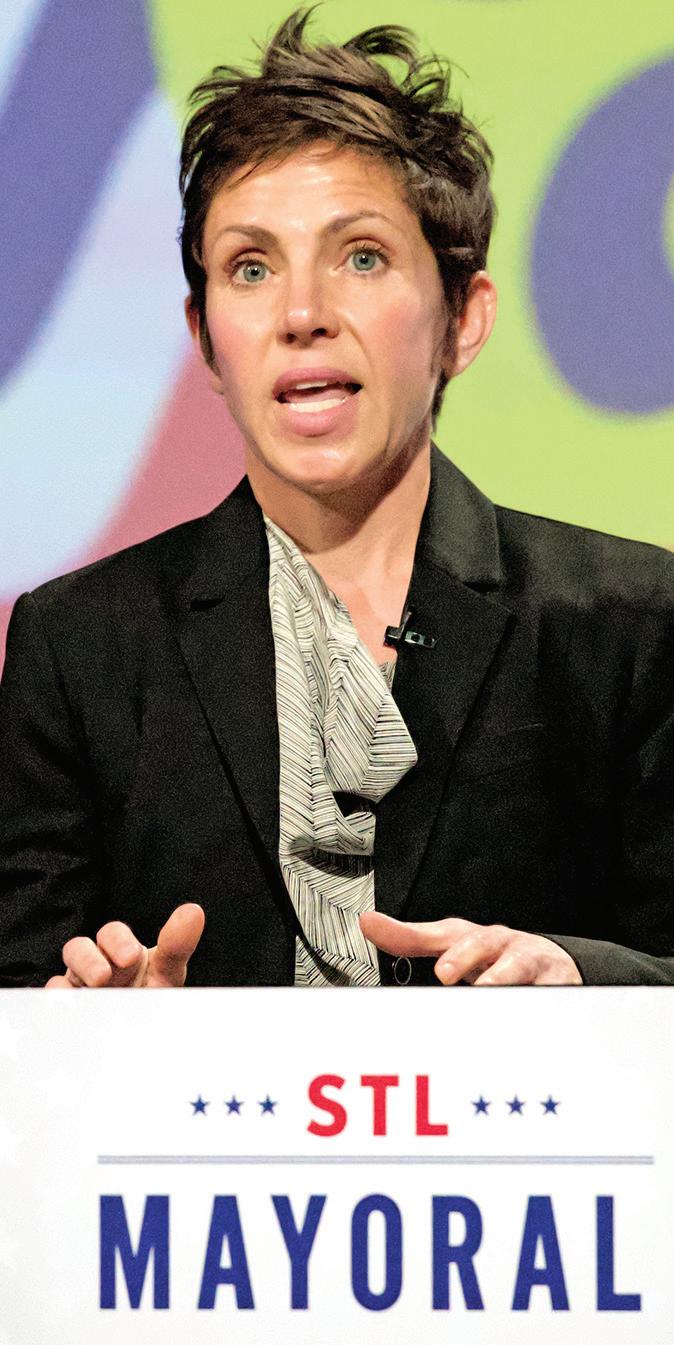
By Dana Rieck Of The St. Louis American
and Alderwoman Cara
on Tuesday evening took the stage at Nine PBS for the second and last televised debate between the two candidates prior to next week’s unprecedented election.
The debate, unlike last week, took a turn about halfway through when the candidates began a backand-forth regarding various criticisms of their campaigns and career track records.
Jones questioned Spencer’s transparency after her campaign committee failed to report around $13,000 in campaign contributions within 24 hours of receiving them prior to the March 2 primary election.
The 13 donations in question were received by the Spencer campaign after the cutoff date for the last pre-primary campaign finance report deadline, but the campaign was supposed to file them as supplemental reports within 24
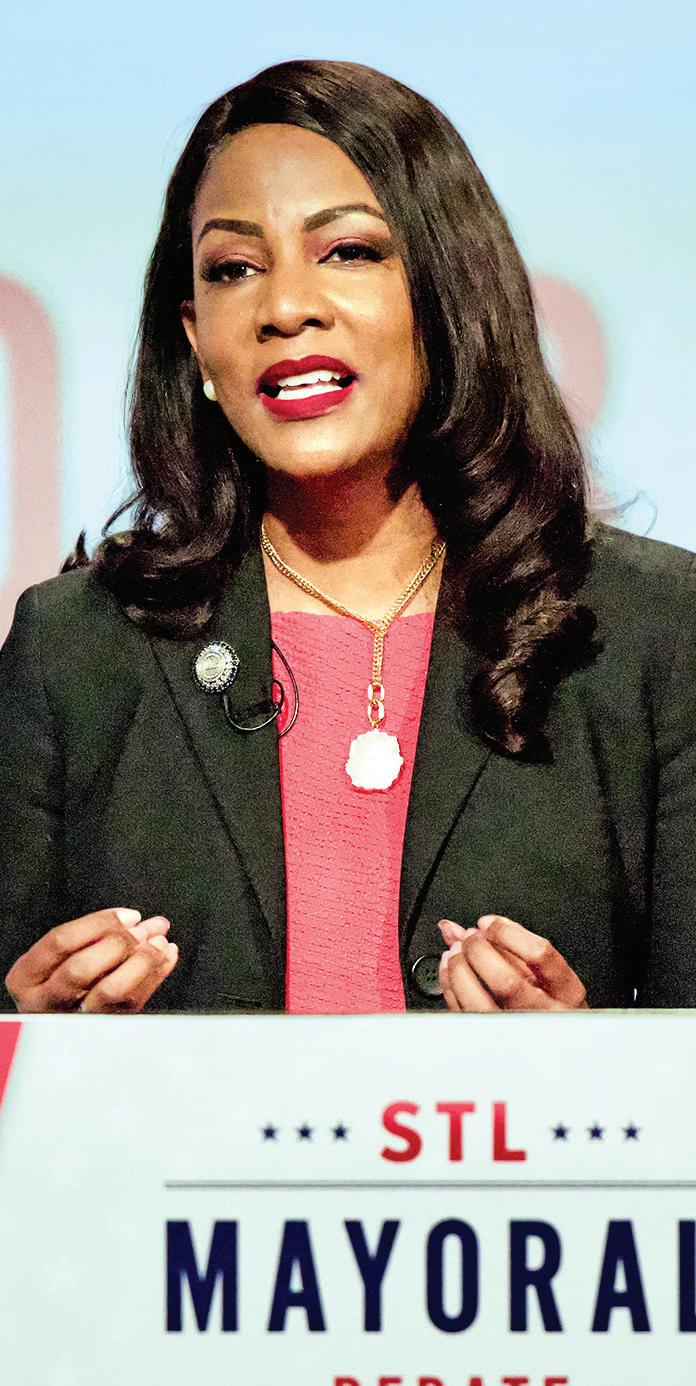
By Dana Rieck Of The St. Louis American



Pharrell’s cousin among those killed in Virginia Beach shootings
Music star Pharrell Williams revealed in an Instagram post that his cousin, Donovon Lynch, was one of the vic tims killed in the multiple shootings that occurred over the weekend on Virginia Beach’s Oceanfront.
“The loss of these lives is tragedy beyond measure. My cousin Donovon was killed during the shootings. He was a bright light and someone who always showed up for others,” The post read. “It is critical my family and the other victims’ fami lies get the transparency, honesty and justice they deserve. Virginia Beach is the epitome of hope and tenacity and, as a community, we will get through this and come out even stronger.”
WVBT Wavy News 10 reported that Lynch
was fatally wounded in an officerinvolved shooting on Friday, March 26.
“Bad Girls Club” alum Deshayla Harris was also killed in an unrelated shooting. Harris appeared in season 17 of the Oxygen Network reality television series. The weekend’s tragic gun violence left two dead and eight injured.

Boosie calls Zuckerberg racist after slap gets him scrapped from Instagram

Zuckerberg.
* In the tweet he writes, “zuck u just a racist.” Recently, behind-the-scenes footage surfaced of the visuals from his single “Period,” featuring DaBaby. In the video, Boosie is seen slapping a man who insults the rapper while inside a convenience store. It was later revealed that the man was paid $554 to endure the slap. Instagram erased the video and subsequently deleted Boosie’s Instagram account.
Boosie has since created a new Instagram account using his government name, Torence Hatch.
getting hard. My anxiety is higher than ever, and stream call me by your name on all platforms now!”
* The controversy continued when Lil Nas X collaborated with MSCHF Product Studio to release a pair of customized Nike Air Max 97s “Satan Shoes.” The sneakers featured a pentagram pendant, an inverted cross and a single drop of human blood in the soles to coincide with the release of the video.

Those who keep up with Baton Rouge rapper Boosie on his social media pages – Instagram specifically – are aware that he is notorious for posting content that may not always be deemed suitable for community standards. He claims Facebook CEO, Mark Zuckerberg – who heads the parent company of the photo sharing social app – is racist for deactivating his Instagram profile again. Boosie went to Twitter on Sunday to express his frustrations toward
Lil Nas X’s ‘Montero’ causes controversy, Nike files suit over ‘Satan shoes’
The visuals for Lil Nas X’s latest single “Montero (Call Me By Your Name)” set social media ablaze because of satanic references and imagery that does not conform to traditional gender norms. In the video, he is seen riding a stripper pole to the underworld – where he performs a lap dance for Satan.
“I’ll be honest, all this backlash is putting an emotional toll on me,” Lil Nas X said via Twitter. “I try to cover it with humor but it’s
MSCHF produced 666 pairs that were priced at $1,018. According to several outlets, the shoes sold out one minute after their Monday, March 29 release.
Nike has since announced they are suing MSCHF for trademark infringement.
“MSCHF and its unauthorized “Satan Shoes” are likely to cause confusion and dilution and create an erroneous association between MSCHF’s products and Nike,” the sportswear company said in a statement. “In the short time since the announcement of the Satan Shoes, Nike has suffered significant harm to its goodwill, including among consumers who believe that Nike is endorsing satanism.”
Sources: Wavy.com, TMZ.com, CNN.com, Complex.com, VladTV.com
*Spelling and grammar as it appeared in the original post.






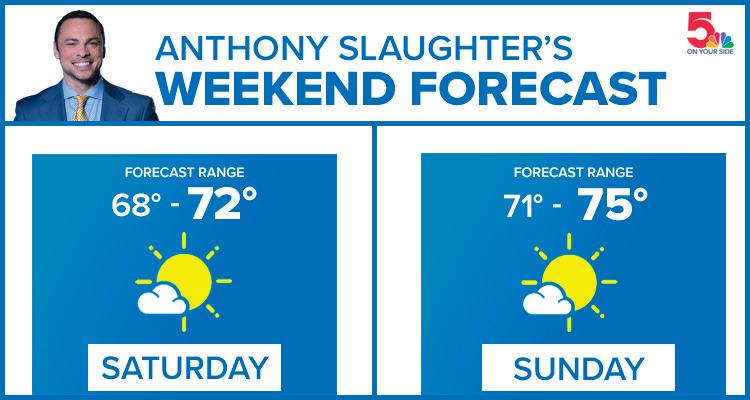











By Sophie Hurwitz
Louis American
Of The St.
On March 30, a group of North County community leaders held a press conference outside district headquarters demanding the resignation of Normandy Schools Collaborative Superintendent Marcus Robinson. They also called for the resignations of Sara Foster and Tony Neal, chairperson and vice-chairperson of the Joint Governing Executive Board, which appointed Robinson, and stated their opposition to two bond measures on the April 6th ballot in Normandy which would allocate increased funding to school building maintenance. Earlier this month, reporter Blythe Bernhard with the St. Louis Post-Dispatch revealed that Robinson, appointed to his position by the district’s Joint Executive Governing Board last May, did not hold the necessary qualifications for his position. Robinson, who is licensed to be a substitute teacher in the state of Missouri, is one of the three individuals who local leaders demanded to resign at the March 30th press conference.
Robinson, Foster, and Neal are not resigning, according to a statement released by the Normandy Schools Collaborative.
The press conference was organized by the Fannie Lou Hamer coalition, a group of local Black progressive politicians, along with the 24:1 Partnership of North County Mayors. County Councilwoman Hazel Erby, representing the Fannie Lou Hamer coalition, said that the group was involving themselves in this matter because “our responsibility is to create an appropriate and effective response to years of disparate treatment of African Americans in St. Louis county, especially our children.”
n Though academics have improved recently, Normandy still struggles — last academic year, its high school graduation rate was 69%.
According to a statement from the district, Normandy leaders “were well aware that Mr. Robinson would need to acquire his superintendent certification, which he will acquire in the coming months. We understand that in order to achieve full accreditation that certification is needed.”
“There seems to have been, at best, a dereliction of duty,” Erby said.
“How else could we understand the hiring of a superintendent who lacks the credentials to do the job?”
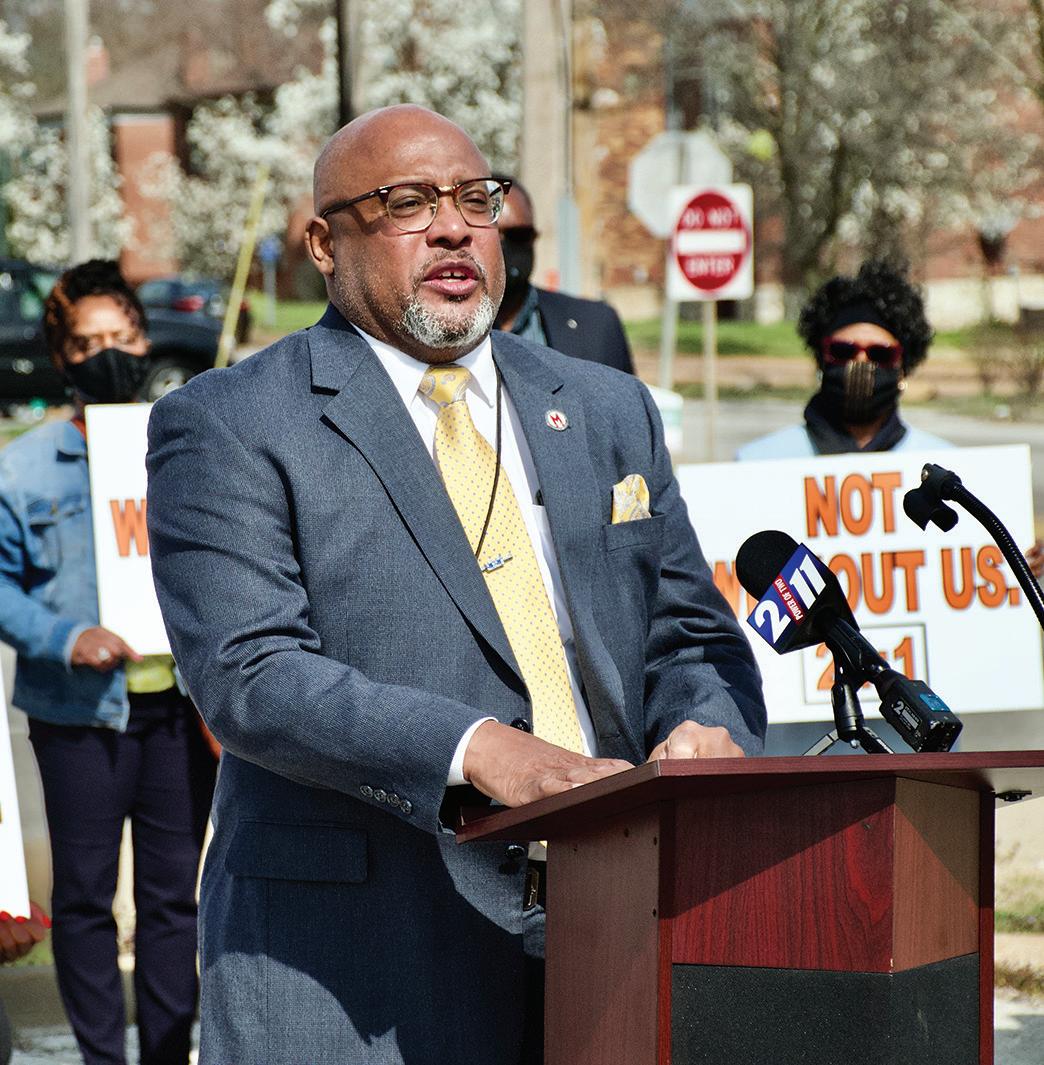
to benefit the school system. “I have lived in this school district since 1974,” she said. “I have never voted against a tax increase for anything that involves our children. I cannot continue to say that. With the lack of leadership that we have had in this school district…it does not warrant my support of any kind of tax increase.” Days and Erby both suggested that the end goal of Robinson’s hiring may have been to facilitate the conversion of more of the district to charter schools. The Leadership School, the first charter to open in the metro area outside the city of St. Louis, was approved to open in Normandy in late December 2020.
Robinson’s background is in charter schooling — prior to his position with Normandy, he co-founded The Opportunity Trust, the education innovation nonprofit that funded The Leadership School. The Opportunity Trust awarded $500,000 to the Normandy Schools Collaborative to support the district’s strategic plan in September. Robinson, however, states that he is no longer involved with the organization.
Normandy, which has been provisionally accredited since 2017, cannot receive full accreditation as a district without a certified superintendent. It lost its state accreditation in 2012, triggering a wave of student transfers and a loss of funding, which continued somewhat when the district was provisionally re-accredited in 2017. Though academics have improved recently, Normandy still struggles — last academic year, its high school graduation rate was 69%.
County Councilwoman Rita Heard Days connected the issue of Robinson’s hiring with the recent ballot initiative’s prioritization of building funding.
“The buildings are fine,” Days asserted. “But this bond issue is for buildings. It’s not for resources for our children, it’s not for greater compensation for our teachers. It’s not…anything that will improve test scores.” Proposition V and Proposition T, which are both on the April 6th ballot, are primarily focused on school
building improvements. Proposition V would be funded through a $26.5 million no-tax-rate-increase general obligations bond, meaning that property taxes for individuals in the area would not be increased.
Proposition T would be funded by increasing the operating tax levy ceiling in the district by 58 cents. Days stated that she opposes Propositions V and T, though she generally votes in favor of taxation
Mayor Brian Jackson of the City of Beverly Hills called for Robinson, Foster, and Neal’s removal, stating that “leadership has not been accountable to the community. The longer we wait, the longer it will take to get things repaired after the damage caused by this present administration.” None of those individuals, however, have indicated any interest in ceding to the coalition’s demands that they step down. In a joint statement to The American, Foster and Neal stated their intent to continue to serve on the Joint Executive Governing Board. “Both Tony Neal and Sara Foster intend to continue to serve on the Normandy Joint Executive Governing Board. We will continue to focus our efforts on providing a high quality education for the children in Normandy.”
Mayor / City of St. Louis
The City of St. Louis desperately needs an able, experienced reform leader who has broad support throughout the entire city, not someone aligned with those stuck in the past. We heartily endorse TREASURER TISHAURA JONES to be the next mayor of the City of St. Louis.
Comptroller / City of St. Louis
Comptroller Darlene Green has served honorably since 1995 as St. Louis’ Chief Fiscal Officer. Along with her strong fiscal stewardship, she has been an ardent supporter of women and minorities in public finance throughout her tenure. We are proud to endorse COMPTROLLER DARLENE GREEN for reelection as Comptroller for the City of St. Louis.
Board of Aldermen / City of St. Louis
Ward 1: Sharon Tyus
Ward 3: Brandon Bosley
Ward 5: James Page
Ward 7: Shedrick (Nato Caliph) Kelley
Ward 9: Dan Guenther
Ward 12: Bill Stephens
Ward 13: Anne Schweitzer
Ward 15: Megan Ellyia Green
Ward 17: Michelle Sherod
Ward 19: Marlene E. Davis
Ward 21: John Collins-Muhammad
Ward 27: Pamela Boyd
Board of Education / City of St. Louis
We urge you to vote for ALISHA SONNIER as a member of the Board of Education / City of St. Louis.
Proposition E / City of St. Louis
We can’t overemphasize how important support for the earnings tax is to the fiscal stability of the City of St. Louis. The onerous requirement for a vote every five years to continue this essential tax support was created by a statewide vote funded by conservative billionaire, Rex Sinquefield, in 2010. The measure forbade local earnings taxes statewide except in St. Louis and Kansas City, where they were already in place. The city’s earnings tax has provided major fund-
ing for basic city services since 1959, and the need for this funding has been heightened by the fiscal hit from the current pandemic.
Although voters approved continuation of the earnings tax in 2011 and 2016 by substantial margins, and there seems to be no organized opposition this year, passage cannot be taken for granted. The choice is clear. We need to vote YES FOR PROPOSITION E to keep this vital revenue stream that supports basic public services that are needed to avoid financial disaster for the City of St. Louis and it’s residents.
Mid County Fire District Board of Directors /
There has been little progress in improving diversity among the 43 fire districts and municipal departments in St. Louis County, largely because of structural barriers. Most significant is the requirement that all firefighters be trained at the nonprofit Greater St. Louis Fire Academy. This requirement has contributed to a de facto situation where 95 percent of all firefighters in the county are white males, because all outside applicants must be certified through the St. Louis Fire Academy. These firefighter jobs are well paid with generous benefits. They have essentially been controlled by the white firefighters union and white-dominated fire district boards.
A longtime resident of the district, Joseph Zenon, who lives in the home in Hillsdale that his family bought in 1967, is a candidate for the three-member Mid County Fire District Board of Directors. All but one of the firefighters in this district, which is 96 percent Black, are white. A business owner and a veteran, Mr. Zenon pledges to support greater inclusion at every level in the district, including firefighters, staff and vendors.
Importantly, he has been endorsed by all five Black mayors of the municipalities served by the district. He also has the support of County Councilwoman Rita H. Days, County Prosecutor Wesley Bell and the influential Ecumenical Leadership Council. He would join current board member Vaughn Rooks to form a Black majority that could dismantle the existing inequitable system. This district would be better served by a board committed to greater diversity and inclusion. We strongly support JOE ZENON for the Mid County Fire District Board of Directors.
By Mike Jones For The St. Louis American
The mayoral election this Tuesday April 6 will represent a paradigm shift for St Louis.
First, the winner will be a woman, the second woman in succession to be elected the mayor of St Louis, which will signal the end of two hundred years of patriarchal political dominance. Second, the possibility that the winner could be a Black woman is a stake in the heart of St. Louis’s political misogyny. Both candidates are under 50 years of age, this means whoever wins will represent a generational changing of the guard. I consider this long overdue and much needed in a region that prefers its leadership too old, too male and too white. I don’t consider this as a sign of civic enlightenment, but the surrender of an old, exhausted, out of touch, white patriarchal civic elite that’s no longer capable of defending their corners.
While Tuesday will be an opportunity for this emerging generation to celebrate a changing of the guard, this column isn’t meant to be celebratory, but a note of caution on what may await you as you turn this page in history. I would suggest that we currently live and will continue to live in for the foreseeable future, in arguably the most problematic, violable and dangerous time in the country’s history. If you combined the America of 1877 (end of Reconstruction, beginning of Jim Crow), the economic disruption of the Great Depression and the global challenges of a post WW2, you have an idea of the world that awaits the next Mayor of St. Louis. Add to that a city in steep historical decline, the St. Louis high water mark is 1950, and a region that would have to be described as stagnant at best when compared to the growth rate of the country at large. To
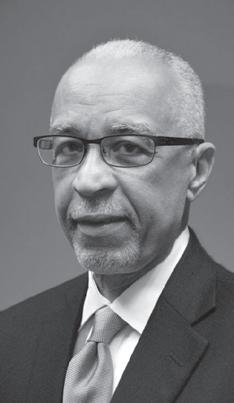
say the new mayor will not have been dealt a great hand is an understatement, but this mayor would have been dealt this hand before she was born. The environment and challenges confronting the new mayor will have nothing to do with political machinations, economic dislocations or the need for government reform. The turmoil we are currently experiencing is tied to the redefining of the social status of average white Americans. As social animals, human beings interactions and relationships with each other are a function of their social status. Social status is the level of value a person or group has relative to other individuals or groups in the society. Status hierarchies are universal across human societies, affording valuable benefits to those with higher status, such as better health, social approval, economic ressources, political influence, and freedom. There are two ways social status is conferred. One can earn their social status by their own achievements, which is known as achieved status. Alternatively, one can be placed in the stratification system by their inherited position, which is called ascribed status. Ascribed statuses can also be defined as those that are fixed for an individual at birth. This ascribed status is what it has always meant to be white in America.
For most of American history, racism and the social status of white privilege it conferred, worked for white people in America without causing them to abandon their fantasy of American Exceptionalism as a freedom loving democratic people. That’s because
Oscar H. Blayton For the St. Louis American
The American news media constantly reminds us that the false narrative by Donald Trump and his supporters claiming that Joe Biden did not fairly win the 2020 presidential election is “The Big Lie.” But The Biggest Lie, which much of the American news media continue to perpetuate, is “This is not who we are” whenever the notion of white supremacy produces a horrific act of violence or destruction.
There were those who said “This is not who we are” when neo-Nazis marched through Charlottesville, Va., with tiki torches, spewing vile racist and anti-Semitic chants.
There were those who said “This is not who we are” when armed white rioters stormed the Michigan state Capitol while white supremacists plotted to abduct and possibly execute that state’s governor.
There are those who continue to say “This is not who we are” each time another unarmed person of color is murdered by a police officer intoxicated by a militarist law enforcement culture.
And there were those who said “This is not who we are” when predominantly white insurrectionists invaded the U.S. Capitol to disrupt democracy in the United States by voiding the free and fair election of Joe Biden as the 46th President of this nation.
How much more murder, mayhem and raw hatred must be put on full display before Americans finally admit this IS who we are?
As much as America tries to sugarcoat its shameful history, the truth of our history has been written in indelible bloodstains over many centu-
ries and from sea to sea. Before America was even America, the extermination of Native Americans by Europeans settlers set the tone for the destruction of people and land in the name of civilization and progress.
This has always been a civilization backed up by lethal force, under the guise of law and order, that punishes and executes anyone who appears to be a threat to white supremacy. In the minds of many whites, because Black people were brought here to build and maintain a white Christian country, we are allowed to remain here for only as long as we serve their needs.
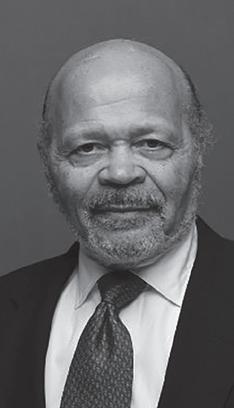
To claim that this characterization is far-fetched is to deny the bones of our ancestors at the bottom of the Atlantic Ocean and scattered across every inch of this land.
This nation was founded upon rape and murder and there are those who wish it to continue this way. The death of George Floyd speaks clearly to this point.
Every murdered innocent testifies to the fact that this is who we are. Every individual of the First Nations who dies for lack of proper health care testifies to the fact that this is who we are. Donald Trump could not have gotten away with locking children in cages if this despicable display of inhumanity was not cheered on by millions of supportive bigots. Franklin Roosevelt could not have gotten away with herding innocent and loyal Japanese Americans into con-
A call to young voters to vote on April 6
our officials and create the city we desire and care about.
centration camps without the tacit approval of the majority of Americans, including those of Italian and German ancestry.
There are many white Americans who know this country’s major problems are all about race. A large portion of America’s white people have a maniacal fear of people of color, who they deem to be “the other,” and who they believe want to deprive white people of what they have. But what does the poorest and least educated white person have besides his whiteness? Abandoned by the wealthy elitist of their race, these wretched of the earth are positioned as pawns, to barricade the doors to opportunity, against people of color. These loyalists of white supremacy diligently carry out their charge without realizing that the only way they can carry out this mission is to remain outside the doors themselves.
Many of the first Europeans who populated this land were from the prisons of England. There are estimates that approximately 10 percent of migrants to America between 1718 and 1775 were British convicts. The character of the American people is not so saintly as to warrant a blind faith in our goodness in the face of racial hatred and race-based violence and murder on display every day. Many Europeans who came to America’s shores were fine people, but the proof is in the pudding – and we need to put an end to the biggest lie and stop denying that this is who we are.
Oscar H. Blayton is a former Marine Corps combat pilot and human rights activist who practices law in Virginia.
All letters are edited for length and style.
as late as 1950 the country was overwhelming white (88%) and with a relatively small (10%) Black population. The Indigenous People had already been decimated by 300 years of genocide.
But all that has changed because of the 1965 Immigration and Naturalization Act. The 2020 census will find a country that’s 59% white and 41% people of color (POC). This makes it impossible to ascribe higher social value to white Americans and maintain the facade of a democratic society. And this demographic change has actually made America more democratic because more POC and women have increased their social value via achievement but that has also lessen the ascribed social value of average white men.
Think of it like this. America is legitimately proud of Jackie Robinson integrating baseball in 1947. And because of that we have seen the greatest players in the history of the sport compete against each other, Black, White and Latin, and baseball is better for Jackie Robinson. We never talk about how the white players who could have played in a segregated major league felt about the Black and Latin players who took their places because they were better players. They would say their inherent right to play major league baseball was taken from them.
This moment in America, whether it’s the Georgia or Missouri legislature, has nothing to do with public policy, inclusion or racial equity. This about the most primal of human instincts, dominance. This is about average white men fighting to maintain control over the bodies of POC and women. Don’t get it twisted.
The next mayor will have to manage her administration inside the context of this social reality.
If you have just turned 18, you don’t have to wait three more years to exercise your power to vote. St. Louis City elections are coming up on April 6th.
Although city elections do not get as much attention as our presidential elections, city elections have a bigger effect on our daily life. The sidewalks we play and bike on; our police and neighborhood safety; libraries and schools; maintenance of our parks and roads are under the control of our city government. Voting is a power to influence change—change you desire to see in your community. If you are 18 or older, enjoy casting your vote and encourage your parents to vote. Parents, encourage your younger children to come along to see you vote and your older children to volunteer at a polling place and/or to vote themselves. Let us take an active role to elect
Raj Jaladi St. Louis
We stand with our Black and Brown neighbors
No white St. Louisan experiences life exactly the same way their Black and Brown neighbors do. We know that statements that seem innocuous to some people can carry the weight of years of white supremacy, oppression, and economic disinvestment when others hear them. We have made missteps and are committed to continuing to listen and learn from our mistakes.
Reconciliation, which is the only viable path forward for our divided city, requires that we must understand the painful impact that some words have and, even if unintentionally, take responsibility, and commit to different behavior.
St. Louis City and East St. Louis have similar challenges and opportunities. Many of our shared struggles are rooted in some of the same reasons, including racism and white flight. We also can capitalize on opportunities together, including our culture, innovation, and advocating for all our residents who deserve to live well and thrive.
Anyone seeking to be Mayor of the City of St. Louis must have an understanding of where we are and how we got here. They must understand the critical importance of committing to represent all marginalized communities even when the going gets rough. Without it, any plan for moving forward risks starting from the wrong place or continuing in the wrong direction.
Christine Ingrassia
Annie Rice
Dan Guenther
Megan Green
Shane Cohn
St. Louis Alderpersons




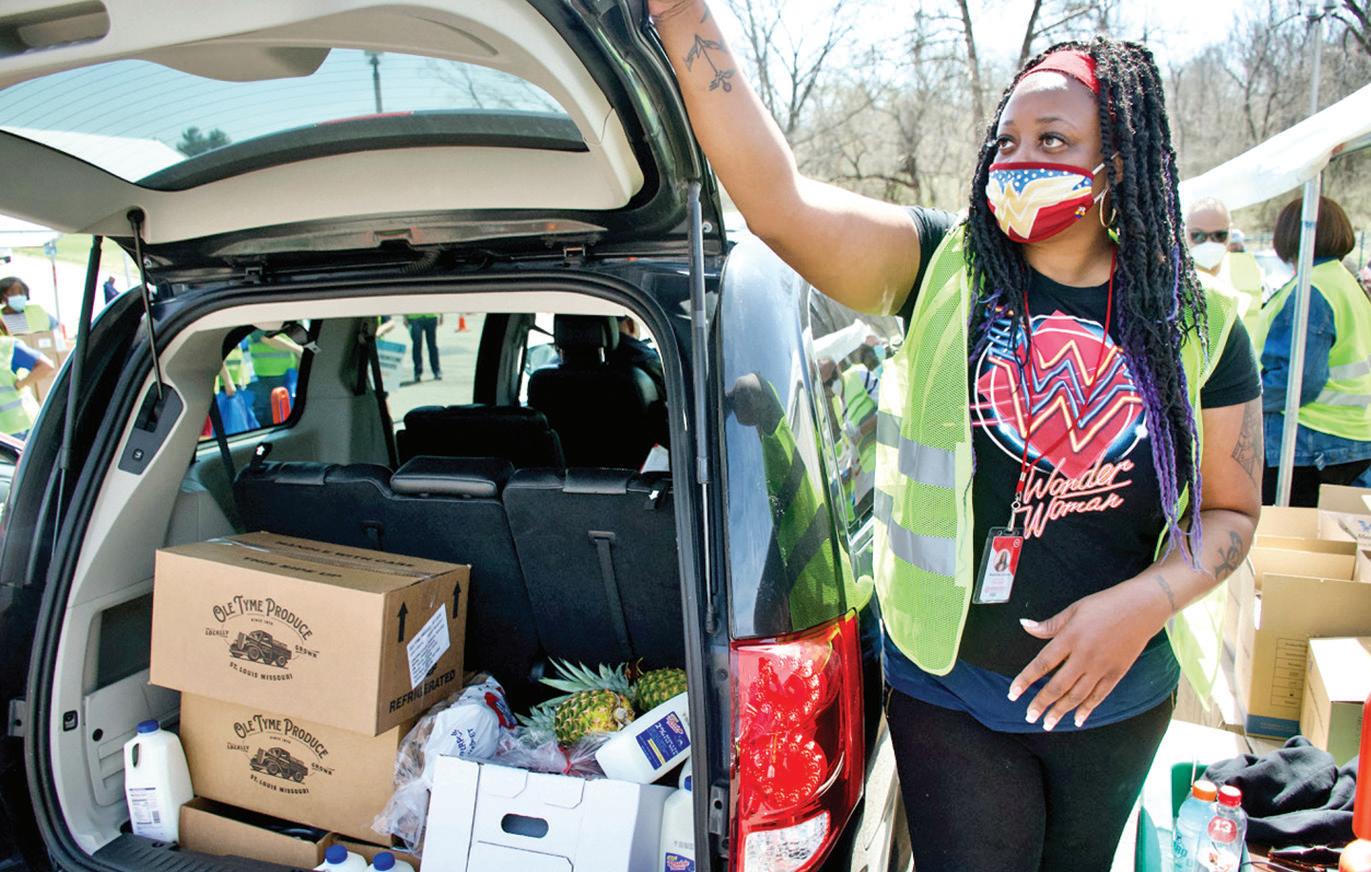
The St. Louis American Staff
David L. Steward, Founder and Chairman of World Wide Technology (the largest Blackowned corporation in the United States) has received the Boy Scouts of America National Duty to God Award. Steward was recognized for “exemplary, transformational leadership, faithful service, and selfless dedication to the advancement and support of Scouting founding moral principles and shared ideals.”
While serving on the St. Louis Council Board, including as its president, Steward significantly expanded Scouting for urban communities. Council staffing for urban outreach grew three-fold and the number of scouts from urban areas increased by double digits during Steward’s tenure. A STEM (Science, Technology, Engineering and Math) program led by Steward saw St. Louis area scouts win more awards than any other council in the country.
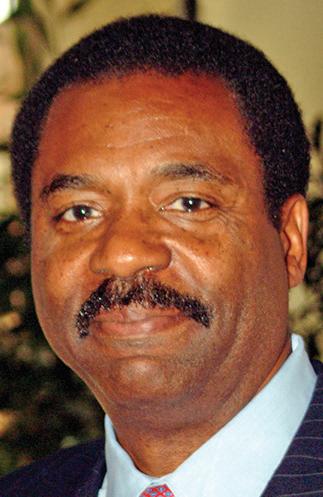
Green said, “Dave Steward, and his devoted wife Thelma, are gentle, genuine and inspirational leaders for scouting. They are personally involved in every aspect of the council. More, they promote collaboration with other youth and community organizations, always helping those who need help. Dave and Thelma do God’s work where it needs to be done.”
Steward said, “This is a very special moment for me. I am honored. To God be the glory. This award makes me think of my mother who watched me, as an eight-year-old, be rejected when I tried to join the Scouts because I did not look like them. She changed my life and that of thousands of others by forming the first integrated Boy Scout troop in Clinton, Mo. I am even more humbled that this award was approved the day before my mother’s passing. My mother always told her children, “you may be the only Bible someone sees today.” She was my role model, and I try to carry her spirit of service to God forward every day.”
The award was presented during a virtual ceremony that featured comments by Ronald S. Green, Scout Executive Emeritus of the Greater St. Louis Area Council.
The Greater St. Louis Area Council, third largest Boy Scout council in the United States, serves 63 counties in eastern Missouri and central and southern Illinois.

By Jamala Rogers For The St. Louis American
The voters of the City of St. Louis will have to make a huge decision on April 6. They will not just be electing a new mayor. They will also be hitting a reset button for a new direction for a city that’s been stumbling around in the dark for far too long.
The next mayor will inherit a violent, incorrigibly racist place that, if the current population loss continues, will become a big town instead of a city. When our funky laundry continually flaps in national media markets, it obscures the forward looking aspirations of most of the decent folks who live here.
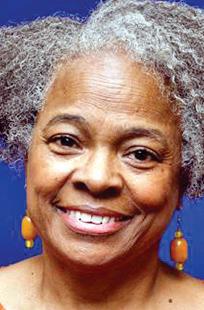
City Treasurer Tishaura Jones and 20th Ward Alderwoman Cara Spencer have both run campaigns with ostensibly progressive platforms. However, voters are looking beyond their campaign promises to other indicators. In Spencer’s case, Black voters have understandably serious reservations about at least two people in her inner circle of supporters.
The only African-American alderperson who has endorsed Spencer is Jeffrey Boyd. This poor fellow has received a sistah-girl whooping every time he’s gone up against Tishaura Jones in citywide contests. Each time, he crawls out of the ring, soundly defeated, but even more bitter and determined to bring her down. Yet he hasn’t been able to win even his own 22nd ward in those elections.
Voters in Boyd’s ward don’t believe he should get a promotion given his poor representation of his constituents’ concerns. Is that the same message 20th Ward voters sent to Cara Spencer? She failed to win her ward in the March primary. When one can’t win their own ward, that’s a resounding message, from those who know her best, for voters beyond her home ward.
Then there’s former Mayor Vince Schoemehl’s support for Spencer. Soon after his election, he earned the nickname “Shameless” in the Black community. In 1979, one of our crown jewels was closed and candidate Schoemehl promised to re-open Homer G. Phillips Hospital. The Black vote helped sweep him into office, but he promptly reneged on his campaign promise. His relationship with the Black community subsequently has gone downhill from there.
His contempt for Black folks didn’t stop there. It was under Schoemehl’s regime as head of Grand Arts Center that the St. Louis Black Rep was uprooted from its home after 20 years at Grandel Square Theater. The Black Rep, a premiere Black cultural institution, was erased from the so-called arts district. So much for diversity.
The point is that these two men, in particular, don’t represent anything positive or progressive. They reflect a neocolonial mindset that forward thinking people are striving to break from. We deserve political representation that is committed to building a better St. Louis for all, free of corruption and racial inequities.
Tishaura Jones’ campaign is not about symbolism. She understands fundamentally the historic marginalization of Black communities and the unbridled disrespect for Black lives in the region. She understands how structural racism chokes economic growth and stagnates social development. Many voters have faith that she is the best person to turn the situation around. St. Louis will forever have a stark racial divide and continued resident flight as long as the current status quo is deemed acceptable.
It’s time for change. Change on April 6. Real change beyond Election Day.
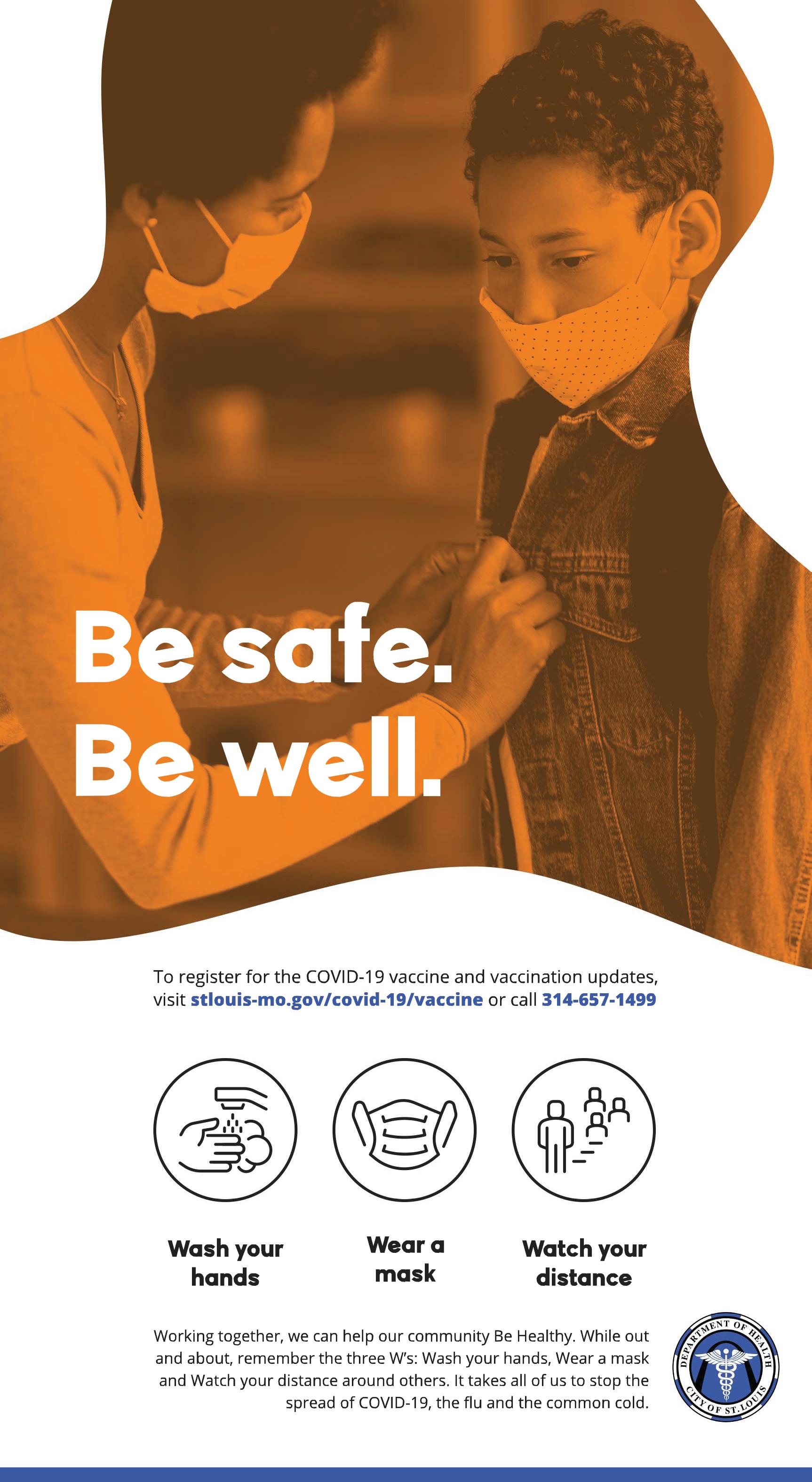
A judge said Korte was free to go, and Boone and Myers were released on bond.
Boone, Myers and Korte were all charged with depriving officer Luther Hall of his civil rights under the color of law, which carried a maximum sentence of 10 years. They were also charged with aiding and abetting in the commission of a crime.
Myers also faced a destruction of evidence charge, for allegedly intentionally destroying Hall’s phone to cover up evidence of the beating and hinder the investigation. And Korte was charged with lying to the FBI, for allegedly telling them he was not part of the arrest. The second and third counts all of the men were facing carried maximum penalties of 20 years in prison. All four counts carry a maximum fine of $250,000 Hall was in the courtroom Monday but left without answering questions from reporters.
The trial began with jury selection March 15, which was a great source of tension between prosecutors, the judge and defense attorneys.
Continued from A1 the time during which it was reported, under no circumstance did we fail to report a single issue.”
Media reports noted that state law prohibits complaints against a candidate within 15 days of an election.
Between Jones’ campaign committee and 314 Forward PAC, the treasurer raised around $407,000 in just over a month. As has been the case before, Jones received hundreds (in this case over 1,000) individual contributions to her

The three defendants are white. Hall is Black. Defense attorneys used their strikes to seat an all-white jury — a move prosecutors balked at saying this case has a racial component to it. Since then, one Black woman, who was among the pool of alternates, has been added to the jury after one of the original jurors had a personal emergency and was dismissed Tuesday.
Attorney Scott Rosenblum finished his closing argument Thursday and said his client didn’t think there was anything wrong with how Hall was arrested, so he had no way of knowing there would be an investigation for which he should destroy the phone. He
campaign committee — and over 90% of those were for $500 or less.
Between her campaign committee and Gateway to Progress PAC, Spencer raised just over $344,000 in the same time period. Similar to Jones, about 85% of Spencer’s contributions to her campaign committee were for $500 or less.
April’s mayoral ballot, for the first time, features two democratic candidates — making the April 6 election the most competitive mayoral election in St. Louis’ recent history. Contributions to a mayoral candidate are limited to $2,600, but PACs that make only independent expenditures may
also claimed Myers put Hall’s phone inside Hall’s backpack, when he could have thrown it in the sewer or kept it so no one could ever find it if he was really trying to destroy evidence.
Korte’s attorney, John Rogers, also finished his closing argument Thursday, saying his client was indicted about a year after the first four officers were accused and called the prosecution’s evidence against him “junk.”
Boone’s attorney Patrick Kilgore finished his closing arguments Friday and spent much of his time explaining the context around damaging text messages his client sent to his father and Hall following the assault.
accept unlimited contributions.
Below is a breakdown of the fundraising reported by both Spencer and Jones and their respective PACs from Feb. 19 through March 25.
St. Louis Treasurer
Tishaura Jones
Jones’ campaign committee received approximately 1,475 contributions of $500 or less each and approximately 124 contributions of over $500 each.
Those contributing $2,600 include A Better Missouri PAC; Reginald Blackwell, CEO of Players Management Group; Commerce Bancshares;
In one, Boone tried to apologize to Hall.
“When you see the apology text Boone sent to Hall, that’s not out of fear of being indicted or legal trouble, that is sincere,” Kilgore said. “And I understand Hall said he didn’t respond because he said he didn’t feel it was sincere, but that doesn’t mean it wasn’t sent without sincerity.”
Boone also texted his father, who is a retired officer, who said he had heard his son put a good “(expletive) whooping” on Hall.
“Yeah, it’s not one I’m proud of,” Boone responded.
Kilgore said the text was taken out of context.
“As the son of a police officer, it’s cop talk, it’s bravado,
Rodney Ellis, Harris County, Texas, Commissioner; Firefighters Institute for Racial Equality; Laborers Local 42; LIUNA Local 110; and Michael Neidorff, Centene CEP.
Her PAC, 314 Forward, raised $73,950 through 21 contributions. Five of those contributions were $500 or less each, and 16 were over $500 each.
Of that, $20,000 came from two PACs which previously supported Aldermanic President Lewis Reed in his bid to become the city’s next mayor. Another PAC who has supported Reed in the past, Nexus PAC, contributed $5,000.

Photos released as part of trial proceedings show Luther Hall’s injuries after the arrest on Sept. 17, 2017.
it’s juvenile, it’s immature, but it’s cop talk and it’s a coping mechanism,” Kilgore said. “You would be aghast if you would read texts between doctors, surgeons and just pick them out at any point in time.
“Do not accept this, do not take what government is offering you, which is, ‘Here are texts expressing his disdain for protesters,’ and say, ‘OK, he must have assaulted Hall because he was there. You can’t do that, that’s not what the law allows.”
Kilgore also said the photos and video evidence presented at trial show his client wasn’t near Hall during the assault.
He continued: “He’s not on trial for sending text messages. He is here because the govern-
Roy Pfautch, owner of Civic Services Inc. contributed just shy of $10,000 to 314 Forward. He also contributed to Spencer’s campaign committee.
Those who contributed $5,000 include Michael Staenberg (he also contributed $2,600 to Jones’ committee), president of TSG Properties; SEIU Missouri State Council; Andrew Taylor, Executive Chairman of Enterprise Holdings (he also contributed $2,600 to Jones’ committee); and Cochran Redevelopment Partners in Dallas, Texas.
Joe McKee, president of general contracting company Paric, contributed $2,500, and Thompson Coburn LLP contributed $2600. (they also contributed $2,600 to Jones’ committee).
Alderwoman Cara Spencer
Spencer’s campaign committee received approximately 605 contributions of $500 or less each and approximately 110 contributions of over $500 each.
Those contributing $2,600, include Roy Pfautch, owner of Civic Services Inc.; L.I.U.N.A. Local 110; Commerce Bancshares Inc.; Rodney Jones, Quadrant Properties; John Porta, Quadrant
ment has alleged he violated Hall’s civil rights.”
First Assistant U.S. Attorney Carrie Costantin got about 45 minutes for her rebuttal, in which she, too, seized on the text messages Boone, along with Myers, sent to various people before and after the event.
“He didn’t say, ‘I’m not proud of what THEY did,’ he said, ‘I’m not proud of what I did,’” Costantin said. She continued: “Text messages are how you get in someone’s head. Other officers were thinking, why do I have to be here? But Myers is having a good time. He says, ‘For some sick reason I live for this.’
“He’s pumped up about this. He’s excited about beating up protesters.”
She read another text Myers sent to a friend, which read: “I have been wanting to apologize to him because I feel bad. We obviously didn’t know he was a cop.”
“He didn’t want to beat up a policeman,” Costantin said. “It was going to be OK to beat up a protester, but it wasn’t OK to be up a policeman.” The jury began its deliberations at about 10:30 a.m. Friday.
Communities developer; Anna Tegethoff and Jeff Tegethoff, Tegethoff Development; Greg Brentano, South City Hospital CEO.
Spencer’s PAC, Gateway to Progress, raised $66,5000 through 18 contributions. Three of those contributions were $500 or less each, and 15 were over $500 each. Spencer’s largest PAC contributor was Post Holdings Inc., who contributed $10,000. International Association of FireFighters Local #73 contributed $7,400 after publicly endorsing Spencer for mayor, and another $2,600 to her campaign committee. Six contributions to Gateway to Progress were for $5,000 each. Those contributors include Todd Schnuck, CEO and Chairmen of Schnuck Markets; James Holloran, a retired attorney; Hermann Capital Management; Holland Law Firm LLC; Eric D. Holland, an attorney at Holland Law Firm; and Barbara Taylor. Jerry Schlichter, of Schlichter Bogard & Denton, LLP, contributed $4,800. Both Thompson Coburn LLP and David Kemper, of Commerce Bank, contributed $2,400 each. Robert L Devereux, attorney, contributed $2,00- and Brown & Croupon contributed $2,500.

Continued from A1
hours of receiving the money.
Instead, Spencer disclosed those contributions on Monday in the last financial report due to the Missouri Ethics Commission before the April 6 election.
Spencer then criticized Jones for giving a $7 million parking contract to a company which has contributed to her campaign, without a single bid or proposal attached to the contract. Spencer also asserted that 65% of all Jones’ contracts had no bids or proposals attached to them.
“We need transparency in city government,” Spencer said, saying that while it’s not required, Jones should be holding open bidding for city contracts.
“There’s nothing nefarious about this contract, we saved the city $5 million with this contract,” Jones said.
They also took shots at each other about receiving campaign money from major political players in the region.
Jones criticized Spencer for accepting money from the city firefighters union after Spencer voted in favor for a pension governance change.
The treasurer was referring to the International Association of FireFighters Local #73, which contributed $10,000 to Spencer’s mayoral bid.
Jones said the bill Spencer voted for would have increased pension costs, ruined the city’s credit rating and “would have been detrimental to” the city’s budget. Mayor Lyda Krewson vetoed the bill.
Spencer defended receiving

their financial support, saying she supports the city’s first responders.
The alderwoman went on to assert that Jones received campaign money from all of “the old cronies whose names we know” who are trying to privatize Lambert Airport — mentioning Joe McKee, president of Paric Corp. and Jeff Rainford, who worked as an aid for Mayor Francis Slay. Also unlike last week’s debate, Tuesday’s discussion touched on the race of each candidate.
The treasurer and alderwoman were asked why they were the most qualified to address the city’s deep racial disparities
and whether a white mayor can successfully do so.
Jones noted that St. Louis is one of the most segregated cities in the nation.
“I have grown up unapologetically Black all of my life in St. Louis,” Jones said, adding she’s watched the intentional disinvestment in certain areas of the city over the years.
“It’s time to turn the tide,” Jones said.
Jones said while she appreciates white allies, she does not believe they can understand the lived experiences of Black people and people of color — making her the best candidate to address these inequities.
“We have had white may-
Continued from A1 irresponsible and significantly impact our ability to provide essential services to our constituents. I am going to do everything possible to make sure that doesn’t happen,” Krewson wrote in a statement. Krewson and Daly established a political action committee last month in an effort to pass the earnings tax proposition. Both of their respective campaign committees have each contributed $50,000 to the PAC since. Another $25,000 was contributed by the Civic Progress Action Committee, which is now part of Greater St. Louis, Inc. “The economic uncertainty created by the COVID-19 pandemic underscores exactly why the earnings tax must continue to be protected. I look forward to working with Mayor

ors that have been allies and white people who have been allies — but I don’t think white people can understand the lived experiences of Black people,” Jones said.
If elected, Jones would be the first Black woman to hold the office of mayor in St. Louis.
Spencer said St. Louisans all have very different lived experiences and the city has a role in breaking that down.
“I acknowledge as a white person I don’t understand the lived experiences of communities of color,” she said, noting that rather she can talk about her role as an alderwoman representing a diverse area of the city.
Krewson to educate voters about the benefits of retaining the City’s earnings tax,” Daly wrote in a statement.
Both candidates in the mayoral election, St. Louis Treasurer Tishaura Jones and Alderwoman Cara Spencer, Ward 20, are in support of the earnings tax.
“As your next mayor I will use data to address a very different delivery of services,” she said.
Spencer said she understands that communities of color are filled with skepticism when it comes to white politicians — and with just cause.
“Skepticism that is born out of real, lived experience. It is my job as an elected official to break that down – not with words but with actions,” Spencer said.
When it came to crime, Spencer once again touted her 10-step plan to address crime, starting with the program of focused deterrence.
Spencer said she projects her crime plan would bring down the city’s homicide rate by 30% in her first term.
Jones said that immediately the city needs to declare gun violence as a public crisis and said she’s been talking about using social workers and focused deterrence since the last time she ran for mayor in 2017.
Jones said she will measure her success on reduced gun crimes, increased trust and satisfaction of residents. But the number one measure would be the decrease in number of police-involved shootings.
When asked about the spy plane bill considered by the Board of Aldermen, both candidates said they opposed the bill and would consult with the ACLU and other civil liberties organizations to protect residents’ privacy when it comes to government security cameras around the city.
Other issues addressed were the federal stimulus headed to the city in May, education, city development, and merging with the county.
April’s mayoral ballot, for the first time, features two democratic candidates — making the April 6 election the most competitive mayoral election in St. Louis’ recent history.
The St. Louis American, Nine PBS, 5 On Your Side, and St. Louis Public Radio partnered to host the live debate.
Moderating the debate were 5 On Your Side political editor Casey Nolen, St. Louis Public Radio’s political reporter Rachel Lippman and Nine PBS’s senior producer Ruth Ezell. In addition to the questions by moderators, the public was given the chance to submit questions online.
The earnings tax appears on the ballot every five years in both St. Louis and Kansas City because of a Missouri ballot measure passed in 2010, in part because of millions donated to the measure’s effort by billionaire philanthropist and political megadonor Rex Sinquefield. Sinquefield has been a longtime critic of this tax and other taxes, asserting they stifle economic growth. Since 2010, the measure has been presented to St. Louis voters twice. In 2016, just over 72% of voters voted in favor of keeping the earnings tax, and in 2011 it passed with 87% of voters’ support.

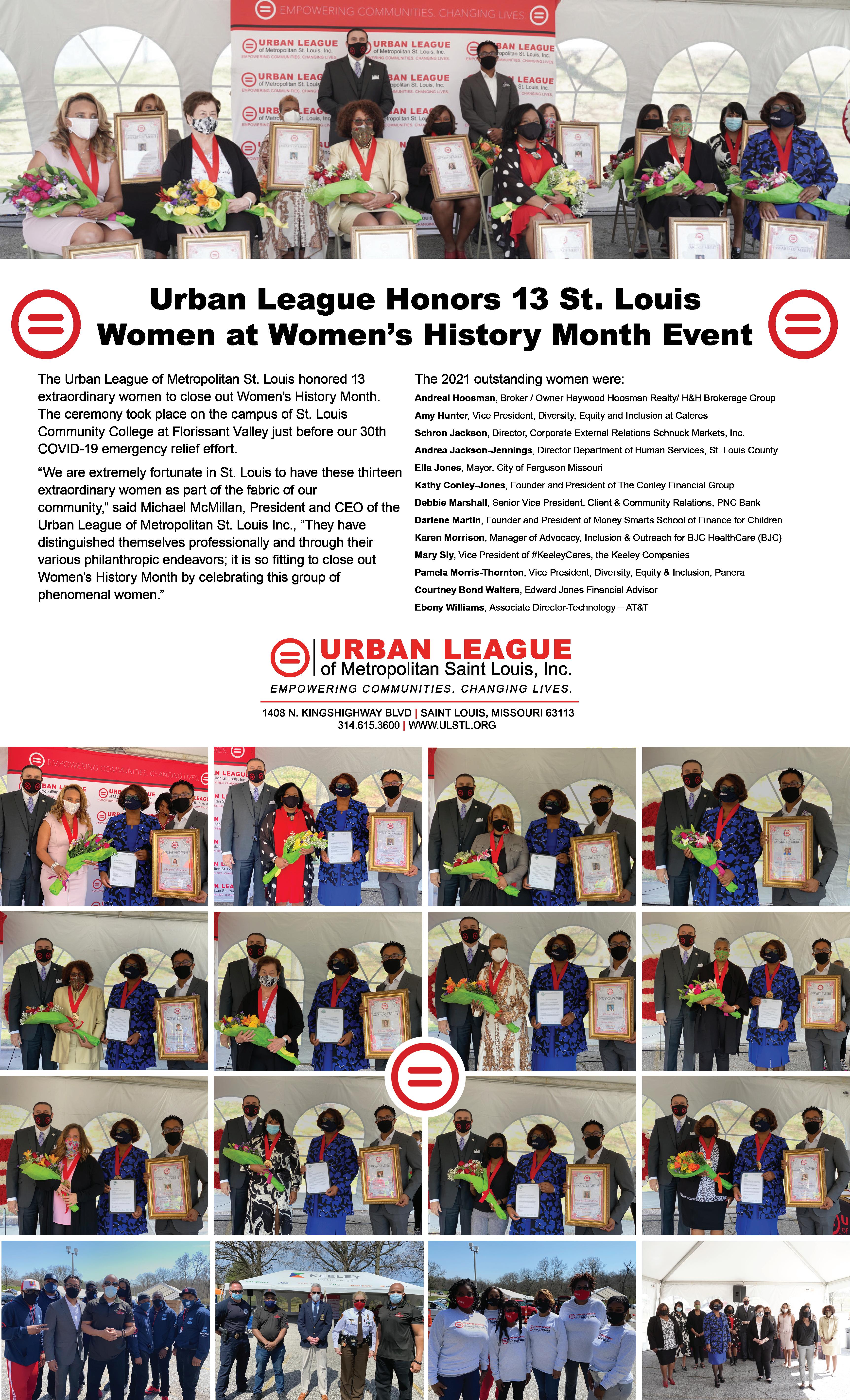

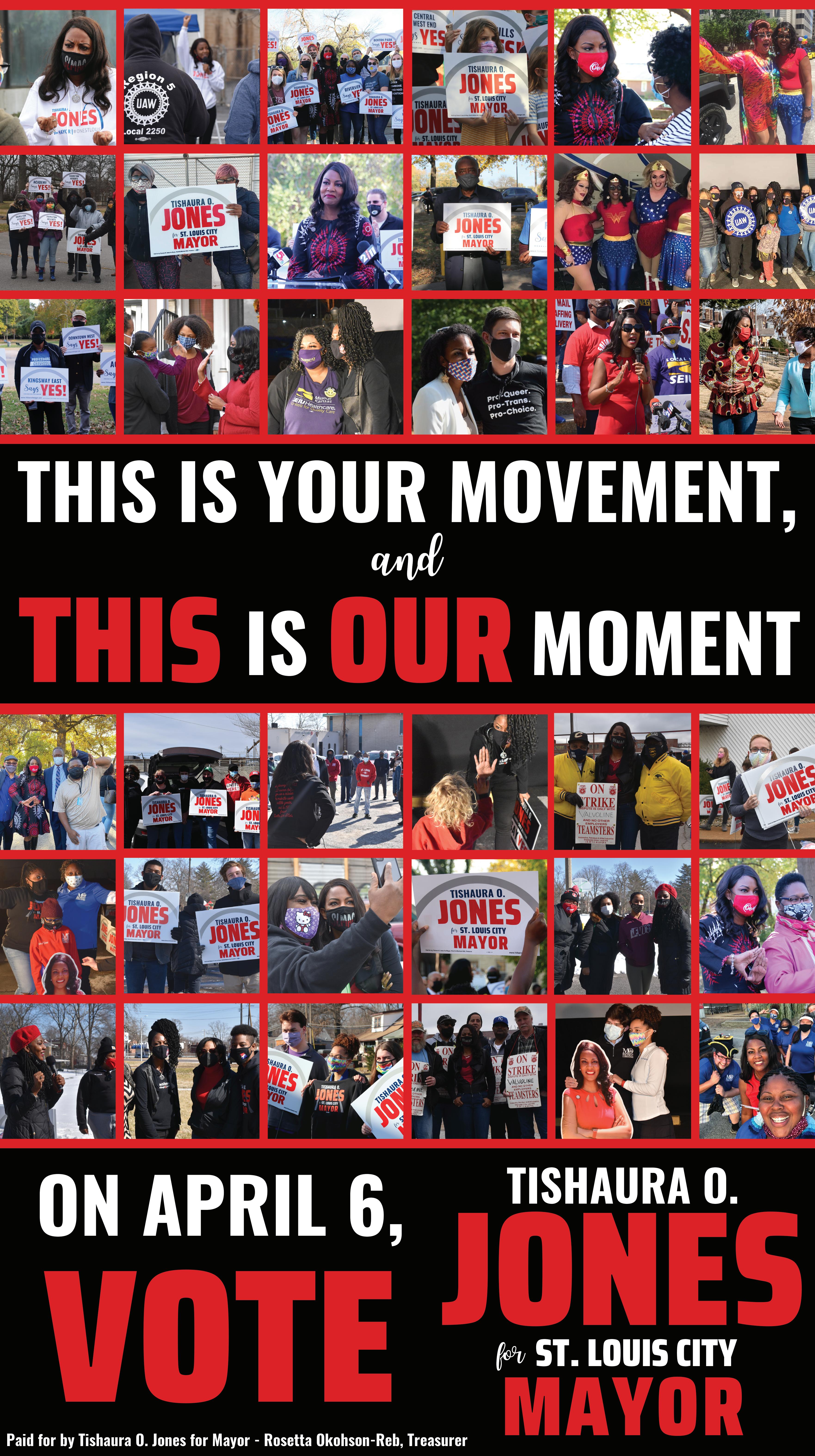
During a February confirmation hearing for Adewale Adeyemo, nominated by President Biden to become Deputy Treasury Secretary, the nominee said, “Until we contain the pandemic, economic policy must remain focused on providing relief to those harmed by the public health crisis, especially those disproportionately impacted: low-income communities and communities of color.
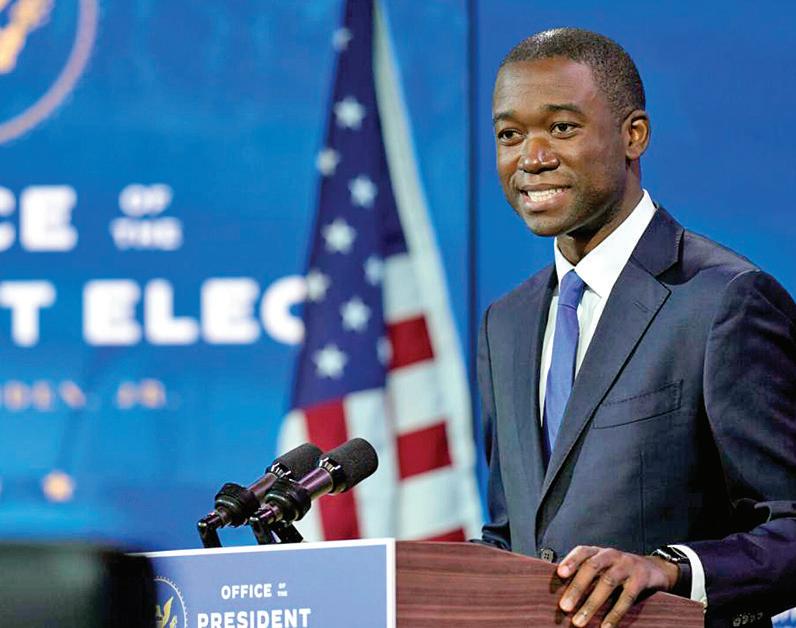
By Charlene Crowell
Over the past year, the COVID-19 pandemic has imposed dual crises.
Over 542,000 Americans lives were lost and continue to increase. At the same time, the rippling effects of a massive economic downturn has caused the nation to lose 9.5 million jobs - more losses than even those of the Great Recession, finds the University of New Hampshire’s Carsey School of Public Policy.
Although many officials have called for a ‘return to normal’, millions of small businesses and communities need something new instead. In Black America especially, the ‘old normal’ never delivered equitable access to wealth-building opportunities as those that well-served much of white America. Instead, a lengthy history of public policies designed to create and sustain a burgeoning middle class systemically excluded Blacks and other people of color.
Now, while federal lawmakers seek to understand how best to bring the nation out of health and financial crises, many advocates are calling for a new paradigm: intentional inclusion of all who have been shut out, knocked down and underserved. Recent testimony before Capitol Hill committees focused on different issues but led to the same conclusion: the time for change is now.
by the public health crisis, especially those disproportionately impacted: low-income communities and communities of color. The pandemic has exacerbated inequality, strained families, and exposed disparities in opportunity throughout our country that existed long before COVID-19. Without additional relief, this hardship will become even more acute and will inflict long-lasting pain on countless Americans.”

At press time, the Senate was set to act on the Adeyemo nomination. If confirmed, he would become the agency’s point-person to implement the executive order requiring all federal offices to submit diversity and inclusion plans to the office of Management and Budget. In the interim, Treasury Secretary Janet Yellen, as reported by the New York Times, announced plans to invest $9 billion into Community Development Financial Institutions and Minority Depository Institutions as they look to step up lending.
Concurrently, the U.S. House of Representatives’ Financial Services Committee has convened multiple hearings that featured expert witness testimony echoing the calls of Mr. Adeyemo.
On March 10 the full committee held a hearing entitled, Justice for All: Achieving Racial Equity Through Fair Access to Housing and Financial Services
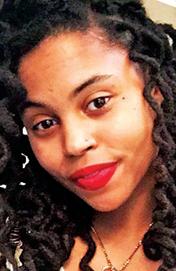
Loren Cahill joins Smith College in Northampton, MA as one of its newest tenure track assistant professors. She is focusing her doctoral work on “Critical Social Personality Environmental Psychology,” identifying and understanding institutional and informal spaces of strength, resilience and thriving for Black women and girls. Cahill is a graduate of Rosati-Kain High School and the youngest daughter of St Louis Attorney Randall Cahill.
Pittman took the oath of office

For example, comments during a February confirmation hearing for Adewale Adeyemo, nominated by President Biden to become Deputy Treasury Secretary, the nominee said, “Until we contain the pandemic, economic policy must remain focused on providing relief to those harmed
Rep. Maxine Waters, a California Congresswoman and committee chair’s opening remarks set the tone of the forum.
“Today we are here to discuss steps that this Committee can take to
Will be inaugurated April 9th in virtual ceremony
By Malena Amusa For The St. Louis American
Dr. Corey S. Bradford, Sr., a St. Louis native and the President of Harris-Stowe State University (HSSU), will be inaugurated as the 20th President of the University on April 9, 2021 in a virtual ceremony that will be live-streamed on HarrisStowe’s website at 10 a.m.
Dr. Bradford began his tenure at Harris-Stowe on May 1, 2020, during the COVID-19 global pandemic.
“I am honored to build on the great heritage of Harris-Stowe and help steer the University in a new direction,” Bradford said. “Despite the challenges we face, we will redefine our future in a way that brings pride and that unapologetically bridges our scholars to success. Our time is now. This is our season.” At the inauguration, Dr. Bradford will be joined by campus representatives and several local, state, and national officials and dignitaries, including Missouri Governor Mike Parson; Cori Bush,
U.S. House Representative of Missouri (District 1); Atty. Ronald A. Norwood, Chairman of the HSSU Board of Regents; Steven Roberts Jr., Missouri State Senator (District 5); LaKeySha Bosley, Missouri House of Representatives (District 79); and Atty. Zora Mulligan, Commissioner of the Missouri Department of Higher Education.
Keynote Speaker Dr. Ruth J. Simmons, the President of Prairie View A&M University in Texas, will also be in attendance to give remarks, followed by a speech from Dr. Bradford in which he will share the cornerstones of his transformational vision and plan for the University.
“Harris-Stowe is the only Historically Black College and University, and public four-year institution of higher education in the City of St. Louis,” Bradford said. “My aim is to continue to leverage our position to recruit and retain diverse scholars, support our faculty and academic programs, and
See BRADFORD, A12
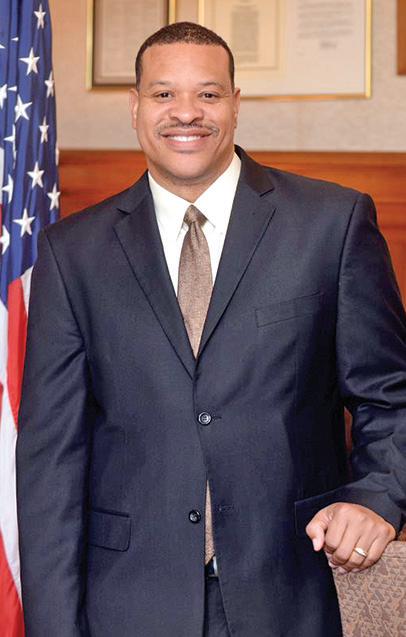
Dr. Corey S. Bradford, Sr. will be installed as the 20th president of
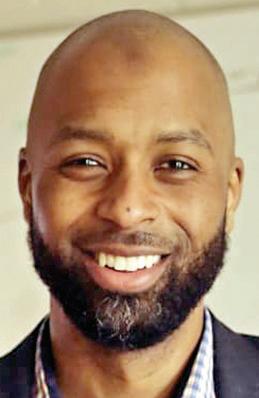
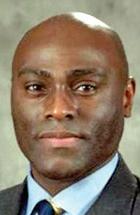


create justice and achieve racial equity through access to fair housing and financial services...And no matter where you are—and who you are—in America or around the world, institutional racism based on skin color creates barriers that impact social and economic outcomes,” noted Ms. Waters. Testifying on behalf of the Center for Responsible Lending, Nikitra Bailey, Executive Vice President recounted the legacy of federal housing policies whose sum created today’s financial inequities.
A 1933 federal housing program, the Home Owners Loan Corporation (HOLC), supported redlining through its underwriting guidelines. As a result, Black and other communities of color, were denied access to mainstream financing. During the first 35 years of this program, only 2% of FHA insured mortgage loans went to Black and other homebuyers of color.
Similarly, the 1944 GI Bill, continued the same systemic discrimination. In Mississippi, for example, the 3,329 VA -approved mortgages included two Black servicemembers.
Fast forward to more recent times, by the early 2000s, half of all mortgages made to Black and Latino families during the run-up to the foreclosure crisis were unsustainable subprime loans—despite these consumers having credit records that qualified for cheaper, safer and more responsible loans.
“Because of these lending practices,” testified Bailey, “Black and Latino families lost over $1 trillion dollars in wealth during the crisis. Moreover, Black homeownership has been the slowest to recover from the Great Recession. In fact, there would be 770,000 more Black homeowners if the homeownership rate recovered to its pre-crisis level in 2000… The racial wealth gap contributes to the fact that in the 46 largest housing markets in the country, a median income Black household could only afford 25 percent of homes on the market last year in comparison to the 57 percent that a median income white household could afford. It will require focused
Continued from A11 provide our scholars remarkable pathways to in-demand careers. During my tenure, the positive impact on our city and region will be evident.”
From humble beginnings to proven leadership
Since becoming President of Harris-Stowe, Dr. Bradford has been a strong proponent of student success and invites people to come and witness the HarrisStowe “magic” themselves.
“That magic is the ability to turn your struggle into a positive opportunity,” he said. “And that magic is something I share with many of our student scholars here at Harris-Stowe.”
Born to teenage parents in St. Louis, Bradford encountered many life challenges earlier than most children. Despite this, however, his parents instilled within him a belief that he could achieve anything he set his mind to. Bradford happened to be born on his mother’s
and bold action to reverse these inequities.”
The following day, a subcommittee of House Financial Services convened yet another hearing. Entitled, “Slipping through the Cracks: Policy Options to Help America’s Consumers during the Pandemic,” the session spanned access to affordable credit or small business capital, debt collection, and stained credit all became inevitable and further complicated the financial disadvantages faced by communities of color.
“Without a safety net or a cushion to fall back on, people of color are far less able to weather financial calamities,” testified Carla Sanchez Adams, Managing Attorney with Texas Rio Grande Legal Aid, Inc. “With fewer assets to draw on, people of color are more prone to poverty traps.”
“Debt collection activities increased in 2020,” continued Sanchez Adams, “as did profits for debt collectors. Auto repossessions were prevalent, and consumers were left at the mercy of their lenders. Consumers would benefit if all debt activity ceased during the pandemic. The problems with our credit reporting system continued and revealed the need for reform around what consumer information is reported and how it is reported during a pandemic...Consumers would benefit from a moratorium on the negative reporting of unpaid debt during the pandemic. Scams and fraud also surged.”
Speaking on behalf of minority lenders and small businesses, Robert James, president of Carter Development CDE and chair of the National Bankers Association, emphasized the importance of minority-owned small businesses, the lack of convenient access to mainstream banking as well as the dwindling number of minority depository institutions as issues demanding attention and correction.
“Minority-owned small businesses are the lifeblood of their communities,” testified James. “The pre-pandemic 1.1 million minority-owned small businesses employed more than 8.7 million workers and annually generated more than $1 trillion in economic output. Women own nearly 300,000 of them, employing 2.4 million
birthday and will never forget the day she told him that “I was her greatest gift,” he said. Bradford’s father was a proud Marine and war veteran who provided a constant example of leading with dignity and honor.
At the same time, his grandmother and aunt helped to raise him, nurturing Bradford in a way that gave him the courage to chase his dreams. At the age of 14, Bradford entered the Academy of Math & Science High School and discovered his love of math. He ranked among the top 20 in his high school class and played baseball and basketball for four years.
Following his passion, Bradford left St. Louis to pursue a Bachelor’s Degree in Mathematics from Southern Illinois University - Edwardsville (SIUE), and later, a Master’s Degree in Applied Mathematics and Statistics from SIUE as well.
In 2008, Bradford earned his Ph.D. in Higher Education Administration from Southern Illinois University - Carbondale and an educational certificate from the Harvard University - Institute for Management

workers. Despite their significance, these businesses face underlying challenges that make them vulnerable during normal times.”
“Black-owned businesses, overall, also tend to start out with far less capital, whether from investments or bank loans, than white-owned businesses do,” continued Carter. “And only 1 percent of black business owners get a bank loan in their first year of business, compared with 7 percent of white business owners. The COVID-19 crisis has compounded this issue: 42 percent of minority-owned small businesses responding to McKinsey’s US Small Business Pulse Survey reported that obtaining credit was becoming increasingly difficult, compared with 29 percent of all respondents.”
But credit terms and a pronounced shortage of accessible credit, according to Carter, are equally lending conditions that must become more inclusive.
“Limited access to credit is a compounding factor that hurts the underlying health of minority-owned small businesses,” said Carter.
“Research has found that black small-business owners were significantly more likely to be asked to provide more information about their personal financials—including personal financial statements and personal W-2 forms—when applying for small-business loans than white small-business owners were, even when controlling for credit score and business characteristics.”
At the same time, as noted by Carter, from 2009 to the second quarter of 2018, nationally, the number of Minority Depository Institutions (MDIs) dropped from 215 to 155. MDIs are also much smaller in assets than the average non-MDI bank.
“Black and Hispanic MDIs have average assets of $245 million and $2.7 billion, respectively,” said Carter, “compared to an average of $3.1 billion for all US banks.”
Charlene Crowell is a senior fellow with the Center for Responsible Lending. She can be reached at Charlene. crowell@responsiblelending. org
Development.
With a knack for numbers and a love of people, Bradford embarked on a 27-year career in finance and education that allowed him to break ground in his field.
In 1995, he was hired by the Southern Illinois University (SIU) System as a budget officer, eventually becoming the Assistant Vice President for Financial and Administrative Affairs. During his time with the SIU system, Bradford played a key role in securing $3 billion in state appropriations.
After SIU, Bradford joined Prairie View A&M University in Texas where he served as the Senior Vice President for Business Affairs.
A homecoming and calling
When the opportunity arose to lead Harris-Stowe, Bradford felt it was a divine and historic homecoming and calling.
“Coming back to St. Louis has allowed me to reconnect with my family and friends, and join the dedicated HarrisStowe family to embark on this historic transition,” Bradford said.
Reflecting on his new chapter, Bradford also shared gratitude for the many people who have helped him to reach this point in his life.
“They have allowed me to proudly serve the St. Louis community and the state of Missouri as the 20th President of Harris-Stowe State University,” he said. One of those people is his wife of 27 years, Dr. Josette Bradford. “My journey would not have been possible without her,” said Bradford, a doting husband and father of two adult twins. “She is the rock of our family.”
To watch the livestreamed Presidential Inauguration on Friday, April 9, 2021 at 10 a.m. CST, please visit www. hssu.edu/inauguration

By James T. Ingram
For the St. Louis American
Back in the day the old “In Living Color” TV show skit
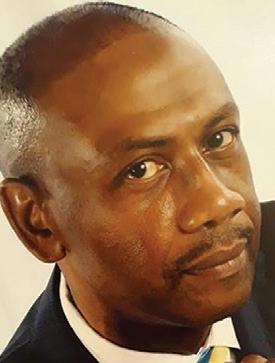
“Hey Mon” took a comical take on the antics of the Hedley family, described as the “hardest working West Indian family.” The skits poked fun at their working multiple jobs and considering anyone who didn’t as being lazy. It was one of their most hilarious signature bits.
What isn’t so funny is the omnipresent state of patronage hook-ups and phantom political patronage jobs in the state of Illinois.
Former IL House Speaker Michael Madigan was ousted and, ultimately, resigned his coveted position, after 36 years, due to an investigation into his political cronies receiving $1.3 million in no-work jobs and contacts from Illinois utility giant Commonwealth Edison.
So, you would think that after the fall of the once allpowerful godfather of IL “politricks” that IL politicians would be a bit more reluctant to accept such hook-ups; at least not so blatantly.
Well, think again and look no further than IL State Senator

Christopher Belt who, in addition to his duties as a $69,000 a year legislator, has worked for the past six years as the superintendent at the Commonfields of Cahokia Public Water and Sewage District at an additional salary of $58,500 annually. Belt received the position from the Commonfields Board Chairman, Curtis McCall, Sr. McCall also serves as the Centreville Township Supervisor and will soon become mayor of the newly formed city of Cahokia Heights, IL. Curtis McCall, Sr. also conveniently happens to be the brother-in-law of Sen. Christopher Belt and was responsible for his hiring. Now, there is no law against
an Illinois legislator having alternative employment, even if the job has no job description, which is the case with Belt’s employment with Commonfields of Cahokia.
The real issue here is one of ethics. One would think that if Sen. Belt’s brother-in-law hooked him up with a nondescript, high-paying position (the average yearly wage for a resident of Cahokia is $30,000) that they would have at least made up a job description.
But that’s not the case. When I reached out to Sen. Belt, he responded that “Due to pending litigation (over flooding issues in Cahokia) I cannot describe my role in detail “and that he worked under GM Dennis Trait-

eur.
My immediate thought was that the arrogance here is astounding. Since when does any “pending litigation” prohibit one from sharing one’s job description if, in fact, one ever existed? It doesn’t and no one is fooled by such misrepresentations.
And, if Belt isn’t working a no-work “phantom” or “ghost” position it seems that it would behoove him to clear his name and credibility with specific details of the extent of his dayto-day work responsibilities.
However, the political culture of IL has and seemingly continues to dictate that elected officials are exempt from transparency and are entitled to insult the intelligence of voters, media and anyone who has the audacity to demand full accountability from their elected officials. This is how politicians begin to devolve into the abyss of corruption, criminality, entitlement and self-serving elitism.
Senator Belt, it’s never too late to redeem yourself. But that requires transparency and the understanding that some voters know falsehoods when they hear them and expect their elected officials, at the very least, to respect their intelligence.
Perhaps, if Mike Madigan learned this lesson 40 years ago, we wouldn’t be speaking of him in the past tense.
Email: jtingram_1960@ yahoo.com Twitter@JamesTIngram




The Missouri Vaccine Navigator launched after many local public health departments and hospital systems already developed systems of their own
By Tessa Weinberg Missouri Independent
Jill Anderson’s weekends are consumed sitting at a desk in her Webster Groves home, hunting down COVID-19 vaccine appointments for those in need.
A hundred miles west down I-70 in Fulton, Amy Golub can often be found at midnight navigating the intricacies of Walmart and CVS’ websites to snag new appointments as soon as they’re available.
They’ve never met in person, but Anderson and Golub have spent months working as part of a collective known as the “Vaccine Sharks” — a nascent group of about 10 people who have devoted countless hours of their free time to helping frustrated Missourians find a vaccine dose.
And they’re just two of dozens of similar helpers across the state who have connected through informal networks and over social media.
“None of us really know how this happened,” Golub said of their new volunteer role in the vaccine process. “A month ago, none of us even did this at all.”
With no comprehensive, centralized registration system in Missouri, the work of groups like the Vaccine Sharks has become an alternative for frustrated residents trying to traverse a complicated and constantly changing distribution system.
The state’s attempt at a centralized system, the Missouri Vaccine Navigator, has at times created more issues than it solved. And it’s had a slow adoption by local providers on the ground, with many forgoing it.
The Missouri Vaccine Navigator launched in February, after many local public health departments and hospital systems had already developed registration systems of their own.
Lisa Cox, a spokeswoman for the Department of Health and Senior Services, said the system was intended for providers who did not already have a process in place or were seeking a better one.
It’s been useful for largescale vaccination events, several local health departments told The Independent this week. But one local health director says glitches and kinks in the first few weeks contributed to wastage of doses.
“It’s not something that I would ever rely fully on as far as scheduling, because it seemed to be off one way or the
other,” Joetta Hunt, the administrator for the Putnam County Health Department, said of the Vaccine Navigator.
On Feb. 8, Gov. Mike Parson announced the launch of the new Missouri Vaccine Navigator registry, touting it as a new tool to help streamline Missouri’s registration and appointment process.
“Although vaccine supply nationwide is still quite limited, this registration process will help connect Missourians with more avenues to receive a vaccine,” Parson said in a statement at the time.
While Cox said DHSS met with several local public health departments and regional teams as the system was being put together, its launch was met with uncertainty from both residents and vaccine providers who had already been collecting waitlists of their own for weeks.
“I am not sure how or whether we are also collaborating with the state system, whether the state system will send us people who have registered with them in St. Louis County,” Christopher Ave, a spokesman for the St. Louis County Department of Public Health, said a day after the system’s launch last month. “I don’t know how that’s supposed to work.”
Nearly two-and-half months after its launch, about 40 providers are hosting events, some daily, through the system, Cox said. More than 1,600 sites are currently listed as approved vaccine providers on the state’s map.
“We continue to encourage use of this tool by as many providers as possible to make the process easier for residents,” Cox said.
Meanwhile, residents have grown increasingly frustrated, with many logging on to the Vaccine Navigator as their first stop, only to only be shown vaccination events that are hours away.
“It’s clunky and it’s temperamental,” Anderson said of the system, later adding: “And if you think that’s all there are, you’re missing out on a whole other system of events that you could be going to that would be a lot more convenient if you knew about them and knew how to sign up for them.”
Cox said the state is working to add its map of vaccine providers to the system’s scheduling page in order to help residents more easily search
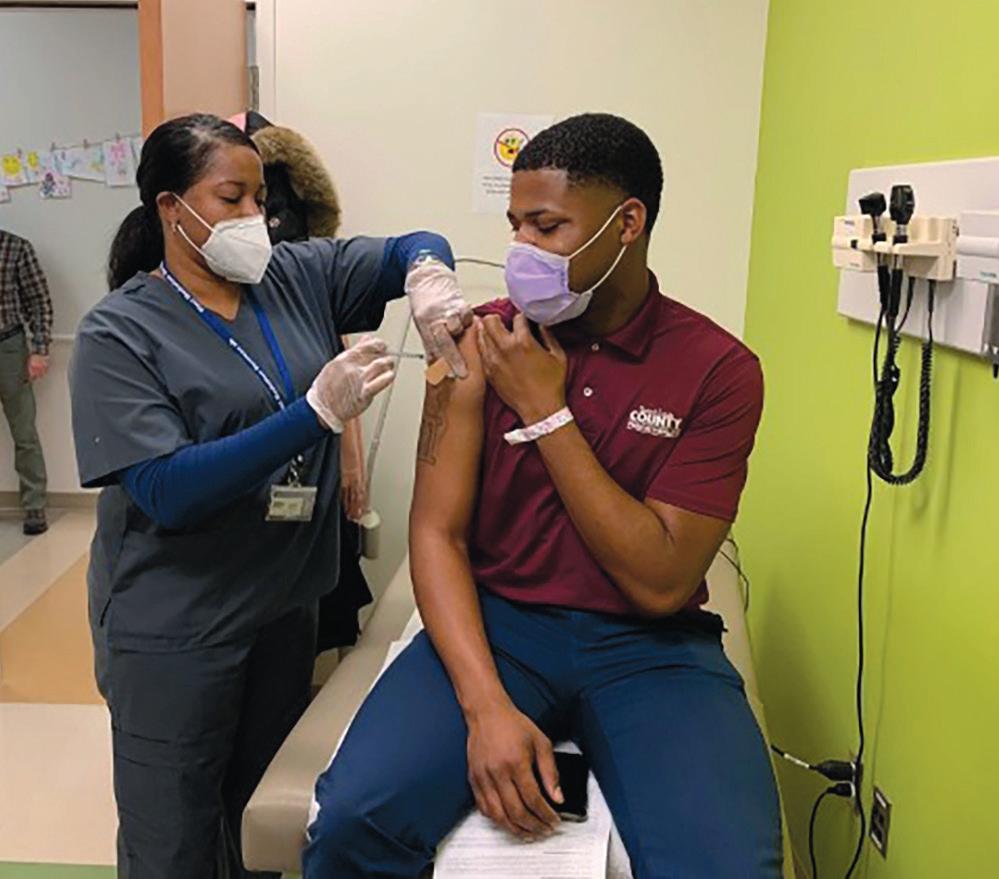
pieces off the shelf like Qualtrics,” Ave said. “And we did it and we did not waste time. And we went as fast as we could.”
Other health departments said it wouldn’t be possible to easily integrate their systems, as they can’t upload their own waitlists to the state’s system. Cox said local lists have been used to send out emails about events available for registration through the Vaccine Navigator.
‘Technology’s wonderful if it works’
Reasons providers aren’t using the Missouri Vaccine Navigator vary.
In Putnam County, which made headlines earlier this month for 143 doses going to waste at a mass vaccination event, Hunt said relying on the Missouri Vaccine Navigator contributed to those issues. The night before the mass vaccination event, the system showed nearly 100 more people who were registered, but then dropped off the next day. Hunt said she wasn’t sure if that was due to potential duplicates or cancellations. And three weeks later for the booster clinic, the system showed fewer people than what the health department’s list had scheduled.
for other providers if the events listed don’t work for them.
Developed by Qualtrics, a global experience management software company headquartered in Seattle, Washington and Provo, Utah, and administered with the support of Ernst & Young LLP, a London-based professional services network, the system has been used by local governments across the
country — including in St. Louis County.
For the Missouri Vaccine Navigator’s current contract, Cox said the state paid $576,000 to Ernst & Young and spent $152,000 for Qualtrics licenses.
Even as the state collaborates with the St. Louis County Department of Public Health to offer large-scale vaccination
events in the county, registration is being funneled exclusively through the county health department’s Qualtrics system.
That’s what the county health department has found works best, Ave said, as attempting to integrate its system with the state’s would require a significant lift.
“We’ve literally had to create a system from scratch, buying
When it came to scheduling a booster clinic, there also wasn’t a seamless option to have that event notice sent to the same residents who had attended the first. Instead, Hunt had to set it up as a private event and reach out to residents. One of the main limitations was that during a mass vaccination event, the system didn’t
See Navigator, A16





Cordially Invites You to Our 2021 Shining Star Virtual Gala
Saturday, April 17, 2021
11:00 A.M. to 12:30 P.M.
Box Lunch Pick Up 12:30 P.M.-2:30 P.M.
Orlando’s Event and Conference Center
2050 Dorsett Village Shopping Center
Maryland Heights, MO 63043
Featuring Miss Lisella Martin, Saxophonist and Miss Xantia Grant, Vocal Arranger
With Mistress of Ceremonies
Miss Kelly Jackson, News Channel 5
Tickets $40.00 per person
Please RSVP by April 1, 2021 or visit www. Eventbrite.com Look for Breakfast Club
Shining Star Gala or Call 314-972-8883 for tickets
Link to event will be provided after purchase

Continued from A15
allow for a way to check which people who had registered had been checked in or successfully vaccinated, Hunt said, making planning toward the end of the day more difficult.
Despite the issues, Hunt said she’s already seen improvements in the system over the last month. For example, now Hunt can schedule residents for a specific event on the backend.
“I think it has a place. And for these mass events, it was beneficial to have,” Hunt said. “We won’t use it in our office. But we do a lot of things on a much smaller scale, so we wouldn’t need it.”
It was a point Scott Clardy, the assistant director of the Columbia/Boone County Department of Public Health and Human Services, echoed. During the department’s first mass vaccination event supported by the Missouri National Guard, the system was useful in that it allowed for data to be inputted directly to the state’s immunization database, ShowMeVax.
But it could also be confusing for residents who showed up thinking that registering with the Vaccine Navigator meant they had also registered for an appointment. After signing up for the system, residents will be notified when their tier activates and must check back regularly for open events to register for.
“It’s serving its purpose as far as helping us be able to get data into the immunization registry,” Clardy said. “But as far as a scheduling device for our local clinics… it’s just not as helpful as it could have been if it would have been in place at the very beginning when the vaccine first became available.”
In both Ripley County in southeast Missouri and Macon County in northern Missouri, internet access isn’t always a given — making accessing the Vaccine Navigator more challenging.
Back in December, the
Macon County Health Department began receiving calls from residents eager for the vaccine. Their list quickly grew to over 2,000 residents, but the department hasn’t had any issues meeting demand, said Mike Chambers, the department’s administrator.
“In my opinion, it was a little bit too late because we’d already started doing mass vaccination clinics when that was rolling out,” Chambers said of the state’s system.
Jan Morrow, the director of the Ripley County Public Health Center, fielded calls last month from frustrated residents, who without internet access, had called the Vaccine Navigator’s hotline instead to register over the phone.
Demand was so high an automated recording said no one was available.
“Technology’s wonderful if it works,” Morrow said, “but there were several glitches in that system.”
In just one day on Feb. 22, just shy of 2,000 calls were handled, Cox said. And since the state’s COVID vaccine hotline was launched last March, about 10 percent of its handled calls had been in the first two weeks of launching the Vaccine Navigator, Cox said last month.
“Additional staff support, both temporary and National Guard have and continue to be added,” Cox said at the time.
For now, health departments are still recommending that residents in search of a vaccine appointment get on every list they can and check multiple providers.
That’s where groups like the Vaccine Sharks come in.
Through a Google Form, the group of volunteers has connected hundreds of residents with appointments. They’ve gone through their own iterations of their system too, getting flooded with requests in the beginning and now working to



be a resource for those most in need by reaching out to community orgs they can collaborate with. They’ve figured out sites’ nuances and quirks — like how sometimes on the CVS website it might show no appointments for St. Louis, but if you go through Montana and put in a St. Louis zip code, some might pop up. In a constantly evolving Google Doc, Anderson compiles new events along with a running list of tips. And Golub’s own phone number has gotten circulated as helping one person led to more of their friends and family through word of mouth.
For both Anderson and Golub, their desire to help was born out of their own frustrations and difficulties navigating the system for their own families. Golub’s mom contracted COVID-19 in her nursing home, and with it came a fear that Golub had been unprepared for.
“She’s 81. She has late stage Alzheimer’s. So I was really so scared when she tested positive,” Golub said, later adding: “I’m prepared to lose my mom to Alzheimer’s. I wasn’t prepared for that.”
When her mom received her first vaccine dose in January, a wave of relief washed over Golub. And it’s that feeling that drives her, knowing that the more people that can be vaccinated, the more everyone will be better protected.
Increases in vaccine supply on the horizon make it easier for Anderson to push herself to keep going, knowing that hopefully we’ll all be out of this soon. Despite issues like a lack of clear communication and clunky websites that have defined the vaccine rollout, what it has highlighted is how people can rise to a challenge and help from where they are.
“There’s a gap. And people are quickly moving to fill that gap to help their communities,” Anderson said. “And I think that that kind of stuff shows the best of who we are as people.” The Missouri Independent in a content partner of /the St. Louis American.
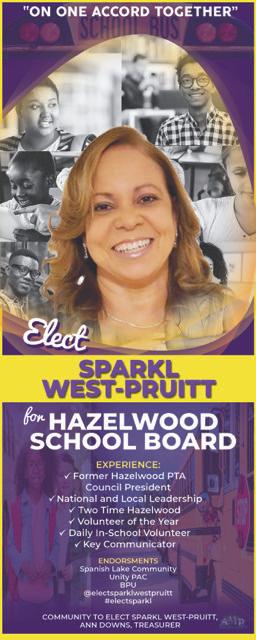


Locals who contracted the virus share their stories
Sylvester Brown, Jr.
Of The St. Louis American
It’s been a bit over a year since Elmer (El) Covington, 52, of University City contracted the COVID-19. The day before he was diagnosed, March 12, 2020, the World Health Organization had declared the novel coronavirus a pandemic. Covington had no idea that he was among the thousands of Americans who had already been affected. Five days later, the official U.S. death toll had surpassed 100 people. By March 26, the number of dead from the virus had risen to more than 100,000.
Covington is one of four people The St. Louis American interviewed for a COVID-19 story last year. All had contracted the disease in March or April of 2020. One year later, they speak of recovery, residual effects and the mental and physical scars left by the illness.
n “A year later and the virus is still with us. What worries me most is the people I care about. My biggest fear is someone close to me getting the virus.”
– Elmer (El) Covington
“Physically, I’m alright,” Covington said, adding: “But, I still have what I call ‘COVID brain’…these mental lapses where I forget things.”
Another lingering malady, Covington said, is increased bouts with anxiety:
“It comes in spurts. My heart starts racing. I have palpitations. My doctor suggests I seek professional help, but I don’t know.”
Anxiety and memory lapses aside, Covington said he’s blessed to still be alive. He’s had the first vaccination shot but still worries:
“A year later and the virus is still with us. What worries me most is the people I care about. My biggest fear is someone close to me getting the virus.”
Eddie Smith, the good-humored, 71-yearold, Morgan Freeman look-alike, was diagnosed with the virus on March 25th. Smith, an HVAC engineer since the late 1960s, spent more than two months in a coma. Recovery brought him out of retirement. Now he’s traveling the country designing the installation and maintenance of air-conditioning systems
See COVID, A19
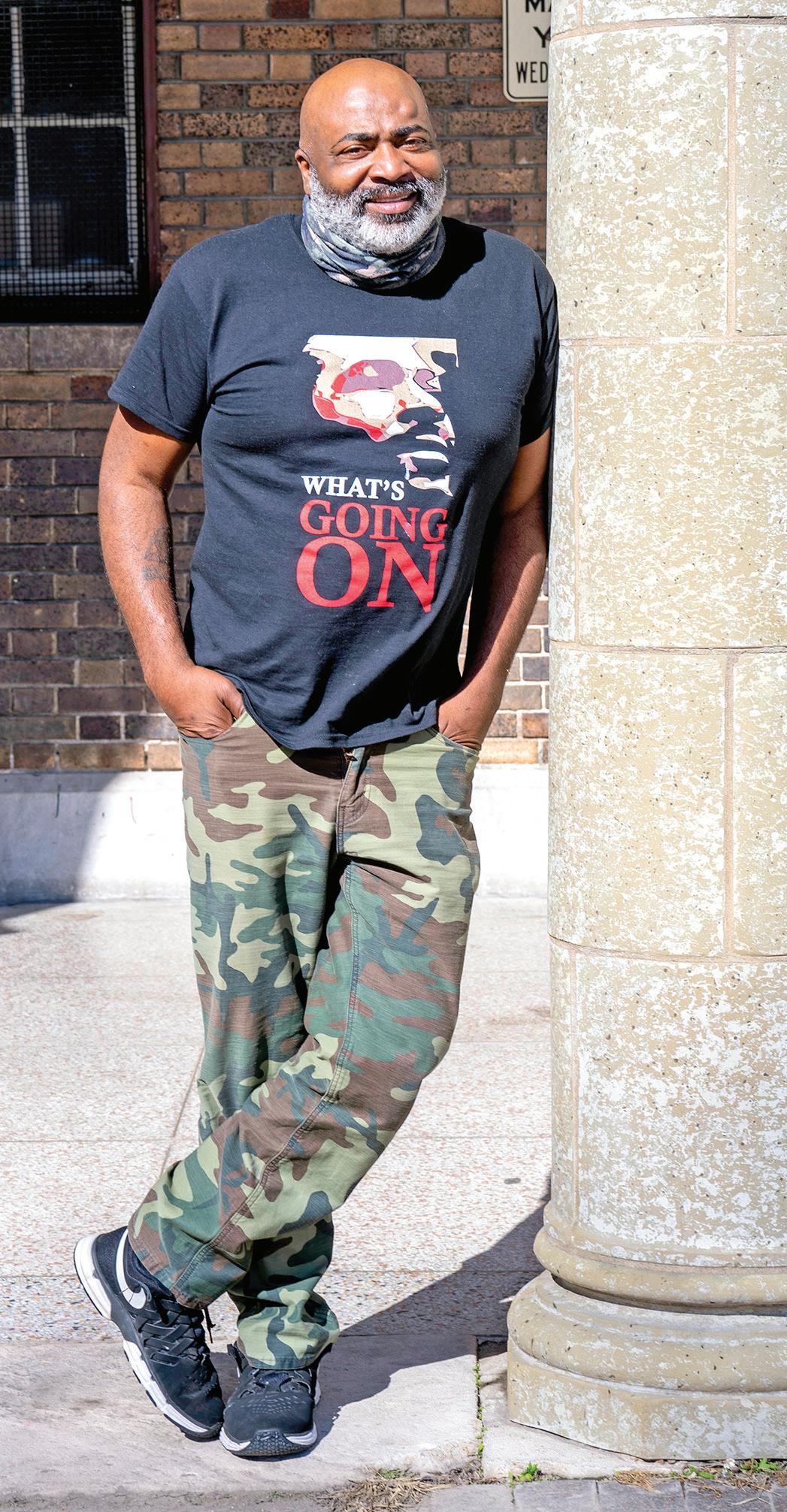
By Sophie Hurwitz Of the St. Louis American
Dr. Dwayne Proctor, who has spent over a decade in various roles at the Robert Wood Johnson Foundation in New Jersey, is excited to be relocating to Missouri.
On March 18, the Missouri Foundation for Health announced that Proctor would be taking over as President and CEO, effective May 3.
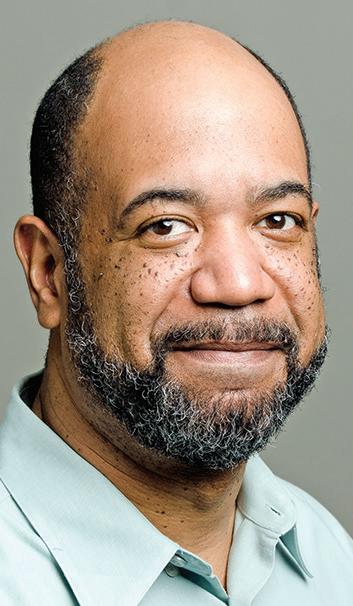
The Missouri Foundation for Health, as Proctor put it, is “in a unique position”: it’s an independent philanthropic foundation founded in 2000 using the funding generated from Blue Cross Blue Shield of Missouri’s conversion from nonprofit to for-profit status. They distribute, on average, $40-$50 million in grant funding per year in 84 counties in the state plus the City of St. Louis. Proctor created a new definition of health equity for philanthropic purposes while working with the Robert Wood Johnson Foundation (RWJF) and is now bringing that definition to Missouri—a place where, he says, health equity can be reached in “10 to 12 years.”
He noted that in coming to Missouri he is not working with a blank slate—the Missouri Foundation for Health has had several notable successes in the past decade, including a collaboration with the RWJF: the Ferguson Commission Playbook, which illuminated the public health issues that contributed to the Ferguson uprising in 2014 and continue to contribute to inequity in the region.
“I know that we’re really, really interested in understanding more about the Black community here, and about how equitable approaches can be useful in the work that’s already going on here,” Proctor said. “I know I’m not starting from a blank slate, that the Missouri Foundation for Health has several successes under its belt, and so I just want to build on the platform of what’s there and understand more about what we can do.”
In 2005, Proctor was tapped by the Robert Wood Johnson Foundation to lead their efforts to reduce childhood obesity in the United States. Prior to this role, he was an assistant professor at the University of Connecticut School of Medicine, where he taught courses on medical communications.
During his period of work on childhood
By Rudi Keller Missouri Independent
A partisan battle over Medicaid expansion in the House Budget Committee ended Thursday with a vote against spending $1.9 billion to implement the medical program approved by voters in August.
The arguments for and against a special spending bill that separated expansion costs from other Medicaid budget lines echoed the debates of past years — Republicans argued that it cost too much and would force cuts in other areas while Democrats contended that the state has plenty of cash and expansion would save money for state taxpayers. The committee voted 9-20 against the spending bill that allocated $130 million of general revenue and $1.9 billion overall to expand coverage to households with incomes below 138% of the federal poverty guideline. The vote came as the committee
n The committee voted 9-20 against the spending bill that allocated $130 million of general revenue and $1.9 billion overall to expand coverage to households with incomes below 138% of the federal poverty guideline.
was working through proposed changes to the $34.1 billion budget proposed in January by Gov. Mike Parson. The full House will debate the budget in floor sessions next week.
Budget Committee Chairman Cody Smith, R-Carthage, argued the Medicaid program already costs too much and needs changes to control costs and



Continued from A18
streamline services.
“If we expand Medicaid without doing that, we are simply pouring gasoline on the fire of problems that could come along due to increased spending,” Smith said.
The committee’s ranking Democrat, Rep. Peter Merideth of St. Louis, said the state’s share will be minimal and that the state has a healthy financial balance. Expansion will mean a healthier state, financial support for providers and a stronger economy as the federal support is spent, he said.
“We are being offered a false choice and a false narrative,” Merideth said. “We are acting like even this $100 million of general revenue is a fiscal crisis.” Medicaid is a shared obligation of the state and federal government, but Missouri’s current program, called MoHealthNet, offers few services that are not required to participate in the program.
Adults with children and
no other qualifying conditions such as a disability are covered only if their income is less than the family would receive in cash welfare benefits, $292 a month for a single-parent household with two children. No working age adults without children are covered unless they qualify for another reason.
Almost 1 million people are currently covered by the program.
Amendment 2, approved by voters last year, requires the state to offer coverage to approximately 275,000 people with annual incomes up to $17,744 for an individual and $35,670 for a family of four. But rather than settling the debate that has raged in the state since passage of the Affordable Care Act, Amendment 2 instead added a new layer of disagreement to the familiar debate.
Opponents cited the relatively close vote — 53% of voters supported Medicaid expansion — and the lack of a funding source for the state’s share. Proponents said that by approving the constitutional amendment, lawmakers were obligated by their oath of office
to fund it.
The Missouri Constitution prohibits initiatives that require lawmakers to make new appropriations without also providing a source of money.
The Western District Court of Appeals rejected a pre-election challenge to Amendment 2 because it did not explicitly require a new appropriation. Whether that was true would be determined when the amendment was implemented, the court said.
Republicans contend that if lawmakers do not appropriate specifically for the expansion, it cannot take place.
“If we want initiatives with appropriations, we need to be honest with the people and say where the money is coming from,” said Rep. David Evans, R-West Plains. “If they had drafted it, including what the constitution actually requires, it may not have gotten over that 50% mark.”
Democrats said that federal changes to Medicaid, including a boost in the federal share of the existing program for states that expand coverage, means that while the state may spend more overall, it will spend
less from general revenue for Medicaid with an expanded program.
“Report after report, from state after state, is showing that this is the fiscally responsible thing to do,” state Rep. Maggie Nurrenbern, D-Kansas City. Medicaid expansion means more access to health care statewide, Nurrenbern said.
“We see our rural hospitals hanging on by their fingernails and asking, ‘please let us provide vital health care to our communities,’” she said.
Instead of separating it out to a standalone spending bill, the governor’s proposed $34.1 billion budget for fiscal 2022 wrapped the cost into existing Medicaid spending for appropriation purposes.
Overall, the budget proposal calls for $14.1 billion for Medicaid, including $2.7 billion in general revenue, according to budget documents. Medicaid in Missouri cost $10.8 billion in fiscal 2020, about 4% more than the previous year.
The general revenue cost of Medicaid, however, went down in fiscal 2020 because of changes in federal support due
By Emily Woodbury St. Louis Public Radio
All Missouri adults will become eligible for the COVID-19 vaccine by April 9 and all those 16 and older in Illinois become eligible on April 12. Yet, many still have questions — such as how the vaccines work against coronavirus variants and which vaccine is the best to receive.
“Whatever vaccine is available to you the earliest is the best one for you,” said Dr. Dan Hoft, an infectious disease physician, “because they all are shown to be safe, they all work, and the earlier we get people vaccinated, the earlier we can get back to normal life.” Hoft is the director of St. Louis University’s Center for Vaccine Development. He joined Tuesday’s St. Louis on the Air to discuss the latest vaccine news and answer listener questions, such as why one vaccine would lead to a stronger bodily reaction than others and why some people experience an arm rash after receiving the vaccine.
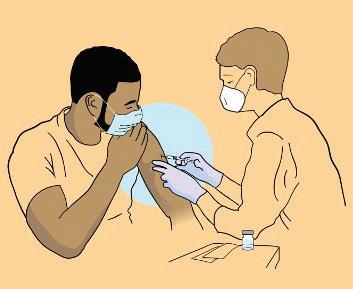
SLU’s Center for Vaccine Development was involved in developing and testing the Moderna and Johnson & Johnson vaccines currently in use. Now, the center is starting a clinical trial that aims to develop a second-generation vaccine that will be effective against coronavirus variants. Hoft said the project involves working on combining aspects of current vaccines — like Johnson & Johnson’s antivirus vaccine and Moderna’s self-amplifying mRNA vaccine
Proctor
Continued from A18 as possible. Achieving this requires removing obstacles to health—such as poverty and discrimination and their consequences.”
obesity, he and his colleagues defined health equity as follows: “Health equity means that everyone has a fair and just opportunity to be as healthy
Continued from A18
updated to reduce contamination. Late last year, Smith said he won a three-month contract at a nuclear facility in Hope Falls, Idaho. Today, he’s designing what he calls “clean rooms” at a Pfizer laboratory in Cumberland, Rhode Island. Smith borrowed from soul singer, James Brown, to describe his current health status:
“I feel real good! I made a full recovery. At 71, I still have a lot to offer. Oh, I still have aches and pains, but I’m supposed to, right? And all I
Health equity, according to Proctor, requires “being able to form partnerships and collaborations at the community level that are impactful in that
need for that,” Smith joked, “is a good woman to massage me every now and then.”
Rudolph V. Ray, 65, a retired Air Force Chief Master Sergeant and St. Charles resident, also contracted the virus in mid-March. “Mentally,” Ray said he’s in “a good frame of mind” but he still suffers from chronic fatigue:
“I take my vitamins and exercise regularly, but “even with that there are days, like yesterday, when I was bone tired and I hadn’t done a thing.”
The illness hit Ray suddenly. He said he went from being healthy to bed-ridden in a matter of hours. Fortunately, he was able to recover, in
Photo: David Kovaluk / St. Louis Public Radio
— to produce two separate immune responses to the coronavirus.
“This trial is not only trying to reduce neutralizing antibodies, which are key, but it’s also trying to induce a much better T-cell response, which is the other part of the immune response that can protect us by not making antibodies, but by recog-
they represent the community.” As such, he hopes to meet with community organizations, particularly in the Black community in St. Louis, to figure out how the Missouri Foundation for Health can distribute their resources more effectively.
“I understand that I am coming from somewhere else,
isolation, at home. Unlike Covington, he doesn’t suffer from anxiety. Instead, he uses the word “cautious’ to describe his COVID-related concerns:
“It seems like every month a new variant comes out. Even the medical experts aren’t sure what’s coming next. So, yeah, I’m very concerned. “I’m always afraid that I’ll catch it again and I’ll tell you why,” Ray added with a chuckle. “It hurt!”
Ella Owens celebrated her 77th birthday on March 22. Last year, she shared her recollections and reflections after catching the virus the day before Easter. Owens, a devout member of Greater Leonard Missionary Baptist Church
to the pandemic. And because of the pandemic, it is likely it will cost much less general revenue than Parson’s budget indicated.
The cost of the existing program is shared with the federal government, and for the current year, Missouri’s stated share is about 35%. Because of the pandemic, that share was cut to about 29% starting in March 2020 and that emergency support will continue through the end of the year.
For people enrolled under the expansion program, the Affordable Care Act sets the federal share at 90%.
The $1.9 trillion American Rescue Plan bill signed into law earlier this month by President Joe Biden included an incentive for the 12 states that haven’t expanded Medicaid coverage to do so. The federal share of the existing program would be increased by 5%, estimated to produce a savings for Missouri of more than $1 billion over the next two years.
Missouri already has a record budget surplus in the general revenue fund, which stood at $1.9 billion on March 1 and is expected to have $1.1
billion unspent at the end of the fiscal year. The federal stimulus bill also includes $2.8 billion in general support for Missouri state spending.
“Stop acting like we don’t have money because you don’t want to give health care to people,” Merideth said. “It is a lie and ignoring what Missourians told us to do.”
But Republicans said obtaining more federal funds will expand the national budget deficit and by refusing to appropriate the money, Missouri can help control federal debt.
“Are we willing to see the debt rise further?” said Budget Committee Vice Chairman Dirk Deaton, R-Noel. “Are we willing to take that vote, weaken our country at the expense of the Chinese and others?”
Missouri Independent is part of States Newsroom, a network of news outlets supported by grants and a coalition of donors as a 501(c)(3) public charity. Missouri Independent maintains editorial independence. Contact Editor Jason Hancock for questions: info@ missouriindependent.com.
Vaccine registration details for city and county
About 116 million doses of COVID-19 vaccine have been administered in the U.S., according to data published last week by the Centers for Disease Control and Prevention.
nizing an infected cell and eliminating that infected cell before it makes new viral particles,” Hoft said. “That is like a one-two punch, you got two immune responses for one, and that might work better.”
Those interested in enrolling in the trial, or learning more, can visit http://vaccine.slu. edu or call 314-977-6333.
so it may be best that I have folks who are local here to advise me as I get used to being here…I’m not coming in thinking I know how to fix things,” Proctor said. “I do not know how to fix things. I just know what I know from the experiences that we’ve had.”
In Missouri, Proctor is con-
in the Old North neighborhood, was convinced that her affliction was God’s way of using her as a testament to his strength. Today, her feelings haven’t changed:
“After that article, I got so many calls from people telling me how it encouraged them. My testament reached so many people who told me how it inspired and encouraged them. That’s what I wanted… to remind people that there is hope in Jesus Christ.”
Owens, who was already a diminutive 113 pounds before she got sick, went down to 89 pounds during her bout with the coronavirus. She’s exercising and walking about three or four days a week, she said, and
The St. Louis County Department of Public Health will host two large-scale vaccination events in South County early next month.
The first event will be held from 9 a.m. to 6 p.m. April 3 at South Technical High School, 12721 West Watson Road. The second event is scheduled during the same hours on April 8 at the Kennedy Recreation Center, 6050 Wells Road. These are appointment only events. Plans for additional dates for vaccination events at the South County sites are still being developed.
“St. Louis County continues to work hard to remove barriers to vaccinations for all County residents,” St. Louis County Executive Dr. Sam Page said. “This week we are vaccinating a record 15,000 individuals, and as long as the state continues to increase the supply of vaccine we get, our capacity to administer doses will increase as well.”
DPH has been working with Councilman Ernie Trakas and other community leaders for sites in South County that can be used repeatedly. The availability of such sites improves efficiency because less setup work is required between events.
For the latest county information on vaccination sites and to register for COVID-19 vaccinations go to https://tinyurl. com/26wszt6e
If you are a City of St. Louis residents interested in getting a vaccination visit https://stlouisdph.qualtrics.com/jfe/form/ SV_08qM4vOqB5dJniR or call 314-657- 1499 if you do not have access to the internet.
If you previously registered and have secured your vaccinations through another agency, you may remove yourself from the list by emailing health@stlouis-mo.gov or calling 314-657-1499.
cerned about “substance use challenges” in rural areas “and access to quality care, especially for people who might be more isolated.” He also noted his desire to work on addiction care and firearm suicide prevention in urban areas. However, he is also excited about Missouri’s role as a state that can be representative of the entire country in its challenges and its successes.
is now up to 94 pounds. The biggest blow from COVID, she said, is that it disrupted her life at the church where she serves as the administrative assistant and missionary president.
“I really miss visiting people in nursing homes and the sick and poor in the neighborhood. We still have the clothing and food pantry give-a-ways on the first of the month, but I miss the fellowship.”
Owens said she and her husband, Phillip, 78, are “doing fine.” Both have been vaccinated and are planning a trip to California to visit relatives in May. She’s excited that the church is preparing to welcome parishioners back soon. For Owens, COVID-19 was a vali-
“What I’m really looking forward to [is that] Missouri’s in the…exact center of the country,” Proctor said. “The politics in Missouri represent the politics of the nation.”
dation of her faith:
“I’m praying, watching and waiting. I know God is still working. I’m just waiting for Him to move. I’m waiting to go back to church. I know it’s going to happen,” Owens stressed. “I’m waiting to fellowship with my family again, have dinner with them again, hug them and touch their hands again.
“So many families have been affected by the COVID. To have had it and survived, well, that’s something to be thankful for.”
Sylverster Brown, Jr. is The St. Louis American’s inaugural Deaconess Fellow.



PRESENT:
PRESENT:


When we’re lucky enough to have a chance to go out for dinner, there are a few ways to stay healthy with our food


















We each need at least 3 servings per day of whole grains. But what does that mean? How can we know what foods contain whole grains?
See if the restaurant will let you “share” a meal. Many meals are two, three or more times an actual serving size.
In our “Super-Size” world, we can easily lose track of what an actual serving size means. When reading labels on a food or drink product, you can determine the nutrients, sodium, fiber, sugar and calories of a serving size. But be careful; just because it looks like one small bottle
Look at the ingredients list of a package of food you are about to eat. If the word “whole” is used, then there is most likely a whole grain ingredient. A few items that don’t use the word whole
As soon as you’ve divided your plate into the right size servings, ask your server for a to-go box. Go ahead and box up what you don’t need to eat right away. You can enjoy
Let’s make a game out of exercise!
those leftovers for lunch the next day!
are popcorn, wheatberries, brown rice and wild rice.
INGREDIENTS:
> Ask the server how the different menu items are prepared. Fried, sautéed, and
lifestyle. You can do this by forming new habits. For example, if you decide to eliminate sugary drinks completely, it only takes a few weeks until this becomes what you’re used to.
Here are the steps to making a healthy permanent change. We‘ll use the sugary drink change as an example.
As spring approaches, warmer weather allows us all to get more outdoor exercise. Here are some ways to become a more active person.
Getting plenty of whole grains in your diet can improve your health and reduce your chance for some chronic illnesses such as stroke, diabetes, heart disease and high blood pressure. Visit wholegrainscouncil.com for more information.
> Decide you’re going to switch from soda to water.
> Start by substituting one drink per day to water.
> Avoid gravies, cheese sauces and other kinds of toppings that often just add fat and calories.
Melissa Douglass, MSW
Latoya Woods, DNP, APRN, FNP-C
> Every few days increase the amount of water and decrease your soda intake.
> After 3-4 weeks, this change will become a habit.
of soda — it may not be considered one serving size. For example, a 20-oz bottle contains 2.5 servings. So if the bottle states “110 calories per serving,” that means the entire bottle contains a total of 275 calories! Remember to watch those serving sizes and you’ll have better control over what you’re eating and drinking.
> Stick with water to drink. Not only will you save money, but you won’t be adding in extra calories from a sugarfilled drink.
Learning Standards: HPE 2, HPE 5, NH 1, NH 3, NH 5
When you automatically reach for water instead of soda, it has now become a lifestyle change!
even simmered can all mean, “cooked in oil.” Instead, choose baked or grilled options.
Learning Standards: HPE 2, HPE 4, HPE 5, NH 1, NH 2, NH 3, NH 5
> What are other ways to stay healthy while dining out?
Learning Standards: HPE 1, HPE 2, HPE 5, NH 1, NH 5

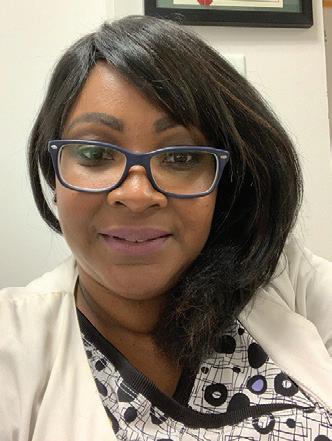
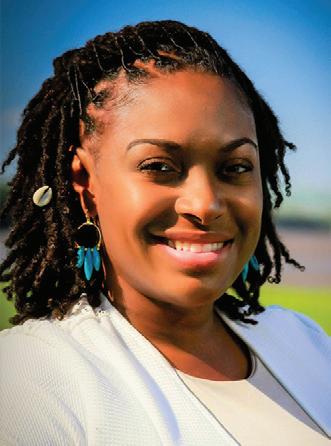
Where do you work? I am a family nurse practitioner for BJC Medical Group.
Where do you work? I am a school nurse at Monroe Elementary School.
Where do you work? I am a school nurse with St. Louis Public Schools.
Secondly, when you are finished with any kind of strenuous (very active) exercise, take some time to cool down. You can slowly stretch your arms and
Learning Standards: HPE 1, HPE 2, HPE 5, NH 1, NH 5
Instead of watching TV — ride your bike with friends.
legs again, and continue with reduced speed movements until your heart rate begins to slow down.
Where did you go to school? I graduated from McCluer North High School. I earned an Associate of Applied Science in Nursing from Meramec College in Kirkwood and completing my bachelor’s degree at Webster University in Webster Groves.
March 20, 2021, is the first day of spring. With spring comes warmer weather and longer days (later sunset). Make it a habit to spend as much time playing outside as the weather allows.
It’s important that before you embark on any kind of exercise to remember two things: warm up and cool down. Start with some slow stretches and movement (like walking) to increase your heart rate a little. Warm up for a good five minutes before increasing your heart rate.
card and fold into a small square. Put these squares into a bowl.
and breathing. You want to have fun, but it’s also a great way to help keep your heart, lungs and body healthy.
Where do you work? I am the founder and distance counselor for Goal Driven Counseling, LLC. Where did you go to school? I graduated from Whitney Young Magnet High School in Chicago, IL: same as former first lady Mrs. Michelle Obama. I then earned a Bachelor of Science in Social Work, and a Master of Social Work from the University of Missouri – St. Louis. I also completed two more years of supervision and exams to become a Licensed Clinical Social Worker in the state of Missouri.
Where did you go to school? I graduated from Sumner High School. I then earned Associate Degree in Nursing from Forest Park College and a BS in Business Administration from Columbia College.
Instead of playing video games — play baseball, football, badminton, or some other active game.
Some fun outdoor games to play include tag, kickball, basketball, Frisbee, and bicycling. Choose activities that increase your heart rate
Instead of surfing the ‘Net — go for a brisk walk around the neighborhood.
First, locate either a deck of cards or two dice. Next you’ll need to make a list of different types of exercise: jumping jacks, sit-ups, lunges, etc. Write each exercise item on a small piece of paper or index
> NEVER walk on a “frozen” pond, lake, river or any other body of water. Just because it looks frozen does not mean it is safe.
Break into small groups and define what it means to be a bully. Share your ideas with the class. Did you have the same things listed (as the other groups) that you would consider as bullying behavior? Now back in your groups, create a newspaper ad that includes at least two of the following:
Take turns rolling the dice (or drawing a card) and selecting an exercise from the bowl. The total number on the dice or card tells you how many of the exercise you must do. Face cards (king,
Make a list of your favorite 10 activities to do outdoors. Compare your list with your classmates and create a chart to see what are the most popular.
This warm-up and recovery period is important for your heart health. It also helps to reduce the amount of muscle pulls and strains.
Can you think of other ways to be more active? Going outside and staying active not only increases your heart rate and burns calories, but it also helps you build friendships!
Learning Standards:
HPE1, HPE 2, HPE 5, NH 1, NH 5
queen or jack) should all count as the number 10. Aces are “wild” and you can do as many as you want! To really challenge yourself, have one person roll the dice and the second can select the exercise. See who can complete the exercise challenge first!
Learning Standards: HPE 2, HPE 5, NH 1
Learning Standards: HPE 1, HPE 2, HPE 5, NH 1
> What to do if you see someone else bullied.
Where did you go to school? I graduated from McCluer High School. I then earned a Bachelor of Nursing and a Master of Nursing Practice from the University of Missouri – St. Louis. And finally, I earned a Doctorate of Nursing Practice from Maryville University.
What does a school nurse do? I love giving students medications, so they’re able to focus on learning. I clean and bandage wounds. I use medical equipment like a stethoscope, for example, to evaluate whether or not my asthmatics are breathing well. Moreover, I teach and promote healthy habits to my students.
What does a Licensed Clinical Social Worker do? I use technology to help teens and young adults explore their emotions, better understand their feelings, work through relationships, and address common challenges completely online through a computer, tablet, or smart phone. Similar to a Facetime call, I support and guide my clients from the comfort of their home or private location where they are comfortable
What does a family nurse practitioner do? Each day I have office visits with patients to help treat new health conditions and/or manage established health conditions. I perform physical examinations on patients, order labs, read x-rays results, and more.
A BMI (Body Mass Index) is a generic way to calculate where your weight falls into categories (thin, average, overweight, obese). However, it’s a good idea to remember that a BMI may not take into consideration many things such as athleticism (how athletic you are), your bone density and other factors. Discuss your BMI with your
How much time do you spend each day looking down at a phone, laptop or video game?
Chiropractors around the country see young patients every day suffering from back, neck and head-aches resulting from the extra strain you put on your body when you look down for long periods of time.
> If you are with someone that falls through the ice, first run (or call) for help. Do not try to go out onto the ice to help your friend. You can fall through the ice too.
> How bullying hurts others.
> What to do if you are bullied.
> What to do if YOU are the bully.
doctor if you have any questions. The formula to calculate your BMI is 703 X weight (lbs) ÷ height (in inches/squared) or search “BMI Calculator” to find an easy fill-in chart online. If your number is high, what are some ways to lower your BMI?
Look through the newspaper for examples of ad layouts and design. Discuss the words “compassion,” “empathy” and “sympathy.” How do they each play into your response to bullying at your school?
1. Most importantly — take breaks! Have a goal of a 3 minute break every 15-20 minutes. Move around, stretch your neck and relax, without looking down!
> Also — remember to look up! Icicles injure numerous people every year. If you see large icicles forming over your front steps, ask your parents to use a broom handle to knock them off to the side before they break loose from your gutters.
Learning Standards: HPE 2, HPE 4, HPE 5, NH 1
Ingredients:
Banana PB Smoothie
8 Saltine crackers
Why did you choose this career? I chose this career to help improve the health of my community.
What does a school nurse do? I assess the concerns of students who are ill, injured or experiencing alterations in their normal health. Nurses screen daily staff, students and visitors for safety. Monroe School is a pilot school for Covid-19 test sites in partnership with the city. Why did you choose this career? I love nursing because there are many opportunities in hospitals, schools, clinics and offices, insurance, legal and research. My passion is working in the schools with students, parents, staff and community partners.
Why did you choose this career? I am a St. Louis native, and was an asthmatic child who experienced frequent hospitalizations. Besides having the influence of nurses in my family, the local nurses who helped take care of me were my “angels” and always managed to nurse me back to health, thus sparking my interest.
Why did you choose this career? I chose this career because I enjoy being a support to teens and young adults in a very challenging phase of life that can be overwhelming. I enjoy teaching them how to best take care of themselves so they can live healthy and fulfilling lives.
> What other ice hazards are there?
Learning Standards: HPE 1, HPE 2, NH 5
2. Set your tech device in a holder to keep it at eye level, reducing the need to look down.
Learning Standards: HPE 2, HPE 5, NH 4
Learning Standards: HPE 2, HPE 5, HPE 7, NH 5, NH 7
“Questions or comments? Contact Cathy Sewell csewell@stlamerican.com or 314-289-5422
A couple of quick tips that will reduce that strain on your neck are:
> When walking on icecovered roadways or sidewalks, take baby steps. Walk carefully and slowly.
Learning Standards: HPE 1, HPE 2, NH 1, NH 5
What is your favorite part of the job you have?
4 Tbsp Peanut butter
Ingredients:
Ingredients:
Ingredients: 1/2 Cp Vanilla Greek yogurt, 3 Tbsp Natural peanut butter, 1 Ripe banana (sliced and frozen), Splash of vanilla (optional) 6 Ice cubes
2 Large Strawberries
1 15-Oz Can Garbanzo beans
1 cup blueberries
1 Tbsp Honey (optional)
1 Garlic clove, crushed
1 cup non-fat Greek Yogurt
2 Tsp Cumin, 1 Tsp Olive oil, ½ Tsp Salt Directions: Combine all ingredients in a blender until smooth. Enjoy with baked tortilla chips or raw vegetables.
Directions: Blend all ingredients until Smooth. Makes 2 yummy smoothies!
Directions: Spread peanut butter on four of the crackers and top with sliced strawberries. Drizzle with honey and top with the other crackers to make four cracker-wiches.
Directions: Drop each blueberry into the yogurt. Using a spoon, swirl around to coat and place each blueberry on a cookie sheet topped with parchment paper. Freeze for at least an hour.
What is your favorite part of the job you have? Many chronic health conditions (diabetes, high cholesterol, high blood pressure) are preventable, and early detection is key. Thus my favorite part of the job is partnering with patients to establish and manage a plan to help them each live a long and healthy life.
What is your favorite part of the job you have? I enjoy when a child tells you, “I want to be a nurse.” And best of all, I love the smiles, hugs and “thank-yous”.
Learning Standards: HPE6, NH3
My childhood health challenges have given me sensitivity to children suffering with illness. After being given a new lease on life, I consider it an honor to be in a position to promote health to the children of my community, in whatever capacity I serve – in turn, being their “angel.”
What is your favorite part of the job you have? I love that my job makes talking about mental health not as scary and even makes it kind of cool. I love that I get to build valuable relationships with so many people that trust me to be there for them. I love that no matter where my clients are, we can simply connect with a video call and I can not only support them through hard times, but lots of good times as well.
Learning Standards: HPE6, NH3
Learning Standards: HPE 6, NH 3
Learning Standards: HPE6, NH3
“Questions or comments? Contact Cathy Sewell csewell@stlamerican.com or 314-289-5422
“Questions or comments? Contact Cathy Sewell csewell@stlamerican.com or 314-289-5422
“Questions or comments? Contact Cathy Sewell csewell@stlamerican.com or 314-289-5422








Local students use self-directed research to study the science of zoology, and also study bones to learn more about animals.


Diabetes is a condition where a person’s body does not use glucose (also known as sugar) properly. There are two main types of diabetes, type 1 and type 2. Type 1 diabetes is caused by genetic factors. It is not caused by eating too much sugar. Type 2 diabetes is usually linked to being overweight, along with poor diet choices (sugar, fats, fast foods, etc.)
When a person has diabetes, their pancreas is affected. A diabetic has to maintain a very careful and balanced diet to keep their body working effectively. They are in danger of high or low blood sugar effects. Diabetics are more likely to develop heart disease

Background Information:

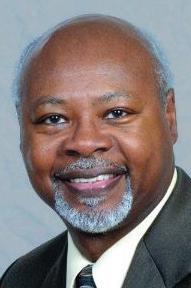
and kidney disease. They are more likely to have high blood pressure and strokes. Diabetes also effects a person’s skin and the ability for wounds to heal.
Diabetes is not contagious. In order to prevent type 2 diabetes, eat a balanced diet, drink plenty of water, and lead an active lifestyle.
For more information, visit: http://kidshealth.org/ kid/centers/diabetes_center. html#cat20491.
Learning Standards: I can read nonfiction text for main idea and supporting details. I can make text-to-world connections.
Will a marshmallow sink or float? What do you think? Do you believe it is possible to sink a marshmallow? In this activity, you will use trial and error to choose your course of action when you attempt to sink a marshmallow.
Materials Needed:
• Marshmallow • Container of Water (glass, bottle, pitcher)
Process:
q Place the marshmallow in the container of water. Does it sink or float?

Diabetics need to watch their carbohydrate intake. In this activity, you will focus on carbs. The American Diabetes Association suggests eating 45-60 grams of carbohydrate per meal, for a total range of approximately 150 grams of carbohydrates per day.
z If your meal consists of the following, how many grams of carbohydrates did you eat?
Baked chicken: 4 oz serving, 0 carb grams
Mashed potatoes: 4 oz serving, 25 carb grams
Caesar salad with dressing: 3 oz serving, 5 carb grams
Mixed vegetables: 3 oz serving, 8 carb grams
A medium-sized roll: 2 oz serving, 22 carb grams
Total grams of carbohydrates ______
x If 1/3 cup of rice has 15 grams of carbohydrates, how many carbohydrates are in a 1 cup serving? ______
DID YOU KNOW?

According to the American Diabetes Association:
w What can you do to make it sink? Work with a partner to create a list of 5 ideas.
e Try your five ideas from step 2. Which idea was most effective? Why?
r Compare your results with your classmates. Was anybody successful?
Learning Standards: I can follow directions to complete a prompt. I can make predictions and analyze results.
c If you eat 1/2 bagel with 30 grams of carbohydrates and 1 tablespoon of jelly with 15 grams of carbohydrates, how many grams of carbohydrates did you eat? ______ How many grams of carbohydrates do you have left for the day? ______
v A 16 ounce bottle of soda has an average of 48 grams of carbohydrates. If you drink two bottles of soda per day, how many grams of carbohydrates did you consume? ______ If you drink one bottle of soda per day, how many carbohydrates do you consume in a week? ______
Learning Standards: I can use addition, subtraction, multiplication, and division to solve problems. I can make text-to-world and text-to-self connections.
healthcare dollars is spent treating diabetes and its complications, and 1 in 5 healthcare dollars is spent caring for people with diabetes.
James R. Gavin, III, was born in Mobile, Alabama, in 1945. Growing up, Gavin was very close to his grandmother whom he called, “Mama Rennie,” and he looked forward to visiting her for fun adventures and story time. One particular visit, Gavin was surprised to find his energetic grandma in bed. Mama Rennie explained to Gavin that she had diabetes and had to have her leg amputated (removed) due to complications from the disease. The following summer, Mama Rennie lost her other leg and became very ill and died. Gavin was very determined to learn more about diabetes and work to find solutions.
In 1966, Gavin earned a Bachelor of Science degree in Chemistry from Livingstone College. He graduated magna cum laude. Magna cum laude is a Latin phrase meaning with high honors. College students who maintain very high grades will earn this honor. In 1970, Gavin earned a PhD in biochemistry from Emory University. Next, he focused on his diabetes studies with the National Institutes of Health and earned a medical degree from Duke University in 1975. Gavin has worked as Senior Scientific Officer at the Howard Hughes Medical Institute in Maryland and Director of the National Institutes of Health Research Scholars Program. He has served as president and professor at Morehouse School of Medicine. He has also been a Professor and Chief of the Diabetes Section, Acting Chief of the Section on Endocrinology, Metabolism and Hypertension, and the William K. Warren Professor for Diabetes Studies at the University of Oklahoma Health Sciences Center.
Dr. Gavin was a medical expert in the court case Kapche vs. Holder. Jeff Kapche applied to work as a special agent for the FBI, but was denied due to the fact that he treated his diabetes with an insulin injection, instead of a pump. Gavin stated that Kapche’s diabetes was considered a disability under federal law. Therefore, the FBI could not use his medical condition as a reason not to hire him. Dr. Gavin is considered a national authority on diabetes.
Gavin has written more than 180 manuscripts, book chapters and scientific abstracts and has received the following awards and honors: Banting Medal for Distinguished Service, Association's Clinician of the Year award, Association's Public Policy Leadership Award.
Learning Standards: I can read a biography about a person who has made contributions in the fields of science, technology, engineering, and math.

Enjoy these activities that help you get to know your St. Louis American newspaper.
Activity One —
Exercise Graph: Look through the newspaper ads for sports and fitness equipment or classes. Judging from the ads, what are the most popular forms of exercise? Create a bar graph to display the results. What are the benefits of each type of exercise? Create a newspaper advertisement for the form of exercise you enjoy most. Include the benefits of that exercise in your ad (muscle tone, flexibility, cardiovascular endurance, etc.)

Activity Two — Sports Expressions: Locate final scores of various games in the newspaper. Write an expression representing the difference of two final scores. Have a friend find the difference to form a number sentence. Check your friend’s answer.
Learning Standards: I can use the newspaper to locate information. I can create a bar graph to display information. I can write to persuade. I can write for a specific person and audience. I can make text-to-self connections.

‘Tina’
By Kenya Vaughn
Of The St. Louis American
Acclaimed HBO documentary “Tina” will hit differently for Black people – particularly Black women – with St. Louis roots, or a St. Louis connection.
The film, by the Academy Award-winning directorial team of Daniel Lindsay and T.J. Martin, premiered on Saturday, March 27 and it is worthy to be praised.
“Tina” uses Turner’s revealing 1981 “PEOPLE” Magazine feature – her first interview to detail the abuse she suffered at the hands of ex-husband and music collaborator Ike Turner – as its starting point. It then flashes back to the beginnings of her life and career and takes viewers through the premiere of the 2018 Broadway production “Tina – The Tina Turner Musical.”
According to the general consensus of critics, Lindsay and Martin crafted a nuanced, vulnerable and intimate portrait of music icon Tina Turner that will serve as an endearing gesture for fans as she bows out of the industry.
But the sons, daughters and grandchildren of St. Louis will see that and then some.
“I grew up two doors down from where Ike met Tina,” famed director and East St. Louis native Reginald Hudlin boasted to The American while promoting his Disney film “Safety” last year. “Tina” makes it clear that our region positioned Turner to tear down barriers of age, race, gender and genre on her winding path to global superstardom.
Anna Mae Bullock was born and mostly raised in Nutbush, Tennessee. But Tina Turner is a St. Louis original that was conceived soon after a teen Bullock arrived – as part of the Great Migration – to reconnect with her mother Zelma Bullock.
In “Tina,” Turner discusses how she convinced future husband Ike Turner to let her have a turn on the microphone. Ike Turner instantly saw in her what the rest of the world would experience 25 years later.
On the weekends, she would play the St. Louis and East St. Louis club circuit as the sultry lead singer for Ike Turner and the Kings of Rhythm. Monday mornings she would go back to her unassuming role as a shy student at Sumner High School. An image of her Sumner senior photo appears in the film. “Ann Bullock, Entertainer,” the caption reads – presumably referring to Bullock’s future career aspirations.
B-roll footage from the St. Louis days also included a contract for Ike Turner and the Kings of Rhythm to play Club Imperial, located near Goodfellow and West Florissant. And an official band photo includes former Ikette Robbie Montgomery, who later became famous in her own right through the OWN Network hit reality series “Welcome To Sweetie Pie’s.” Bullock’s high school prophecy was fulfilled

by 1960. Tina Turner had the R&B hit “Fool In Love” on her hands. Ike Turner renamed her. She then made a name for herself as Ike Turner’s frontwoman – a singing and dancing
By Stacy M. Brown NNPA Newswire Senior
From the hymns of slaves in the 17th and 18th centuries to hip-hop artists’ powerful message in the 20th and 21st centuries, African American artists have created and influenced generations of music lovers.
When Elvis Presley sang “Hound Dog,” he knew he had to pay homage to the African American Blues Legend Big Mama Thornton, who did it first – and better.
“A lot of people seem to think I started this business,” Elvis famously remarked.
“But rock ‘n’ roll was here a long time before I came along. Nobody can sing that kind of music like colored people. Let’s face it: I can’t sing like Fats Domino can. I know that.”
From rock and roll to blues, jazz, and hip-hop, music is as much the African American way of life as the afro was Black people’s style in the 1970s.
Finally honoring that history, the National Museum of African American Music (NMAAM) has opened in Nashville, Tenn.
According to a news release, it’s the only museum dedicated to preserving and celebrating

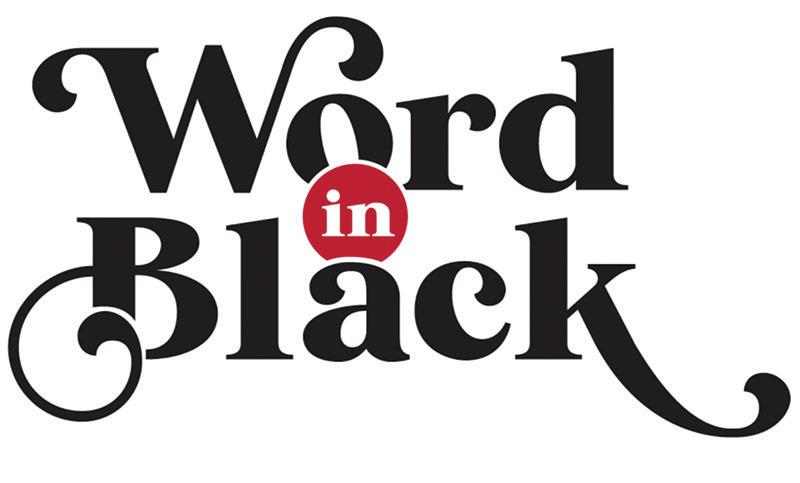
“Red leather, yellow leather, red leather, yellow blether… oh, yuck!”

Hazelwood East student learns from Black Rep theater veterans
By Sylvester Brown Jr.
The St. Louis American
Kennedy Jenkins had a bit of trouble with the tongue-twister she practices at home. The 15-yearold, grade 9, Hazelwood East student has been involved in the Black Rep’s six-week Summer Performing Arts Program for the past four years. Children, ages 8-17, receive instructions in acting, movement, voice, writing, creative costume crafts and more.
Her mother, Kelley D. Harvey, thought the program would be a good fit for her active but somewhat withdrawn daughter. Harvey is a published author and is an active participant in plays at her church. In one production based on the Wizard of OZ, Kennedy played the lead role and had to belt out singer, Tamela Mann’s gospel song, “Take Me to the King.”
“She was kinda shy,” Harvey remembered. “I thought she could have sung it with more confidence. But since she’s joined the Black Rep, her confidence in performing has gotten better, which is what I was hoping for.”
At the time, Kennedy had her sights pegged on dancing. Always supportive, her mother signed her up for dance classes with Dance Plus Studio at an early age. Once Kennedy followed her mother’s advice and joined the Black Rep, acting superseded dancing.
Acting has given Kennedy a way to cope in perilous times. She’s been taking virtual learning classes for about a year, which she found lacking:
“At first, it seemed like the teachers and students were very confused. It (virtual learning) wasn’t as organized as it is now,” Kennedy explained. “The isolation and not being able to go anywhere made me really sad. I like going out, driving, seeing places like the new aquarium, I like being on the road.”
The coronavirus did delay the usual start date of the summer program last year, but the young actors were able to gather albeit with strict safety and social distancing requirements. It was a good thing for Kennedy whose world was also rocked by the murder of George Floyd by a Minneapolis
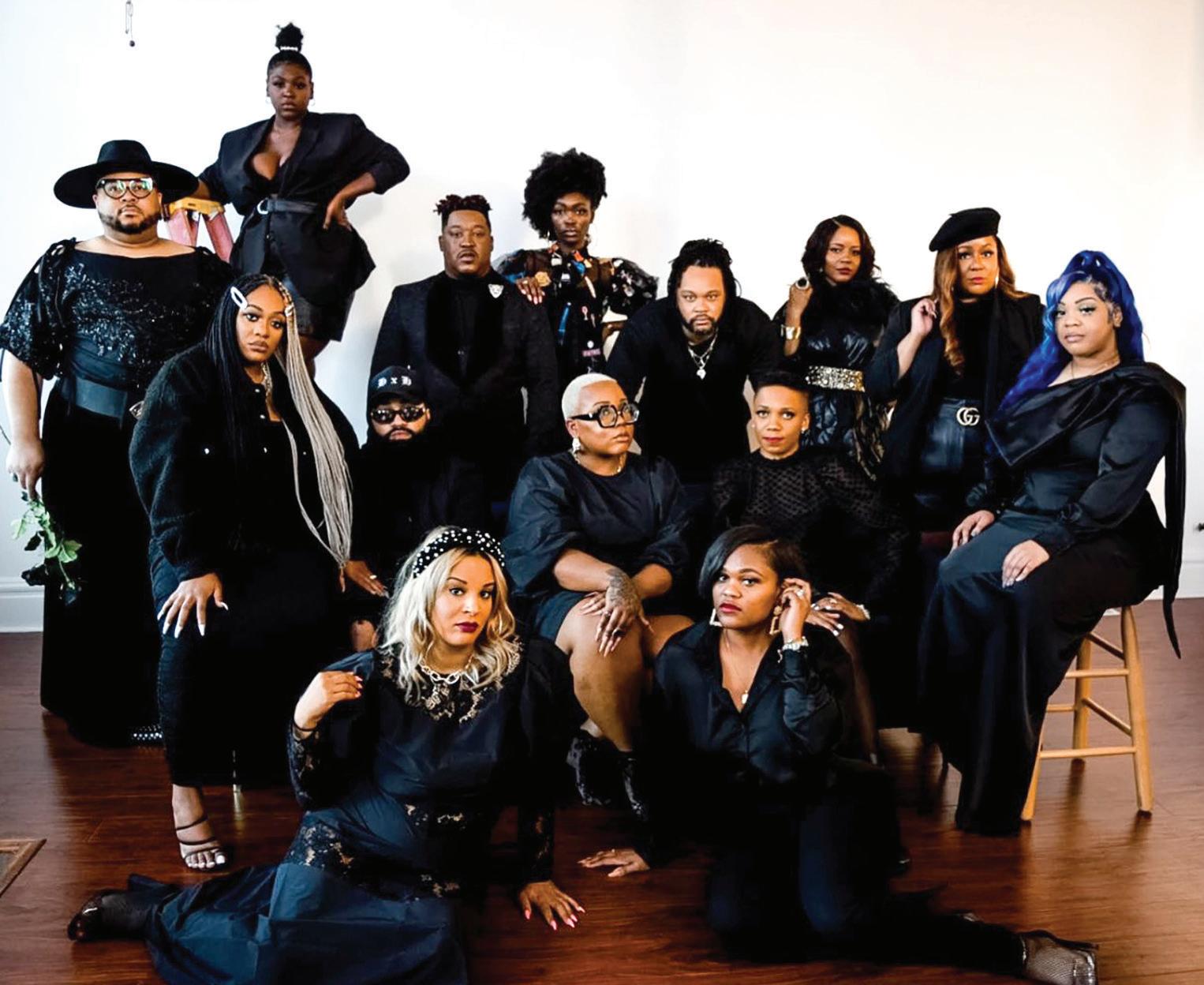
By Danielle Brown
Of the St. Louis American
It’s no secret Los Angeles and New York are among the world’s top fashion cities, known for setting trends and pushing the style envelope.
One might wonder how St. Louis, a midwestern city with more than 300,000 residents fits into the global fashion conversation.
Beginning in the late 19th century until the end of World War II, the city was recognized for being a garment manufacturing hub. During that era, Washington Avenue was called “Shoe Street USA” for having multiple shoe stores along the street.
The mid-1950s saw a significant increase with the number of clothing manufacturers after the creation of junior’s clothing, which originated on Washington Avenue.
After WWII, the country suffered due to production companies relocating overseas because of cheaper labor costs. A new wave of technology, imports and the development of cost-efficient superstores resulted in the decline of the St. Louis fashion district.
AK Brown, 29, professional fashion stylist and blogger, is on a quest to reshape the district and provide more diversity amongst Black creatives in the process. The first step in the right direction for her would be for all professionals to receive their own individual shine rather than everyone being lumped in together.
“We cannot throw in a montage of other people in a big diverse effort or throw one or two Black people in with a whole bunch of white people,” Brown said. “No, we need our own celebrations, spotlights, highlights because fashion and style come from Black people.”
Last November, Brown launched her Black in STL Fashion project with a photoshoot spotlighting 25 creatives including herself, who she felt deserved noteworthy praise for their contributions in the industry.
“I was just thinking in my head if I can get this to take off to start, I can continue featuring other dope creatives and provide resources to them, so they can keep doing amazing things, and we can create a community.” Brown said.
Brandin Vaughn, of Brandin Vaughn Collection, was one of the notable people Brown invited to be part of the series. As a Black man in the industry, he felt it was imperative for him to be involved with the project since he knows firsthand how challenging it can be to break into fashion.
“Like Issa Rae said, if you’re Black I’m rooting for you, especially if you’re Black in fashion

courtesy of Mar’vette Gee
AK Brown, fashion stylist, blogger, and influencer plans to revitalize the city’s historic Garment District with her Black In STL Fashion project.
because we need to have our voices heard in the fashion industry.” Vaughn said. “It’s time for us to stand up for our culture and really represent who we are in the fashion industry.”
His plans for restructuring St. Louis’ fashion scene are by providing designers the necessary resources they need in expanding their brand and becoming more inventive with their ideas.
“I feel like it’s my job to ask companies what they offer local
n Last November, Brown launched her Black in STL Fashion project with a photoshoot spotlighting 25 creatives including herself.
Black up-and coming fashion entrepreneurs,” Vaughn said. “It’s about connecting the dots and finding resources that can help us all move forward and level up.” Brown brings social media attention to Black in STL Fashion with a community Facebook group; Facebook page, https:// www.facebook.com/blackinstlfashion/; and Instagram page https://www.instagram.com/
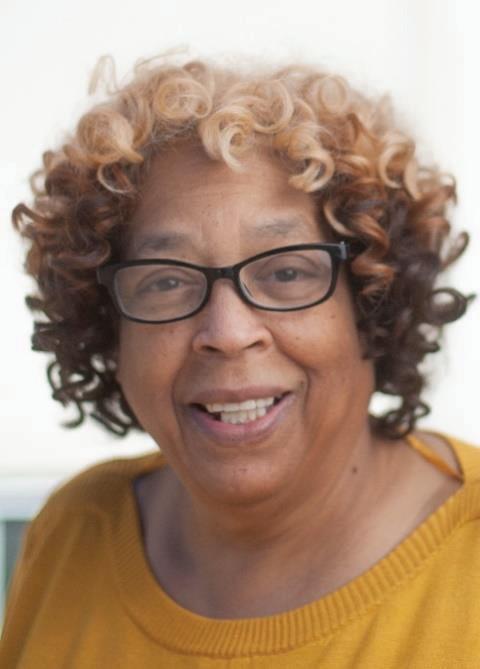
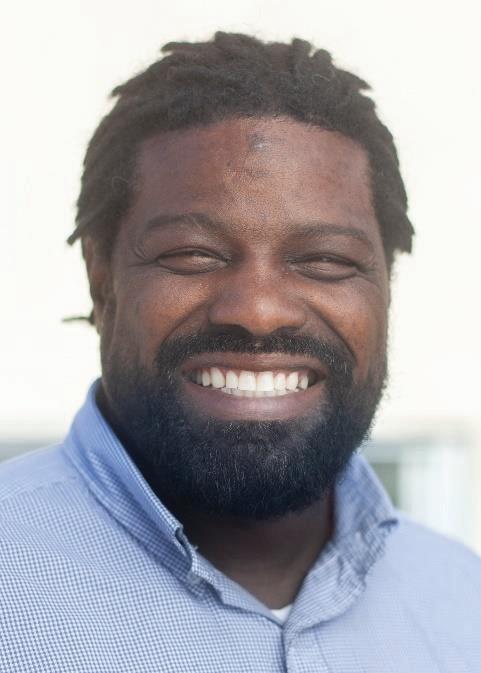

blackinstlfashion/. She plans to have another photoshoot, much bigger with 75-100 Black fashion professionals. Her goal is to turn the project into a nonprofit. In the meantime, she will continue to publicly praise and highlight “dope” Black creatives in fashion via her social media channels and her personal website.
“This is for my people, for the fashion creatives in the city,” Brown said. “I want to highlight them because I have not seen other people or other groups in the city up until now do that specifically for our Black fashion creatives.”
Brown, a fashion stylist, blogger, influencer, and owner of the clothing line LA1962 is a 2010 Kirkwood High School graduate with an associate and bachelor’s degree in fashion merchandising and retail management from Stevens-The Institute of Business & Arts. She received her master’s in communications with an emphasis in promotions from Lindenwood University. She has been featured in XoNecole, Fashion Bomb Daily, Ellements Magazine, Voyage ATL, St. Louis Magazine, Ladue News, and Delux Magazine.
To read more about Brown visit https://www.akbrownstl. com/.


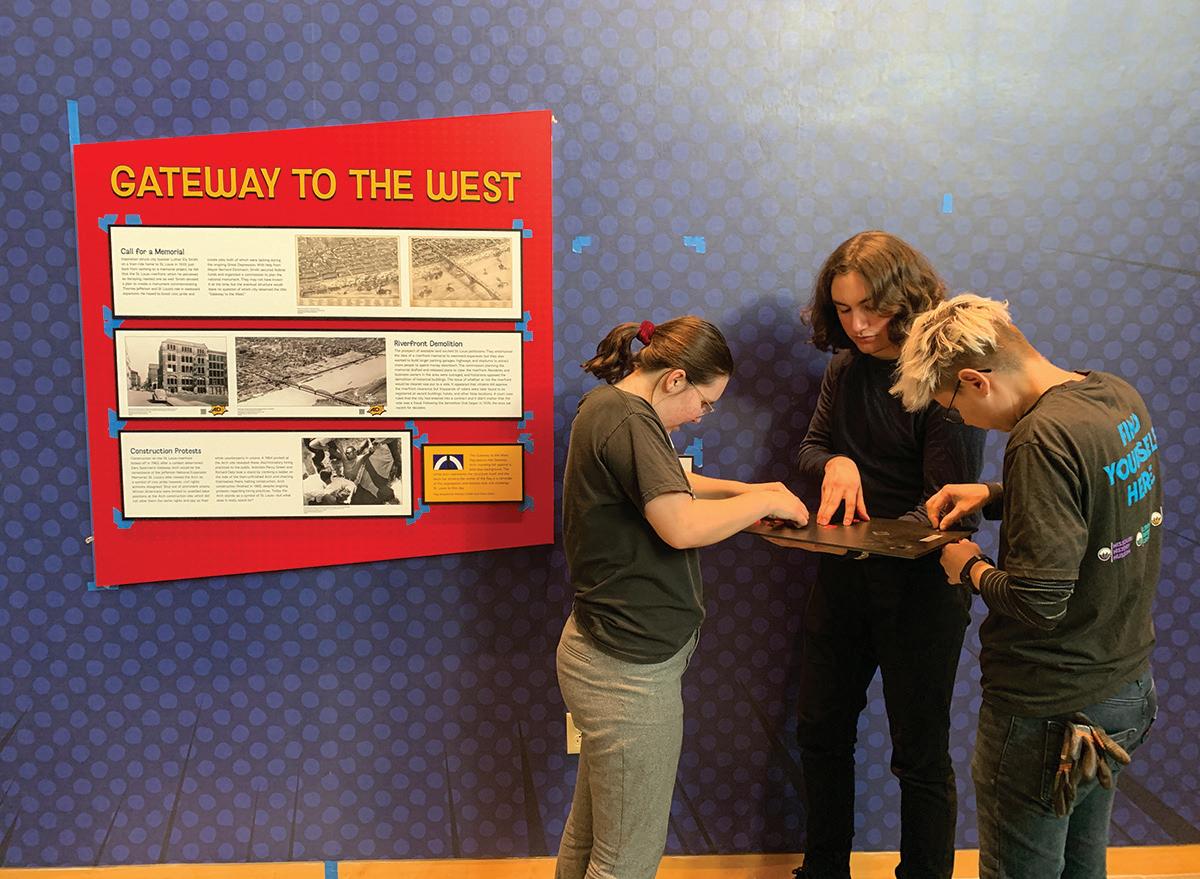
TMH Exhibitors Marley Gardner and Indigo Amunategui assist a preparator during the installation of What’s in a Name? at the Missouri History Museum in February 2020.
By Indigo Amunategui, TMH Exhibitor
Teens Make History (TMH) is a paid, part-time job for local teens at the Missouri Historical Society (MHS). It starts with the TMH Academy, which introduces teens to the museum field.
When my mom told me about the TMH Academy, I almost didn’t apply. I thought it would be too much work. But I filled out the application anyway, and when the Academy started, I loved it! I looked forward to our meetings and projects. I especially enjoyed the exhibits week and chose to make another exhibit for my capstone project.
After the Academy I decided to continue with TMH as an Exhibitor, working on projects like curating exhibits and collecting oral histories.
As an Exhibitor my favorite project has been working on the Missouri History Museum Atrium exhibit What’s in a Name?, which focuses on seven nicknames for St. Louis and explores what they say about the city.
When I joined TMH in 2019, the Exhibitors had already been researching What’s in a Name? for two years, but there was still plenty of work to be done. My fellow Exhibitors and I looked through diaries, books, and photographs at the Library & Research Center. We wrote the exhibit’s labels, collaborated with an exhibit designer to create its look, and even helped install panels. We promoted the exhibit by writing posts for the MHS blog, historyhappenshere.org, that expanded on
stories featured in the exhibit, such as Logan Uriah Reavis’s 19th-century campaign to move the US capital to St. Louis and the 1939 demolition of the St. Louis riverfront to make space for the Arch grounds. We also planned a St. Louis pride–themed poetry workshop and open mic night in collaboration with UrbArts.
To me, the most important part of TMH is that it has enabled me to do meaningful museum work. When I entered TMH, I had no idea that I would be doing anything like making an actual museum exhibit. That seemed like something only people with graduate degrees or PhDs could do, not just some nerdy teen. But here I was actually making history, just like the program name says.
What’s in a Name? opened to the public in February 2020. By the time it closes in April 2022, it will be the longest-running Atrium exhibit ever! We Exhibitors are especially proud that What’s in a Name? is the first Atrium exhibit to feature Audio Description, which makes visual exhibit content accessible to people who are blind or have low vision. We wrote and recorded the Audio Description for five images.
Continuing with our focus on accessibility, the Exhibitors recently collaborated with the MHS director of accessibility to draft guidelines for in-person and online events and programs, which required us to research best practices to ensure that the Museum does its best to accommodate everyone. I personally learned a lot and gained a new appreciation for the importance of accessi-
bility, and I find myself applying what I have learned to my everyday life.
One major benefit of joining TMH is teamwork. As a homeschooled student, working in a group is not something I am used to and is even something I used to dread. Now I am much more comfortable working in a team environment and taking initiative when needed, and I actively enjoy working on a project with people who have similar interests. My verbal communication skills have also improved, as we are constantly talking with and presenting ideas to other Museum employees.
As a high school senior, the skills I have learned in TMH definitely came in handy during the college application process, especially with writing essays. Although I plan on majoring in fashion design, I am seriously considering double majoring or at least minoring in history. I have always liked history, but since joining TMH I have fallen in love with the museum world and can see myself working in this field in some capacity.
I cannot recommend TMH enough. The program provides fulfilling museum work that I love, and I look forward to every day that I work with my team. I feel more connected to my community than ever, and I believe this experience has truly changed my life for the better.
Applications for the 2021 Teens Make History Academy are open now! Learn more about the program and apply at mohistory.org/tmh-academy.





By Andrea Y. Henderson St. Louis Public Radio
On a biweekly virtual conference call in early March, Bishop Lawrence Wooten of Williams Temple Church of God in Christ in St. Louis asked county health officials to use churches to help bring the COVID-19 vaccines to predominantly Black neighborhoods in north St. Louis and St. Louis County.
Wooten recommended a few worship facilities and recreational sites, because the county executive specifically asked him to help get more African Americans in North St. Louis information about the vaccine and registered for the shot.
“We have the highest death rate from coronavirus of all ethnic groups,” Wooten said.
“The Black community is the one that has been hit the hardest.”
County have signed up for the vaccine.
That’s the part of the county with the highest percentage of Black residents.
“We are most vulnerable and that’s why we need it the most,” Wooten said.
County health officials attribute the low registration rates to lack of access to vaccine information and transportation to vaccination sites. Wooten is working with other Black clergy in the area to bring faith-based vaccine messaging to the community.
n “My biggest concern is that people will drag their feet in getting it. And for me, it is very crystal clear,” Burton said. “It’s life or death. We’ve had people die.”
Not only are African Americans seeing high death rates from the virus, but Black communities across the country are also seeing low vaccination sign-up rates compared to other groups. And to encourage Black communities to get the vaccine, Black clergy across the country are leading the efforts.
In most of St. Louis County, about 20% of residents are pre-registered through the health department. But only 9% of people in North St. Louis
He is also working to get more Black clergy vaccinated, which he believes will encourage pastors to talk to their congregants during online or in-person services about getting the shot themselves.
The Rev. Rodrick Burton of New Northside Missionary Baptist Church in St. Louis has been discussing the importance of the vaccine during Bible study and Sunday services since early this year.
Burton wants his predominantly Black congregation to know the severity of the virus and that the vaccine can help save lives.
“This is so important,” said Burton, who pastors a congregation of about 500. “I’m still going to talk about it every service to get the people prepared so that they understand and just get it in their mind.”
He opens services with prayer, a
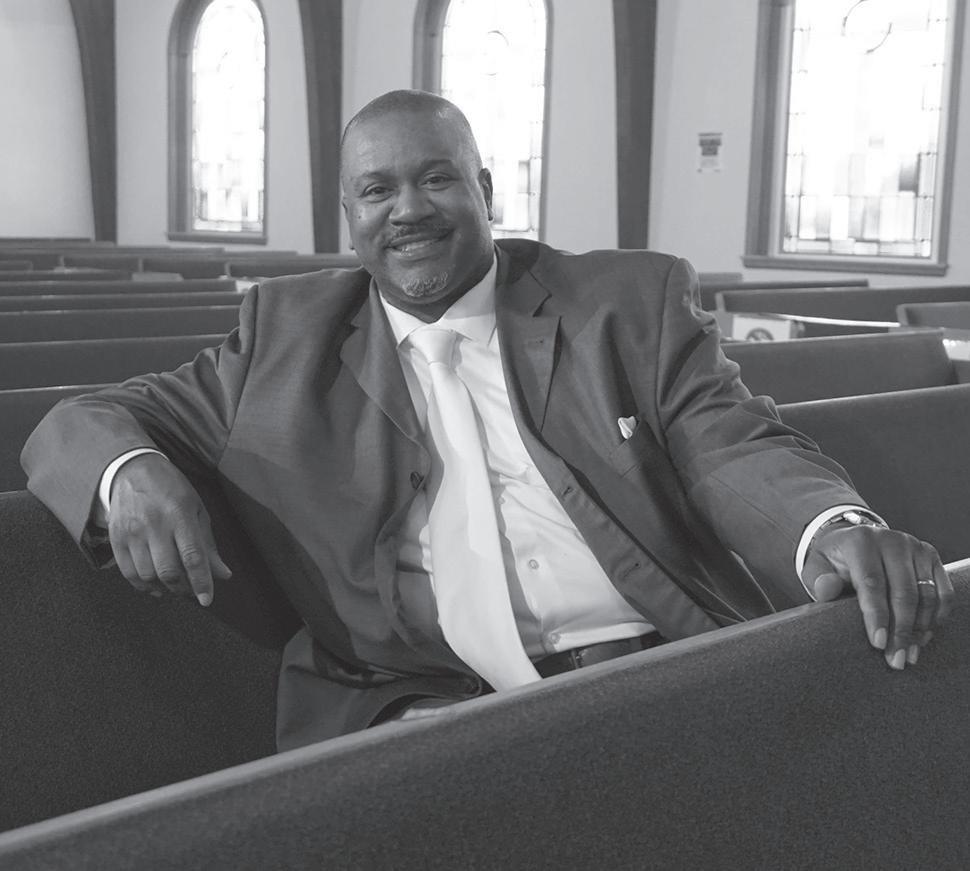
conversation about the shot and what the Bible says about how Jesus uses people and medicine today to heal. But Burton is still concerned that Black people will be left behind in the vaccine rollout.
“My biggest concern is that people will drag their feet in getting it. And for me, it is very crystal clear,” Burton said. “It’s life or death. We’ve had people die.”
Burton has seen some positive effects from his vaccine messaging. Some of his members have already

signed up for the shot and others have already gotten it. His congregation’s media team now produces weekly Facebook Live conversations to educate people on the virus and to get them pre-registered for vaccination.
One of his congregation members, Juliette Hughes, was nervous about taking the shot at first. But her pastor’s encouragement as well as her own conversations with community doctors convinced her to get the vaccine.
“I was one of those people with conspiracy theories in my head at
The Rev. Rodrick Burton has been discussing the importance of vaccines during Bible Study and Sunday Services at his predominantly Black church.
Andrea Henderson / St. Louis Public Radio
first because we all go back to the Tuskegee experiment and other things throughout history,” Hughes said. Hughes says she came to the realization that she would rather get the shot than take a chance of catching the virus and becoming severely sick or even dying.
“People were dying at an alarming rate just in the community,” Hughes said. “When I had people that I knew personally who passed from that, that was basically it for me.”
Now that she is vaccinated, Hughes feels empowered to talk to others about the importance of the vaccine. She also helps host the church’s weekly Facebook vaccine conversation.





By James A. Washington
This is not new, but I heard a sermon that gave me a different perspective on the subject of the ultimate liar. I’m sure you too have heard a minister or two state quite emphatically that the devil is a liar. Not only does he specialize in deceit, but he also has insight into what weaknesses you and I have; particularly when it comes to our vulnerabilities in faith matters. That voice within which causes us to resist God’s Word and accept for the moment the joys of sin, I liken to Adam and Eve in the Garden of Eden. Belief in the devil’s lies is a catalyst for our destruction.
We know what we’re supposed to do. But it’s difficult. You know the drill. Harden not your heart when you hear the Word of God. But then here comes all of those things that tempt you to do the exact opposite. The voice that is causing the resistance is that of Satan. Be careful when this happens, because according to the Bible, you will then be in dangerous waters. “Some people are like seed along the path, where the Word is sown. As soon as they hear it, Satan comes and takes away the word sown in them.” Mark 4:15.
The point I’m making is that recognition is a most powerful attribute. If you can only see that you’re being fooled, or used or manipulated, then most of us would react accordingly. Emotionally, we all have at

one time or another, responded vehemently when recognition allowed us to see we’ve been made a fool of by someone else. For the perpetrator, it’s not a pretty sight. But you see, the devil doesn’t always show his hand the way God shows His. Remember the devil is a liar and specializes in presenting situations and circumstances that make you not think of him as the reason your life is going to hell. “And no wonder, for Satan himself masquerades as an angel of the light. It is (therefore) not surprising, then, his servants masquerade as servants of righteousness…” 2 Corinthians 11:14-15. So, let’s take a look at this thing and realize when Satan is hard at work in your life, it is probably at a time when you are most likely trying to be true to your faith. The Bible says watch out, because it is at these times that so called supporters, advisers, friends and even family show up to “help” us, “comfort” us, “guide” us in a way that appears consistent with our efforts to follow the Word of God. In reality, if we can only see the devil at work, then
it’s pretty easy to make the right choices. But the devil is so cunning that at the moment of truth, he sees to it that we blame others, rationalize our actions, defend our sin and otherwise fault life for what we have total control over i. e., our actions. In the name of everything but Satan, we can explain away all of those things we do that virtually ensure our place in hell. Rarely do we permit ourselves the time and thought necessary to recognize Satan is doing his best to damn our souls to hell. Rarely, if ever, will we give the devil his due for enticing us into the activities that we regretfully remember on the morning after. If we did, then the Word of God would have been heard during the chaos in our lives and truly light our way on the night before. At some point, how we live should become second nature to why we live. When we understand the “why” of life, the “how” becomes easier. “Be careful then, how you live, not as unwise but as wise, making the most of every opportunity, because the days are evil. Therefore, do not be foolish, but understand what the Lord’s will is.” Ephesians 5:15-17. The key is recognizing the difference between God’s Word and Satan’s whispers. It’s those whispers and who’s in your ear ‘that’ll get ya every time.’ May God bless and keep you always.
We have something new to cover in the St. Louis prep sports scene that has never happened before; which is spring football.
No, we are not in Texas or Florida, where they do have spring football. We have spring games going on right here in the St. Louis area. Due to the Covid-19 pandemic, several schools decided to punt on the traditional fall football season and move their games to the spring.
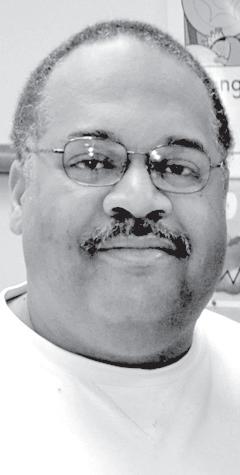
Most of the action is taking place in North County and the city. This week, we will take a look at some of the top players in spring football on the Missouri side of the river.
Next week, we will highlight the top players on the Illinois side as the metro east schools are also playing football in the spring.
Charles Johnson (Pattonville): A junior running back who has rushed for 358 yards and four touchdowns in leading the Pirates to a 3-0 record. He is averaging nearly six yards a carry.
Logan Williams (Pattonville): A senior dualthreat quarterback who has rushed for 224 yards and three touchdowns and passed for 425 yards and four touchdowns in leading the Pirates to a 3-0 record.
Hasaan Cody (Jennings): A versatile junior two-way performer who has rushed for 193 yards and four touchdowns while also passing for
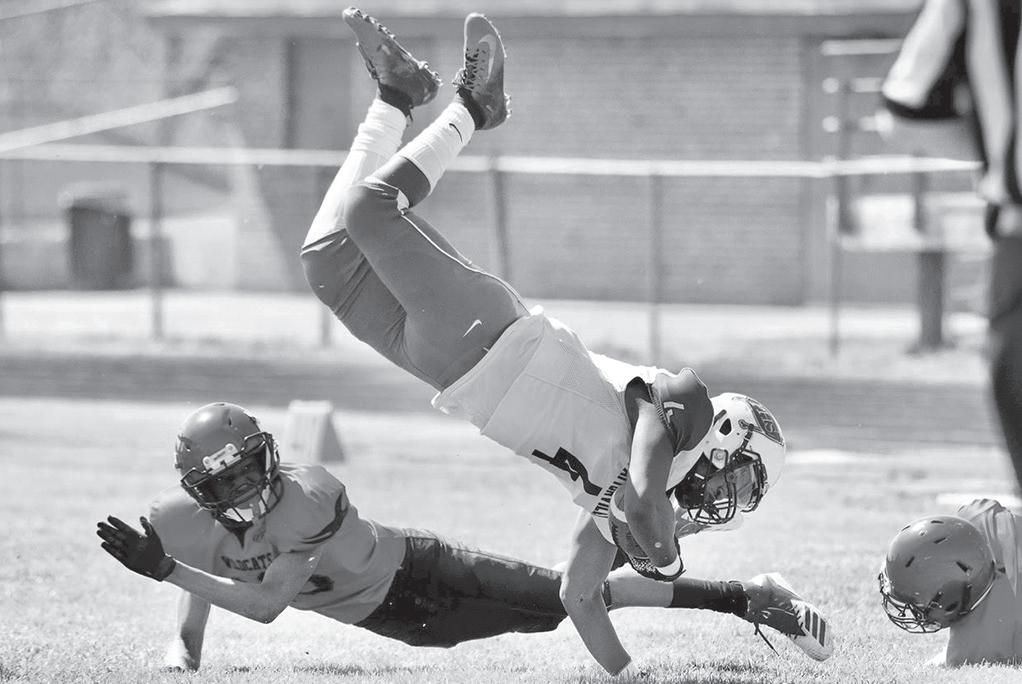
186 yards and one touchdown. He also has two interceptions as a defensive back while also scoring a touchdown as a kick returner.
Michael Hopkins (McCluer): A junior quarterback who has completed 31 of 51 passes for 500 yards and two touchdowns in three games to lead the Comets to a 2-1 record.
Dennis Keyes (McCluer): A junior wide receiver who has 17 receptions for 255 yards and two touchdowns in the
Comets’ three games.
Lionel Banks (Hazelwood Central): A junior running back who has rushed for 276 yards and four touchdowns for the 2-1 Hawks.
Armon Hill (Hazelwood East): A junior two-way talented performer who has scored a team high three touchdowns on offense while also having a team-high 21 tackles on defense.
Marcellous Griffin (Ritenour): A senior dual-threat quarterback who has rushed for
192 yards and five touchdowns while also throwing five touchdown passes. John Clay (Brentwood): A talented sophomore running back who has rushed for 299 yards and scored six touchdowns in the Eagles’ two games.
SLU Women make WNIT Quarterfinals
Congratulations to the Saint Louis University women’s basketball team on achiev-
ing a very successful season despite battling many obstacles. The Billikens had their season paused on three different occasions due to Covid-19 protocol, yet still managed to put together a 14-5 record and finish third in the Atlantic-10 Conference.
SLU also earned a berth in the WNIT where it won two games and advanced to the quarterfinals.
Junior guard Ciaja Harbison earned All Atlantic 10 First Team honors after
averaging a team-high 16.9 points a game. Junior forward Brooke Flowers, a former Metro High standout, earned Third Team honors after averaging 10 points and 10 rebounds while blocking a team-high 47 shots. Harbison and Flowers were also named to the WNIT All-Rockford Region Team. They were also selected to the All A-10 Defensive Team as well.
Sophomore guard Rachel Kent averaged 12.6 points a game while shooting 42 percent from 3-point range and 94 percent from the free throw line. Junior forward Myriama Smith-Traore was a strong presence inside as she averaged 9.1 points and 9.1 rebounds a game.
Lauryn Miller concludes career at UCLA
Former Kirkwood High basketball standout Lauryn Miller concluded a very solid senior season at UCLA as one of the Bruins’ most dependable players. The 6’1” Miller has started 46 of the Bruins’ last 47 games over the past two seasons on two NCAA Tournament teams. As a senior this season, Miller averaged 6.7 points, 4.6 rebounds and two assists in 25 minutes of action a game to help the Bruins to the second round on the NCAA Tournament. Miller was the St. Louis American Player of the Year in 2017 after leading Kirkwood to the Class 5 state championship during her senior year. The young lady has been a tremendous basketball player and a positive role model on and off the basketball court for young people to follow.
In response to “The Big Lie” pawned off by a lawfully deposed former president, the state of Georgia has passed several laws designed to reduce ballots cast by Black voters. It is not about voting integrity. It is about Black voter disenfranchisement.
The Major League Baseball All-Star Game is scheduled for July 13 at SunTrust Park in Atlanta. MLB Players Association President Tony Clark, who is Black, said this week that his organization is “very much aware” of Georgia’s shameful legislation and is willing to discuss moving the game.
diversity in organizations by the lack of not only Black players, but also Black executives in front offices.
Most MLB owners would rather have that other guy in the Oval Office rather than President Biden.
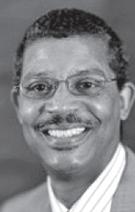
“We have not had a conversation with the league on that issue,” Clark told the Boston Globe last week.
“If there is an opportunity to, we would look forward to having that conversation.”
That conversation will be worthless. MLB will not move the game. Its leaders do not have to answer to Black players because less than 9 percent of them are African American. There are just two Black managers, Dave Roberts of the world champion L.A. Dodgers and Dusty Baker with the Houston Astros.
Individual franchises annually prove there is no concern for
Unless a bounty of young Black players has break-out first-halves of the season, only a handful of Black players will be on the respective American and National League rosters. Clark, and Black players, must now convince Latino and white stars to boycott the AllStar Game if it remains in Atlanta. The pleas must begin today – Opening Day – and must be shared with the world. Roberts, who would guide the National League All-Star team, said skipping the game is an option.
“I will certainly consider (boycotting the game),” Roberts told reporters during a spring training press conference last week.
I don’t know enough about it right now. But when you’re restricting, trying to restrict American votes, American citizens, that’s alarming to me to hear it. As we get to that point and we know more, I will make a better decision. But I do think that if it gets to that point, it will certainly be a decision I

have to make personally.”
FORBES columnist
Terrence Moore, a longtime beat reporter and columnist who covered the Atlanta Braves, tells Roberts, “You can stop debating, and you can begin triggering a revolt among baseball executives, on-field personnel and players against holding this event in (Georgia.)”
“Imagine if you convinced your star player Mookie Betts to skip the game, (the game’s highest-paid player) on his way to the Baseball Hall of Fame,” Moore writes.
“Imagine if more prominent Black players joined Betts in this boycott such as Aaron Judge, Tim Anderson and David Price.
“Imagine if they triggered
their peers to do the same, regardless of nationality, whether we’re talking about (former MVP) Mike Trout or (Braves star) Ronald Acuna.” MLB will not move the game unless Roberts, Black players and key white and Latino players make the necessary moves to force a change of venue. Even then, I doubt MLB will act – but the game must then be played absent of a Black manager and many Black, white and Latino stars.
The Reid Roundup The St. Louis Cardinals will open the 2021 season with three Black players on the 25-man roster. Joining starting pitcher Jack Flaherty are closer Jordan Hicks and 25-year-old outfielder Justin Williams. Williams recorded his first MLB hit last September… Congratulations to Black head coaches Kelvin Sampson of Houston and Juwan Howard of Michigan for leading their respective teams to
•



The City of Clayton is hiring for a full-time Police Officer or Police Officer in the Academy. Apply by 4/16/21: https://claytonmo.applicantpro. com/jobs/ EOE

EOE
St. Martha’s Hall is seeking a part-time Women’s Advocate to support and empower women as they work to build a new life, free from violence. Using a trauma-informed lens, the position works directly with women and children in shelter and over the phone to provide crisis intervention, community referrals, basic necessities, and help maintain a safe environment. Hours are Fridays, 3:00pm-11:30pm and Saturdays, 7:00am-3:30pm. Preference given to applicants interested in working both these days, but will consider applicants interested in one shift only. Bachelor’s degree in a related field is preferred but not required. Knowledge of women’s issues and the dynamics of
and
ST. LOUIS UNIVERSITY HIGH SCHOOL MATH TEACHER
This is a full-time position in the Math Department. Candidates should have a bachelor’s degree, high school teaching experience, and be able to demonstrate readiness to contribute to St. Louis University High’s rigorous college preparatory curriculum. Master’s degree and state certification preferred.
Interested candidates must submit a cover letter and resume online. Priority will be given to submissions received before April 30, 2021. https://sluh.aaimtrack.com/jobs/
The City of Jennings is accepting applications for Code Enforcement Inspectors, Deputy Building Commissioner, Correctional Officers, Public Works Street/Park Laborers, Court Clerk, Accounting Clerk, Finance Director, P/T Clerks, Recreation Center Administrative Assistant, P/T Bus Driver, P/T Concession Stand Workers, P/T Umpires, & P/T Scorekeeper. Please see the full job descriptions on our website at www. cityofjennings.org. Applications are available at the Jennings City Hall or on the website. The City of Jennings is an equal opportunity employer. All applicants will be considered for employment without attention to race, color, religion, sex, sexual orientation, gender identity, national origin, veteran or disability status.

The City of Richmond Heights is accepting applications for Firefighter/Paramedics. To apply go to https://richmondheights.applicantpro.com/jobs/ . Applications will be accepted from March 29, 2021 through April 9, 2021.
Supervisory position responsible for housing quality standard inspections HQS of occupied and vacant dwellings participating in the Housing Choice Voucher Program HCV. Ensures and enforces compliance requirements established by HUD, provides responsive customer service to landlords and tenants, prepares various reports, studies, and monitors work of subordinate staff and contract workers. Must have a High School Diploma or equivalent. Required knowledge, skills and abilities for this position; 2 years at an accredited college or university in a related field and/or 5 years’ experience and/ or training in Building/Housing Inspections including 2 years of supervisory experience in a related field. Previous experience in federally assisted property management, HUD HCV programs or real estate is highly desirable. Must possess HQS Certification or be able to obtain within twelve (12) months of employment. Starting Salary $55,000 Annually. Position will be opened until filled. Apply or send resume to: St. Louis Housing Authority, HR Division, 3520 Page Blvd., St. Louis, MO 63106 or via our website www.slha.org or email athomas@slha.org. A Drug Free Work Place/EOE
United Way of Greater St. Louis is hiring! Check out www.helpingpeople.org for opportunities and next steps. Come work with us!
Great Rivers Greenway is a seeking full-time Project Manager who likes a team environment and making the St. Louis Region a better place for all. Go to www.greatriversgreenway.org/ jobs-bids and submit.
The City of
is hiring for a
Paramedic. Apply by 04/09/21: https://claytonmo. applicantpro.com/jobs/ EOE
Blessed Teresa of Calcutta Catholic School in Ferguson is seeking qualified teachers to join our PK-8th school community in the content areas of early childhood preschool and kindergarten, third grade, and junior high for the 2021-22 school year. Interested candidates should send a cover letter, resume, and references to agovero@btc-school. org and complete the Archdiocesan application process at https://www.archstl.org/education/ applications-and-instructions
Andy’s Seasoning is seeking a full-time HR Generalist/ Administrative Manager. Candidates must have at least five years of HR experience and one to two years of supervisory experience. An HR certification is preferred but not required. This position is posted on ZipRecruiter. For more information about the position and to apply, please click on this link: https://www.ziprecruiter.com/ jobs/andys-seasoning-fc0ae93b/ hr-generalist-administrativemanager-502f1f99
Andy’s Seasoning is an Equal Opportunity Employer.
ASSISTANT COURT ADMINISTRATOR/ CHIEF JUVENILE OFFICER
Full time position at the St. Louis City Family Court Juvenile Division includes full benefit package, plus no cost retirement plan detailed info at www.stlcitycircuitcourt.com, click employment opportunities.
EOE

ST. LOUIS COUNTY DEPARTMENT OF HUMAN SERVICES
The St. Louis County Department of Human Services received from the United States Department of Treasury
$29,735.926 for the Emergency Rental Assistance Program. The ERAP funds will be used to provide assistance to eligible households that have difficulty making timely rent and utilities payments due to the COVID-19 pandemic. As of March 29, 2021 the ERAP Call Center (314) 806-0910 is operating Monday through Friday 8:00 a.m. – 5:00 p.m. CST. Online applications are available April 5, 2021 @ https://stlouisco.onlinepha. com or http://stlcorona.com
Eligibility Criteria
Households are eligible for Emergency Rental Assistance provided through the COVID-19 relief package if they meet the following criteria:
1) One or more individuals qualified for unemployment benefits or experienced a reduction in household income, incurred significant costs, or experienced other financial hardship directly or indirectly due to the pandemic;
2) The household can demonstrate a risk of homelessness or housing instability; and
3) Household income is below 80% of their area median income (AMI).
Legislative and Government Relations Consulting Services
St. Louis, Missouri
The City of St. Louis Port Authority will receive Sealed Proposals on 4/22/2021 For more Info. Visit https:// www.stlouis-mo.gov/ government/departments/ sldc/procurement/index.cfm
K&S Associates, Inc. is soliciting MBE/WBE/SDVE/DBE/VBE for the following project for Apr-May, Greensfelder Recreation Complex Renovation (REBID), South Farm-Swine Research Facility (REBID) University of Missouri, Columbia and Normandy HS West Hall Interior Improvements-Plans and Specs can be viewed at www.ksgcstl.com-submit bids to estimating@ksgcstl.com or Fax 314-647-5302
The following people are in debt to Gateway Storage Mall of Belleville. The contents of their storage unit(s) will be sold at auction to compensate all or part of that debt. Auction at the Royal Heights location will be held online with www.storageauctions.com on April 13, 2021 at 10:00 AM. A cash deposit will be REQUIRED for all winning bids.
Bel. E07 – Michael Anthony, Bel G11 – Demario/Sheila(mom) Dugan Auction at the Mascoutah location will be held online with www.storageauctions.com on April 14, 2021 at 10:00 AM. A cash deposit will be REQUIRED for all winning bids.
Bel. 620 – Cathy Maldonado, Bel 530 – Charles Sterling For all rules, regulations and bidding process, please contact www.storageauctions.com . All other questions, please call 618-233-8995 or mail 17 Royal Heights Center, Belleville, IL 62220.
Bids for Repairs to Exterior & Parking Lots, Troop G Headquarters & Crime Lab, Project No. R2008-01, will be received by FMDC, State of MO, UNTIL 1:30PM, 4/29/2021 via MissouriBUYS. Bidders must be registered to bid. For specific project information, go to: http://oa.mo.gov/ facilities
Bids for Repair Firepit Lake Dam, Jay Nixon State Park, Project No. X2006-01, will be received by FMDC, State of MO, UNTIL 1:30 PM, 4/27/2021 via MissouriBUYS. Bidders must be registered to bid. For specific project information, go to: http://oa.mo.gov/ facilities
St. Louis Catholic Academy is requesting bids to operate its food service program for the 2021-2022 school year. St. Louis Catholic Academy serves breakfast, lunch, and snacks to approximately 185 students. Meals are served Monday thru Friday, and follows the USDA Federal School Lunch guidelines set by DESE. Interested companies must attend the pre-bid conference held via Zoom on April 20, 2021 at 1:30 p.m. Zoom Login information-Meeting ID: 797 7962 1898 Passcode: i8k97uK Proposals will be due on Friday, June 4, 2021. The school is located at 4720 Carter Ave, St. Louis MO 63115. You may contact the principal, Sandra Morton at (314) 389-0401 or morton@slca-stl.org
Bids for Roof R e p l a c e m e n t , Albany Readiness Center, Project No. T2001-01, will be received by FMDC, State of MO, UNTIL 1:30 PM, 4/29/2021 via MissouriBUYS. Bidders must be registered to bid. For specific project information, go to: http:// oa.mo.gov/ facilities
Bids for New Comfort Station, Missouri State F
F2102-01, will be received by FMDC, State of MO, UNTIL 1:30 PM, 4/8/2021 via MissouriBUYS. Bidders must be registered to bid. For specific project information, go to: http://oa.mo.gov/ facilities
ST. LOUIS COMMUNITY COLLEGE
The St. Louis Community College is requesting submittals of Indefinite Qualifications from Architectural/ Engineering and Technical Consulting Services for Fiscal Year 2022 for St. Louis Community College. Submittals of the Consultant’s qualifications will be received by St. Louis Community College, in the Engineering and Design Department until 2:00 p.m., May 7, 2021, at 5464 Highland Park Drive, St. Louis, MO 63110-1314. The scope of architectural/engineering services and consulting agreement procedures may be obtained from the Manager’s office, at the above address or by calling (314) 951-9897
An Equal Opportunity and Affirmative Action Employer
The St. Louis Economic Development Partnership requests proposals from qualified firms to repair asphalt parking lots at two business incubator locations in St. Louis County: (1) 1100 Corporate Square Drive, St. Louis, MO 63132, and (2) 743 Spirit 40 Park Drive, Chesterfield, MO 63005. Services may include excavation, base repair, milling, adding rock, overlay, curb repair/ replacement, asphalt paving, sealing, and striping, as needed. A copy of the complete RFP with equipment specifications is available at https:// stlpartnership.com/rfp-rfq/. A five percent bid preference may be available to certified MBE firms. To be considered, proposals must be received no later than 3:00 PM CST on Friday, April 23, 2021.
REQUEST FOR PROPOSALS (RFP)
Service: Weather Advisory Services
Pre-Proposal Meeting Date: April 13, 2021 Meeting will be held via teleconference. See RFP for details.
Question Due Date: April 16, 2021
Proposal Due Date: May 5, 2021
M/WBE Goals & Incentives:
MBE goals: 25% WBE goal: 5%
A 15% M/WBE incentive credit shall be applied to the evaluation of professional service prime contracts who are currently certified MBE-African American, Hispanic American, Asian American, Native American and WBE-Women owned Business Enterprises.
Point of Contact: Gigi Glasper – gxglasper@flystl.com
Proposal documents may be obtained at St. Louis Lambert International Airport, Airport Properties Division, Monday through Friday between 8:30 a.m. and 5:00 p.m., or by calling (314) 890-1802. This RFP may also be obtained by visiting our website at www.flystl.com/business/contract-opportunites
Robert Salarano Airport Properties Division Manager
INTERNATIONAL AIRPORT
REQUEST FOR PROPOSALS (RFP)
Service: Fuel Systems Maintenance Services
Pre-Proposal Meeting Date: April 05, 2021 Meeting will be held via teleconference. See RFP for details.
Question Due Date: April 7, 2021
Proposal Due Date: April 28, 2021
M/WBE Goals & Incentives:
Native American and WBE-Women owned Business Enterprises.
Point of Contact: Briana Bryant– bnbryant@flystl.com
Proposal documents may be obtained at St. Louis Lambert International Airport, Airport Properties Division, Monday through Friday between 8:30 a.m. and 5:00 p.m., or by calling (314) 426-8174. This RFP may also be obtained by visiting our website at www.flystl.com/business/contract-opportunites Robert Salarano Airport Properties Division Manager CITY OF ST. LOUIS ST. LOUIS LAMBERT INTERNATIONAL AIRPORT
ST. LOUIS COMMUNITY COLLEGE
St. Louis Community College will receive separate sealed bids for CONTRACT NO. F21 301, Renovations to Create Office Suite and Study Space at St. Louis Community College at Wildwood Campus, until 2:00 p.m. local time Thursday April 8, 2021. Bids will be publicly opened and read aloud at the office of the Manager of Engineering and Design, 5464 Highland Park, St. Louis, MO 631101314. Specifications and bid forms may be obtained from the Manager’s office, at the above address or by calling (314) 644-9770.
An Equal Opportunity and Affirmative Action Employer
PREBID: March 30, 2021 at 10:00am, Wildwood Commons Area
ST. LOUIS COMMUNITY COLLEGE
St. Louis Community College will receive separate sealed bids for CONTRACT NO. F21 602, Roof Replacement at Communications Building at St. Louis Community College at Meramec Campus, until 2:00 p.m. local time Thursday April 8, 2021. Bids will be publicly opened and read aloud at the office of the Manager of Engineering and Design, 5464 Highland Park, St. Louis, MO 63110-1314. Specifications and bid forms may be obtained from the Manager’s office, at the above address or by calling (314) 644-9770.
An Equal Opportunity and Affirmative Action Employer
PREBID: Monday, March 29, 2021 at 10:00 am at the Communication South Building at Meramec Campus
ST. LOUIS COMMUNITY COLLEGE
St. Louis Community College will receive separate sealed bids for CONTRACT NO. F21 603, Lecture Hall Renovation at St. Louis Community College at Meramec Campus, until 2:00 p.m. local time Thursday April 12, 2021. Bids will be publicly opened and read aloud at the office of the Manager of Engineering and Design, 5464 Highland Park, St. Louis, MO 631101314. Specifications and bid forms may be obtained from the Manager’s office, at the above address or by calling (314) 644-9770.
An Equal Opportunity and Affirmative Action Employer
PREBID: March 31, 2021 at 2:00pm, Meramec Lecture Hall Building

LETTING #8725
EOC/AOC HOST SPACE REMODEL PROJECT PHASE I AT ST. LOUIS LAMBERT INTERNATIONAL AIRPORT
Sealed proposals will be received by the Board of Public Service in Room 301 City Hall, 1200 Market Street, St. Louis, Mo. Until 1:45 PM, CT, on Tuesday, April 27, 2021, then publicly opened and read in Room 325 City Hall. Plans and Specifications may be examined on the Board of Public Service website http://www.stl-bps.org (BPS On Line Plan Room) and may be purchased directly through the BPS website from INDOX Services at cost plus shipping. No refunds will be made.
Bidders shall comply with all applicable City, State and Federal laws (including MBE/ WBE policies). Mandatory pre-bid meeting will be held on Tuesday, April 6, 2021 at 1:30 PM via Zoom Meeting.
Password: 917736
Phone one-tap: US: +16465588656,,85127458210# or +13017158592,,85127458210#
Meeting URL: https://flystl.zoom.us/j/85127458210?pwd=SkxQOVNWc1RYTWwydWpnT2VlMHh5Zz09
Join by Telephone
For higher quality, dial a number based on your
Continued from B1
police officer in May of 2020.
“I was in elementary school when Mike Brown was killed but I remember not understanding why we are judged by skin color at all. It made me upset and sad,” Kennedy said. “When it happened again with George Floyd, it gave me flashbacks to 2014. The racism and stuff hit me really hard.”
Kennedy credits Tyler White, the director of the summer arts program and the Black Rep staff for encouraging students to
discuss challenging issues like police brutality. Those conversations, she said, were crucial for her:
“They talk to us about how to stay safe and how to interact with police. Some of my Black Rep friends are really into those issues. I am, too, now. But talking about it helped a lot.”
Learning the art of acting has changed how Kennedy watches television programs and movies. She’s not thinking about becoming a director or set designer at this time but now she’s aware of the intricacies involved with making movies and TV shows; like lighting, set designing and visuals. She’s a big fan of actress Keke Palmer and actress
n “They talk to us about how to stay safe and how to interact with police. Some of my Black Rep friends are really into those issues. I am, too, now. But talking about it helped a lot.”
- Kennedy Jenkins
Elizabeth Olsen, of Marvel’s “WandaVision” and movies from the Marvel Universe.
Kennedy has acted in the end-of-the-summer Black Rep production students put on for families and friends. She’s
presence. “Tina” deeply personal highs and lows of her life and career are told through firsthand accounts, archival footage and interviews. Unlike the feature film “What’s Love Got to Do with It,” the documentary provides a bit of grace for Ike Turner without diminishing the terror Tina Turner endured during their marriage.
“Tina” generously gives Ike Turner the credit he is due as a rock music pioneer – a fact often overshadowed by his abusiveness towards his former wife. “Tina” also effectively illustrates how being forced to revisit the abuse created another tier of trauma for Tina Turner to overcome. But more than anything, “Tina” reveals just how epic and unprecedented her ascension from battered wife, to lounge singer to superstar truly was. As a goddess of rock music
perspective on Black music and history.
“NMAAM is complete,”
Continued from B1
the many music genres created, influenced, and inspired by African Americans.
The 56,000-square-foot institution contains more than 1,500 artifacts, objects, memorabilia, and clothing from Black artists.
Complete with state-of-theart technology, the museum contains seven galleries.
Each is designed to share a different narrative and a unique
NMAAM President and CEO H. Beecher Hicks III declared in a news release. On Feb. 23, Hicks appeared on the National Newspaper Publishers Association’s “Let It Be Known, Breaking News” broadcast to share insights on the new mixed-use downtown development at Fifth and Broadway.
“We have been preparing for this day for more than 20 years, but this museum has actually been more than 400 years in the making,” Hicks remarked.
who eventually became known as “The Queen of Rock n Roll,” she was a Black woman ruling what white men had laid claim to since Elvis Presley. Ironically, it is a genre her former husband pioneered with his 1951 record “Rocket 88.” She flipped the script on ageism in popular music. When “What’s Love Got to Do with It” reached the top of the Billboard “Hot 100,” Tina Turner became the oldest female solo artist to top the chart. She was 44 years old. She boldly owned and expressed her sensuality as
“We look forward to welcoming music lovers from around the world to this magnificent cultural experience.”
Because of COVID-19, a limited number of visitors currently are allowed inside the museum. Masks or face coverings are required for entrance, and guests are requested to remain socially distant, officials said.
Once the pandemic ends, tickets will be made available for purchase on the museum’s website for designated timeslots that allow for new tours to start every 30 minutes, museum
performed in the Black Rep’s plays “Freedom to Me” and “Keisha” and played the role of “Janie” in the 2019 Black Rep and COCA collaboration, “Four Little Girls: Birmingham 19632019.”
Kennedy, who’s up for playing comedy or serious roles, is attracted to crime shows. She’s trying to better her game at emoting and projecting in serious roles. She believes “Ms. Tyler” has homed in on her aspirations. During a recent class exercise, Tyler singled Kennedy out for a role of a mother whose child had just been gunned down. “It was like screaming and yelling and stuff,” Kennedy recalled. “I’d never done anything like that before and I kept messing up. Finally, Ms. Tyler said, ‘Kennedy, I want you to do this but if you can’t, I can give it to someone else’.”
“I knew she was trying to
she sold out stadiums around the world – and blazed the screen of “Mad Max Beyond Thunderdome” opposite a young Mel Gibson. In doing so, she also became a blueprint for the ageless female sex symbol. Had it not been for the 1984 release of her album “Private Dancer,” J. Lo, Mary J. Blige, Madonna, Halle Berry and countless others would have most certainly been unceremoniously forced into retirement as “women of a certain age.”
In everything Tina Turner
officials determined.
Displays at the museum include interactive exhibits and such iconic items as “Lucille,” the guitar played by B.B. King, and a kimono worn by Alicia Keys.
Captured in a film overview at the museum’s “Roots Theater,” are the traditions of West and Central African cultures before slavery.
The Rivers of Rhythm Pathways, the “central spine of the museum experience that features touch panel interactives and an animated timeline that links American history and


push me. So, when she said that, I got it right. I had to go deep down but I was really proud of myself that day.” Kennedy is going deep in her desired profession. She’s already looking to enroll in a historically black college or university that offers acting courses. She said aspiring to the life of a thespian is helping her navigate the perilous worlds of COVID-19 and police brutality and so much more: “Acting gives me hope in times like these. I’m focused on how great I can be as an actress. I’m taking this time to perfect myself and work on my creativity.”
did, St. Louis influence was never far. It was once again made clear in “Tina” as she stood before her largest crowd, 186,000 Brazilians. Just after the pyrotechnics sizzled with “Tina Live In Rio,” she opened the 1988 show –part of her Break Every Rule World Tour – with her rendition of “I Can’t Stand the Rain.” The song was co-written and originally recorded by Kinloch native Ann Peebles. In addition to the “trauma to triumph” experience that unfolds, St. Louis audiences will see “Tina” and be inspired to wonder, “If Tina Turner can contribute to the canon of music and culture in such an unprecedented and extraordinary way based on a talent she honed and cultivated right here, then what can I do?” Or better yet, “What can’t I do?” “Tina” is currently streaming on HBO Max and on HBO On Demand for subscribers. The film has a running time of 118 minutes.
American music history,” officials described on the museum’s website. A “Wade in the Water” gallery may prove popular among visitors as it explores African hymns.
The gallery connects African cultures’ religious music and later African American spirituals and hymns, including highlighting Mahalia Jackson, Shirley Caesar, Thomas Dorsey, and others.
The “Love Supreme” gallery dives deep into the history of jazz and explores the careers of legends like Ella Fitzgerald,
Duke Ellington, John Coltrane, and others. The “One Nation Under a Grove” gallery relays Motown Records and Soul Train’s stories, while “The Message” gallery explains the origins of hip hop.
“We hope visitors will enjoy learning about the expansive roster of ground-breaking artists who have influenced some of today’s biggest hit-makers,” said Allen Schrott, senior director of Music Products for TiVo/ Xperi, a museum partner. For more details about the museum visit www.nmaam.org.


By Maurice Allen, Mortgage Banker Commerce Bank Mortgage
You’ve decided it’s time to buy a home. Perhaps it’s your first house — or maybe you want a bigger place to accommodate your growing family, a dedicated area for remote learning — or you need a home office. You may even want to downsize or relocate to a new area. Interest rates are historically low, which is the good news. But home inventory is low, too, which means there are currently more buyers than sellers. So how can you find and purchase your dream home in today’s competitive seller’s market?
Being prepared and being ready to act fast are keys to success when buying in a seller’s market. These six tips can help put you in the best position to get your offer accepted.
Get preapproved. A preapproval letter is documentation from a mortgage lender stating that you’ve been approved for a loan, and sharing the amount you’ve been qualified to borrow for a mortgage. Getting preapproved for a loan puts you in a stronger position when you’re ready to make an offer on a home by giving you more credibility with the seller.
To preapprove you for a mortgage, your potential lender will need to verify your monthly income and available down payment amount.
Start house hunting. Make and prioritize a list of your wants and needs so you can decide in advance which features you can (and can’t) live without, such as number of bedrooms, commute time or willingness to make home improvements. Knowing where you’re not willing to compromise will help you zero in on the right homes to view.
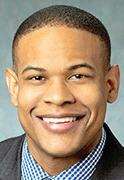
Next, be ready to look at homes as soon as new listings appear, especially if you’re interested in a specific area or a highly desirable location (such as a top school district). Keep your schedule open and plan tours as soon as a home becomes available.
Make your best offer first. “The biggest challenge facing homebuyers right now is housing stock,” explains Eric Nelson, Mortgage Product Manager at Commerce Bank. “Sellers are getting multiple offers, so it’s important to put in your best offer first,” he adds.
Consider offering above asking price if you have your heart set on a specific house, but make sure it’s an offer you can comfortably afford. Keep in mind that mortgage loans are based on a home’s appraisal. If your accepted offer is above the home’s appraised amount, you’ll have to make up the difference with your own out-of-pocket funds.
Other ways to help your offer stand out include writing a personalized letter to the seller, explaining why their house means so much to you. You may also want to consider adding an escalation clause to your offer, which gives you the chance to be the highest bidder if a larger bid comes in after your initial offer.
Consider more earnest money. In a seller’s market, offering more than the standard amount of earnest money shows the seller you’re a serious buyer and could put you at an advantage when the seller is considering multiple offers. Research typical earnest money amounts for your area. For example, if it’s $5,000, consider offering $10,000.
Keep contingencies to a minimum. A
simple, straightforward offer means less stress for the seller, and that makes you a more attractive buyer. “Make your offer more appealing by not asking for seller concessions, if possible,” says Nelson. “For instance, try to avoid making the offer contingent on selling your home.” In fact, you may want to sell your current home and move out before you start house hunting, so you don’t have that contingency attached to your offer.
“Also, ask yourself if you’re willing to make some renovations to the home to better fit your style, or if there are small repairs you can do yourself, instead of asking the seller to do them before you move in,” adds Nelson. Making renovations before putting your current home on the market may also help get it ready to sell quickly.
While it may be more challenging to find the home of your dreams in a seller’s market, it is possible with planning and preparation. For more information about mortgages and the preapproval process, talk to a Commerce Bank Mortgage Banker or visit https://www.commercebank.com/personal/borrow/mortgages/ mortgage-basics .

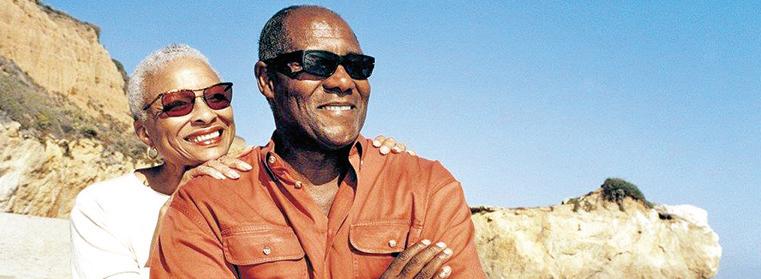
While market twists and turns may take you for a ride, it’s important to resist the temptation to jump off altogether. By proofing your portfolio to weather market ups and downs, you can guard against market losses, while keeping your money invested for growth.
2020 was more than just a health crisis, it had ripple effects on nearly every aspect of our lives, including our longterm financial plans.
Research from Lincoln Financial Group shows that personal finance concerns have intensified over the past year. Nearly half of Americans say they are preparing for the 2020 election’s impact on their investments and retirement accounts, and a vast majority have expressed a need for financial education to help them be better prepared for the future. As uncertainty continues amidst the ongoing COVID-19 pandemic, Americans’ hopes of a comfortable retirement are at risk.
“If you are nearing your retirement years, the events of this past year may have been especially concerning, and if you are rethinking your retirement plans altogether in light of 2020, you’re not alone,” says John Kennedy, head of Retirement Solutions Distribution at Lincoln Financial Group. “The good news is that with some smart steps and proper planning, you can set yourself up to feel more in control of your finances in the year ahead and for years to come.”
roadblocks and concerns, especially given today’s circumstances. Lincoln’s research shows that nearly a third of Americans agree that now is a good time to talk with one. They are well-positioned to help you consider a broad range of solutions that best address your individual needs and situation.
n Nearly half of Americans say they are preparing for the 2020 election’s impact on their investments and retirement accounts, and a vast majority have expressed a need for financial education to help them be better prepared for the future.
2. Protect your income. Your advisor may suggest diversifying your portfolio to include an annuity, which is a financial product that can provide you with protected income in retirement. Solutions like an annuity can help you feel better prepared to navigate volatility, protect the retirement savings you’ve worked hard for, as well as provide a legacy for loved ones.
“With annuities, you have options for both protected growth and income that can help you feel more secure that you can maintain your lifestyle in a down market,” added Kennedy.
For more resources and tips, visit www.lfg.com.
As you look ahead to a new year, it can be empowering to shift focus onto matters within your control. Proper finan-
Kennedy offers the following tips to pandemic-proof and own your financial outcome in 2021:
1. Talk with a financial professional. If you’re not already, consider talking to a financial professional about your goals,
3. Stay the course. New research shows that an unpredictable market concerns more people than actual investment losses. But while market twists and turns may take you for a ride, it’s important to resist the temptation to jump off altogether. By proofing your portfolio to weather market ups and downs, you can guard against market losses, while keeping your money invested for growth.
cial planning, along with strategies that offer protection and opportunities for growth, can help you feel more secure as you work toward your investment goals.


While refinancing can save you money, it isn’t free. Just as there are closing costs and associated fees with your current mortgage, there are related costs to refinance your loan.
With mortgage rates hovering near three percent, experts say there are still a number of homeowners who could benefit from refinancing. In fact, borrowers who refinanced in 2020 to lower their mortgage rate saved over $2,800 in mortgage payments annually, according to the latest Freddie Mac research.
“While today’s low mortgage rates have fueled a refinance boom, it’s been driven mainly by higher-income borrowers. With millions of borrowers eligible to refinance, lower- and middle-income borrowers who could stand to benefit the most from refinancing might be leaving money on the table,” says Sam Khater, Freddie Mac’s chief economist.
To determine whether refinancing makes financial sense for you, it’s essen-
tial to first understand the basics. Here’s what to know about the refinancing process:
• Understanding refinancing: When refinancing your mortgage, you are essentially applying for a new mortgage with the goal of securing a loan with better terms than your current one. Primarily, people refinance their mortgages for three reasons: to lower their interest rate, to switch from one product to another (i.e. switch from an adjustable-rate mortgage to a fixed-rate mortgage) or switch to a loan with a shorter term.
• Determining refinancing costs: While refinancing can save you money, it isn’t free. Just as there are closing costs
and associated fees with your current mortgage, there are related costs to refinance your loan. To get a sense of what refinancing could cost you, use Freddie Mac’s refinance calculator, which is available at calculators.freddiemac.com.
• Knowing your options: The refinancing option that is best for you will depend on your financial situation and goals. The most common option is to refinance the remaining unpaid balance on your mortgage. Through refinancing, you can improve your financial position by shortening your term or locking in a lower interest rate. Your lender will be able to discuss refinancing options with you and help determine the best solution for your situation.
• Closing your loan: Closing on your new loan is the final step in the refinancing process, a procedure that is almost identical to when you initially closed on your current mortgage. During closing, it’s important that you take your time to read all documents carefully and ask clarifying questions. Once all of the closing documents are signed, you will have a new loan.
For more information on refinancing, visit myhome.freddiemac.com.
Remember, even with today’s mortgage rates near historic lows, it’s important to carefully evaluate your situation and your home goals with a housing counselor or lender.
A new survey reveals that women are increasingly earning the title of “breadwinner” in their households.
The Wells Fargo survey found that over half of all partnered women reported greater or equal earnings to their spouse. And nearly one-third of millennial and Gen X women reported being the primary breadwinner -- one and a half times higher than women from the boomer and traditionalist generations. At the same time, younger women see more barriers in developing their financial skills. More than a third of millennial and Gen X women said they find financial concepts intimidating, and didn’t learn enough about finances while growing up. But there’s good news: as a result, more than three out of four say they’re taking charge and prioritizing the financial education of their children.
“Many families treat the subject of money as a private affair, leaving kids to grow up and learn money lessons the hard way. However, what you say – or don’t say – can have profound effects on how children handle their finances later,”
says Amy Jucoski, senior director of planning, Wealth & Investment Management, Wells Fargo. During Women’s History Month this March, encourage strong financial acumen among the next generation of breadwinners with these tips from Wells Fargo:
• Get started early: Introduce the concept of earning money to young children by talking about your job and what your salary pays for. Consider tying your child’s allowance to chores.

• Respect money: Demonstrate how small amounts of change saved in a jar
can add up to a large sum of money over time.
• Help set savings goals. Help your child figure out how long it will take to save for something they want. Give them an incentive to defer spending by matching their savings.
• Empower older children: Keep the lines of communication open, even after children enter adulthood. By doing so, you can help them avoid financial mishaps. If and when your child does make a poor choice, keep the conversation positive and productive. Help them make a plan to reset and rebuild.
• Be a role model: Set a good example for children of all ages by continuing to build on your own financial acumen.
“Our survey revealed that younger women are eager to learn and grow. In fact, four out of five women feel more comfortable during times of economic uncertainty when they have someone to talk with openly about money and finances,” says Jucoski, who adds that economic uncertainty often leads people to action in many areas of their lives and addressing their finances is one of them.
To expand your own financial knowhow, visit handsonbanking.org, an educational resource page offered by Wells Fargo featuring tips and advice topics like investing, retirement, debt and more. The site also features lesson plans and activities for kids.
“With more women taking on the role of breadwinner in their families, they’re well-positioned to prepare the next generation of women for financial success,” says Jucoski




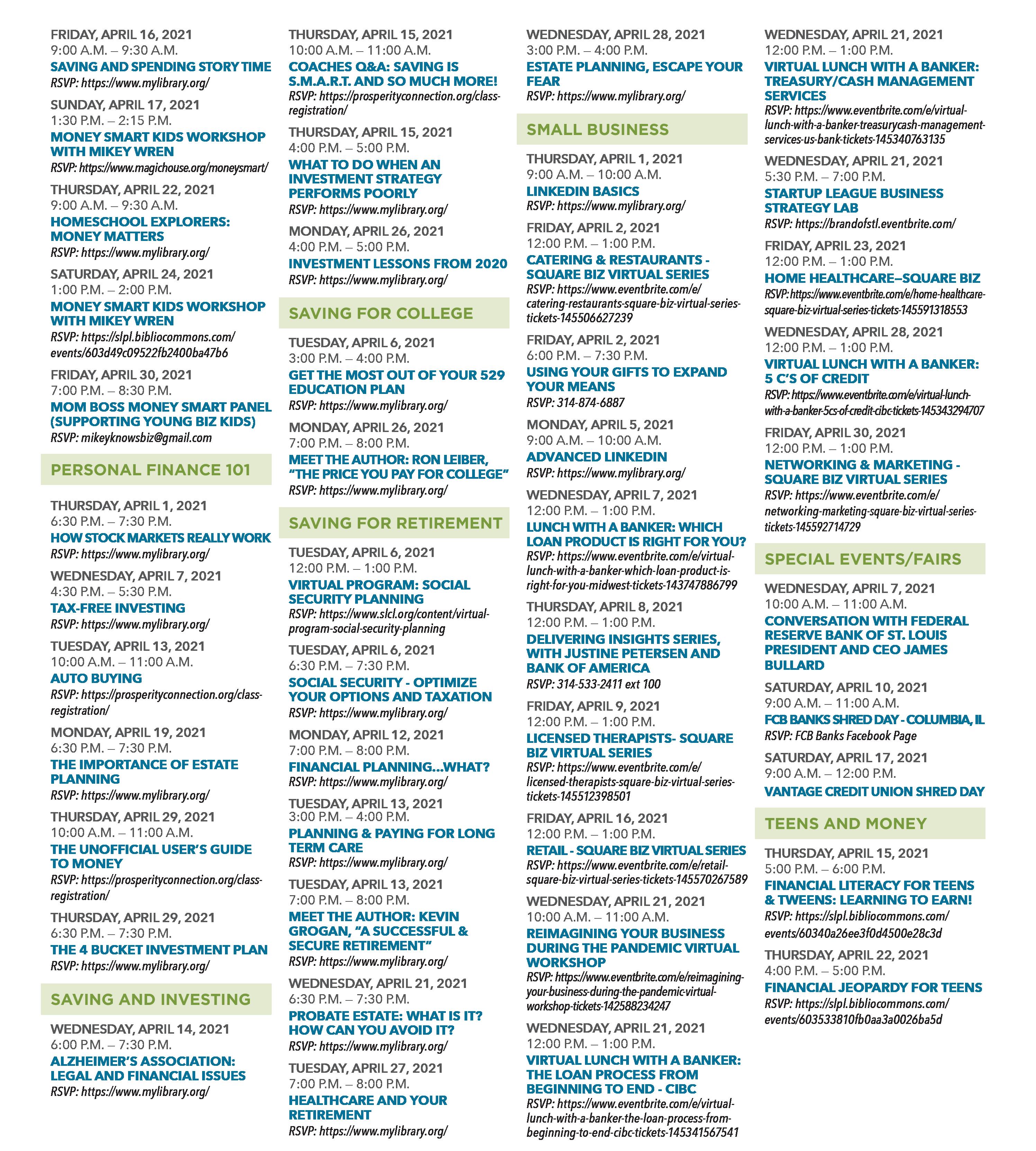

If you lost a job due to COVID-19 and received unemployment benefits, remember that income is taxable.
A year as unusual and challenging as 2020 means there may be some additional factors that can impact your tax return, from stimulus payments, potential job changes and unemployment benefits, to virtual work transitions and more.
“2020 was full of challenges, changes and plenty of uncertainty. While we’re optimistic for the year ahead, it’s important for Americans to understand how major life events, such as changes in employment or residence, can impact tax filing this year,” says Chad Prashad, CEO of World Acceptance Corporation, parent company of World Finance.
Having prepared approximately 84,000 returns last year, World Finance is offering tips to lessen tax season headaches this year, while helping you maximize the value and timeliness of your tax return.
• Make a plan and start early. Start by identifying how you’re going to file your taxes, such as through an online program or with the help of a professional expert. Gather all tax forms, such as W-2s from your employer or a 1099 form if you’re self-employed, relevant expense receipts, as well as statements from banks or other financial institutions. The quicker you get your taxes filed, the faster you’ll receive your return. Visit IRS.gov for the latest tax information.
• Check for tax credits and deductions. Due to the pandemic, you may have had to make major lifestyle changes, some of which could result in a tax credit or deduction that reduces your amount owed. The cost of setting up a home office, the purchase of a vehicle in lieu of
taking public transportation and childcare expenses are all examples of possible tax credits or deductions. Check out irs. gov/credits-deductions-for-individuals for a list of other deductions and possible credits.
• Consider additional COVID-19 impacts. If you lost a job due to COVID19 and received unemployment benefits, remember that income is taxable. The CARES Act also created provisions that could benefit your tax return, including allowing above-the-line deductions for donations to charity, waiving the penalty for early withdrawal from retirement accounts and more. Visit irs.gov/coronavirus-tax-relief-and-economic-impact-payments for more information.
• Work with a tax preparation service. Feeling overwhelmed? Working with a reputable tax preparation service partner can help you identify any additional deductions available and can add to your return. Some partners like World Finance even offer an interest and fee-free tax advance loan based on the anticipated value of your tax return up to $5,000, so you could receive payment the same day you file. Because they offer remote, in-person and drop-off options, filing is fast and convenient. To learn more, visit loansbyworld.com/taxes.
In an unusual year, filing taxes can come with additional stress and uncertainty. Following some simple tips can help ensure you secure the best possible outcome.
As a young person, I never understood the difference between income and wealth. And as a consequence, I didn’t truly grasp how you build wealth until I was in my early 30s. I bought my first house when I was 26 years old, and I remember the conversation with my agent and loan officer like it was yesterday. My wife and I struggled to come up with the 3% down payment that was required of our FHA loan. I later learned the difference: Income is what you earn, and wealth is what you own. Income can be converted into wealth over time by what you invest a portion of your earnings in. Over the course of the last 20 years, I have come to realize the importance of homeownership as a down payment to promoting wealth and shared prosperity for Black and Brown people.
Sadly, far too many of us will either be locked out or not learn how to overcome the barriers soon enough. The statistics related to home ownership paint a grim picture. The home ownership gap between white and Black Americans is
larger today than it was 50 years ago. In fact, the nearly 30-percentage-point gap between white and Black homeownership today is actually larger than the 27-percentage-point gap that existed in 1960 when housing discrimination was legal, according to Urban Institute data.
Homeownership is more than a place to live – it is about stepping into your dreams. It is the way most American families build financial security, especially Black families. On average, during the last quarter century, homeownership equity accounted for nearly half of Black and Latino wealth, compared to about a quarter for white families. The Federal Reserve reports that the average homeowner in 2016 had a household wealth of $231,400, compared to the average renter having a household wealth of just $5,200. Homeownership is about building generational wealth, and the growing racial homeownership gap has widened the wealth gap.
Today, 36 percent of all home buyers and about half of all African American
buyers are first-time buyers. Buying your first home can feel overwhelming, and barriers to homeownership make it even harder, especially for Black and Brown Americans. These barriers include:
A Down Payment – Saving for a down payment can be the biggest hurdle for renters wanting to become homeowners. Setting aside money each month can be unrealistic when that money is needed to pay for groceries, utilities, or to pay off other debt.
Your Credit Score – A less-than-ideal credit score can hold you back from many things: career goals, loans, credit card rewards, and so on. A place at the starting line should not be one of them.
Accessibility – There is a long history of systems that keep people with the greatest need from accessing reasonably priced capital, preventing them from pursuing dreams and achieving upward mobility. This can change when we all
demand more from each other and our financial institutions. This can change when we bank our values.
At Midwest BankCentre, we invest in people and their potential – not just credit scores. A values-led bank, we believe that every person, every business, every community deserves the right to DREAM BIG.
With historically low rates, now is the time to step into your dreams.
Let Midwest BankCentre work to earn your First Time & Forever MortgageTM business. Whether you are buying your first home, refinancing your current home, or building your dream home, we team up with you to help you select the best loan type for your family’s needs and budget.
Take the first step today. Call us at (314) 633-6060, visit our website at myhomeloanstl.com, or shoot us an email at newhomeloans@midwestbankcentre. com. We look forward to serving you.

